![]()


Links to:
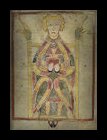 The known history of the Standish family begins at the end of the twelfth century, but in order to
get a clearer picture of the line of descent of the Standish family, it is necessary to refer back to the Norman Conquest of England.
The known history of the Standish family begins at the end of the twelfth century, but in order to
get a clearer picture of the line of descent of the Standish family, it is necessary to refer back to the Norman Conquest of England.
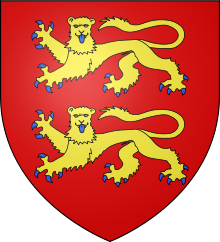
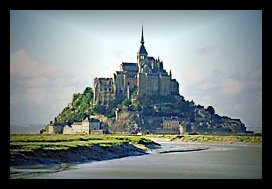
_svg.jpg) Mont Saint-Michel – Normandy – France.
Mont Saint-Michel – Normandy – France.
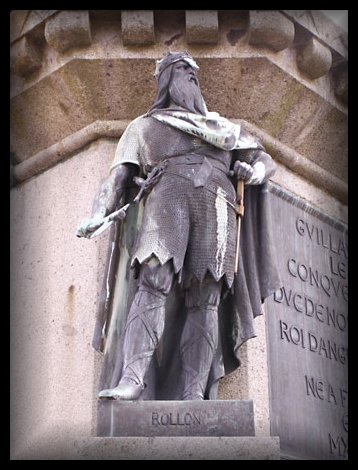
Early in the 10th century, Rollo’s Danish army attacked France, and Rollo established himself in an area along the Seine River. Charles III the Simple of France held off his siege of Paris, defeated him near Chartres, and negotiated the treaty of Saint-Clair-sur-Epte, giving him the part of Neustria that came to be called Normandy; Rollo in return agreed to end his brigandage. He gave his son, William I Longsword, governance of the dukedom (927) before his death. Rollo was baptized in 912 but is said to have died a pagan.
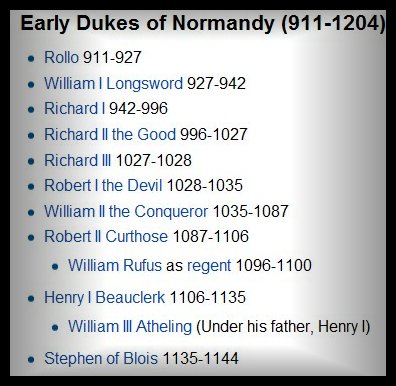
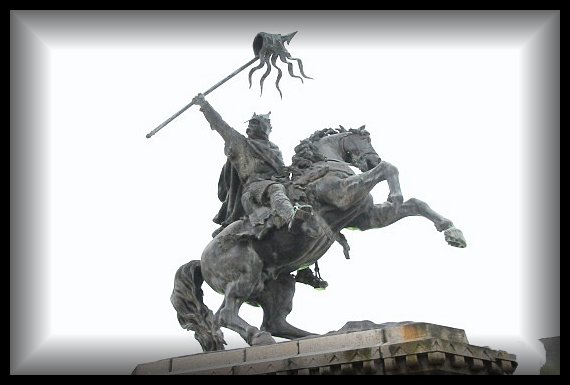
William, son of Robert, Duke of Normandy and Herleva of Falaise, was born in 1027 ..
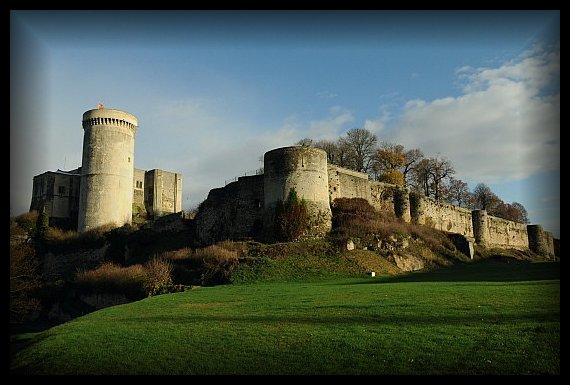
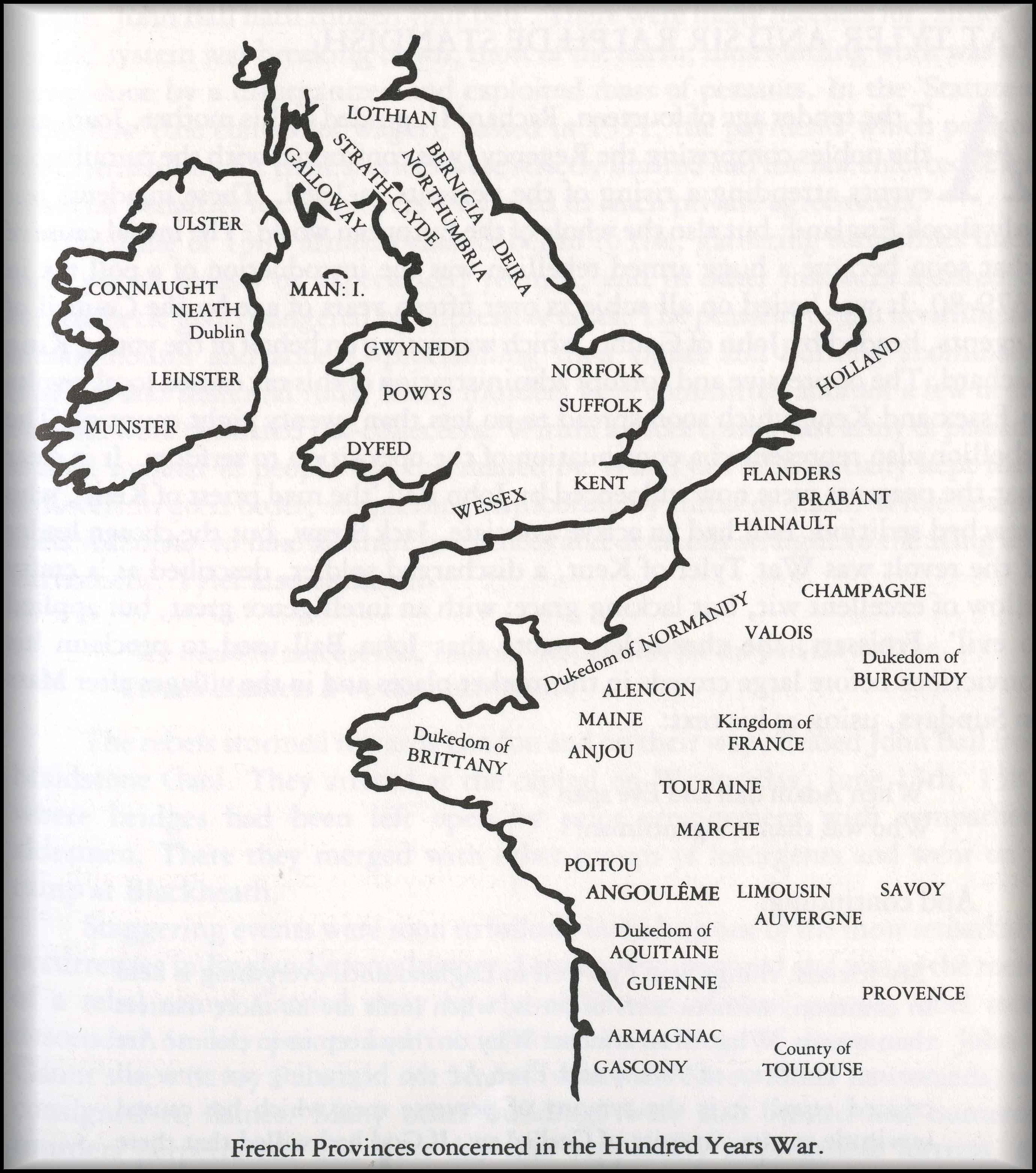
Matilda Countess Of Flanders - Queen of England
born about 1031 Flandres died 2 November 1083 Caen, Normandie buried Eglise De La Sainte Trinitâe, Caen, Normandie
Matilda's father: Baudouin V (Baldwin) Count of Flanders
born about 1012 Flandresdied 1 September 1067 Lille, Duchy of Lower Hainault
buried Lille, Duchy of Lower Hainault
Matilda's mother: Adáele (Alix) Princess of France - born 1003 France - married 1028 died 8 Jan 1079 Monastáere De L'Ordre De St. Benoist, Messines, France buried Monastáere De L'Ordre De St. Benoist, Messines, France.
Matilda - spouse (1st);
Gerbod de St. Omer of Flanders born about 1025 Flanders.
Matilda's children (from 1st marriage)
1, Gundred de Omer of Flanders Princess of England born
Normandy, France. died 27 May 1085 Castle Acre, Acre, Norfolk, England buried Priory, Lewes,
Sussex, England.
2. Gherbold the Fleming - Earl of Chester. born
Normandy, France.
Matilda - spouse (2nd):
Guillaume I "Le Conquâerant" De Normandie born 14 October 1024 Falaise, Normandie christened 1066 Norman Conquest as an Adult died 9/10 September 1087 Hermenbraville, Rouen, Normandie buried Abbaye de St. Etienne, Caen, Normandie married 1050 Castle Angi, Normandy, France.
Children of William and Matilda.
Cecilia Princess of England born about 1055 Normandy, France died 30
July 1126 Caen, Calvados, France
Adáele (Alice) Princess of England born about
1062 Normandie died 8 March 1135 Marsilly, Aquitaine buried Caen, Normandie.
Constance Princess of England born about 1061
Normandy, France died 13 August 1090 England buried St. Edmondsbury, Suffolk, England.
Mathilda Princess of England born 1059 Normandy, France died before 1112
Henry I "Beauclerc" King of England
born 1068 Selby, Yorkshire, England christened 5 August 1100 Selby, Yorkshire, England died December 1st 1135 St. Denis, Seine-St. Denis, France buried 4 January 1136 Reading Abbey, Reading, Berkshire, England.
Agatha Princess of England born about 1064 Normandy, France died before
1086 Calvados, France buried Bayeux, Calvados, France.
*William II "Rufus" King of England (Guillaume II de
Normandie) born about 1056 Normandy, France died 1 August 1100 (murdered) New Forest, Hampshire, England buried Cathedral St. Switen, Winchester, Hampshire, England.
Alice or Adâelaèide de Normandie born about 1057 Normandie died 1065
Robert II Prince of England born about 1053 Normandy, France died 10 February 1134 Cardiff, Glamorganshire, Wales buried St. Peters Church,
Gloucester, England.
Richard Prince of England born about 1054 Normandy, France died 1081 New
Forest, Hampshire, England

![]()
Busshell to Standish.
Regesta regum
anglo-normannorum, 1066 – 1154, records that Warin Busshell held lands in Normandy.
The Battle of Hastings, which took place on 14 October 1066, was the decisive Norman victory in the Norman Conquest of England. It was fought between the Norman army of Duke William II of Normandy and the army of King Harold II. The battle took place at Senlac Hill, approximately 6 miles northwest of Hastings, close to the present-day town of Battle, East Sussex.
Harold II was killed in the battle—legend has it that he was shot through the eye with an arrow. Although there was further English resistance, this battle is seen as the point at which William gained control of England becoming its first Norman ruler as King William I.
The famous Bayeux Tapestry depicts the events before and during the battle. Battle Abbey in East Sussex was subsequently built on the site of the conflict.
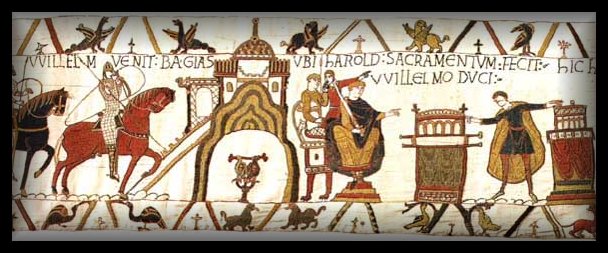
Bayeux Tapestry
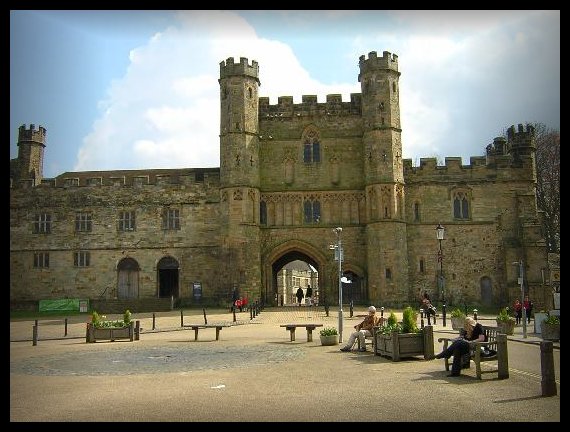
Battle Abbey in East Sussex
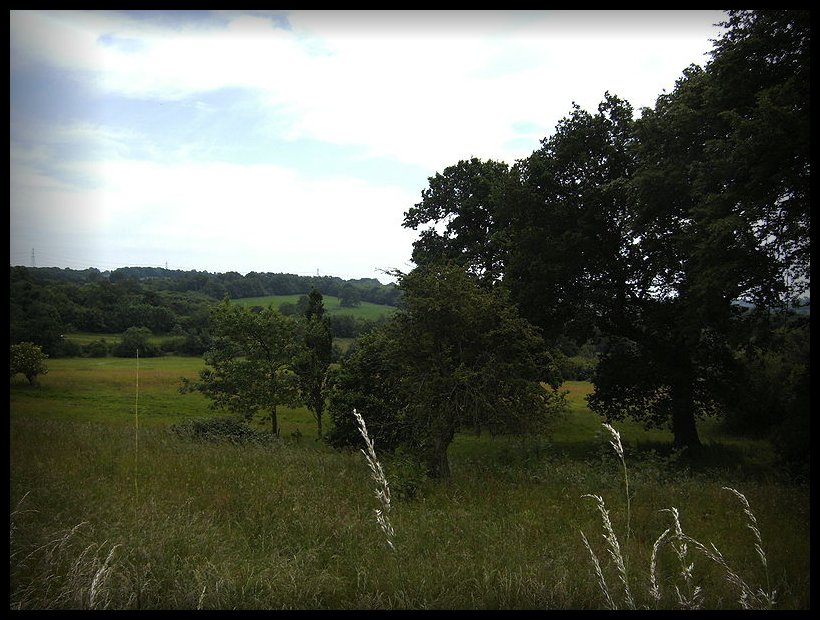
The battle field at Hastings from the north side - 2009.
o

The Names of the families that fought for Duke William of Normandy upon the battle field at Hastings.
The Busshell Family:
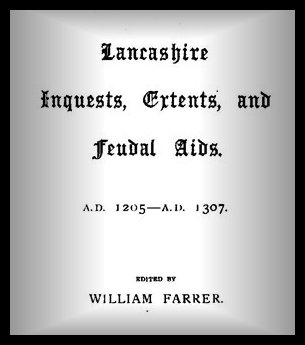
Busshell; Buscel; Busli; Bussel; according to Leland; Barons of Penwortham in the county of Lancaster. "Penwortham, the most northern of the parishes of Leyland hundred, contained one of the ancient castles of Lancashire, erected to guard the estuary of the Ribble when the channel of that river was wider than at present. It was bestowed by William the Conqueror on Roger de Busli, joint lord of the hundred of Blackburn, and the castle of Penwortham was one of the baronial residences of that favourite of his sovereign.
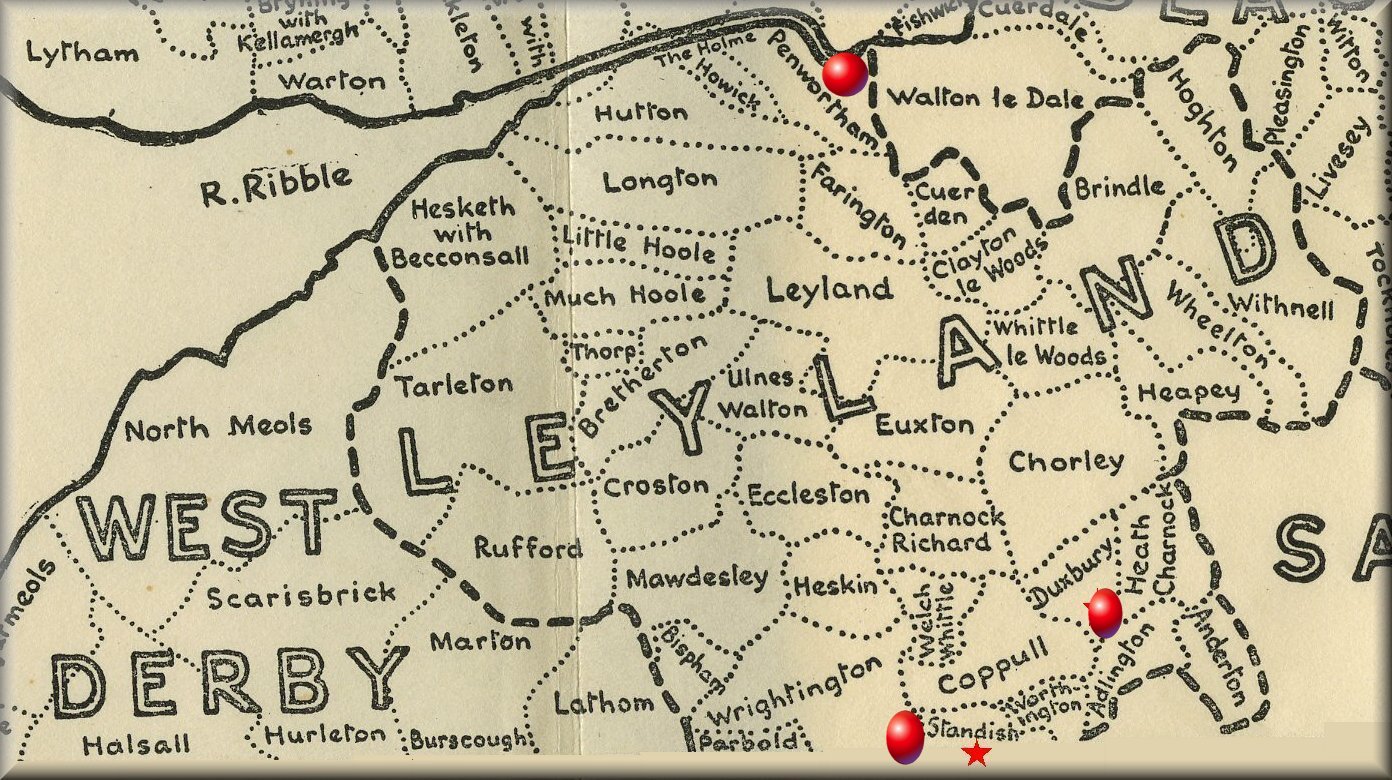
"Roger Bussel" is entered in the Domesday book as holding Sutton in Somersetshire. "This Roger," says Collinson, "was progenitor of the family of Bingham, who resided in this place, and gave it the addition of their name:" but why they called themselves Bingham he does not inform us. The Somersetshire line ended with an heiress in the time of Henry III.; but the family was of longer continuance in Devonshire. "Newton-Bushell was named from the Bushells, its possessors in the latter half of the thirteenth century. Teignweek was given in 1246 to Theobald de Englishville, and by him to his foster child and kinsman Robert Bushell.
The Bushells continued until Richard II., when their heiress brought it to the Yardes. Bradley has long been the seat of the Lords of Newton-Bushell, and although much mutilated, still remains an interesting example in many of its details of a fortified mansion in the 13th century."—Worth's Devon. Other branches of the Bushells existed in Dorsetshire, Warwickshire, Hertfordshire, Nottinghamshire, and Kent.Barons of Penwortham in the County of Lancashire.

1086. Warine Bussel held half a hide (3 carucates) of Roger the Poitevin in West Derby Hundred. The particulars are consistent with a feoffment of Kirkdale by Gaunt Roger to his knight, Warine Bussel I.
During the reign of William the Conqueror it is recorded that Warin Bussel conferred the manor of Penwortham and the Chapel of Mele with all its
appurtenances, on the Abbey of Evesham, It appears
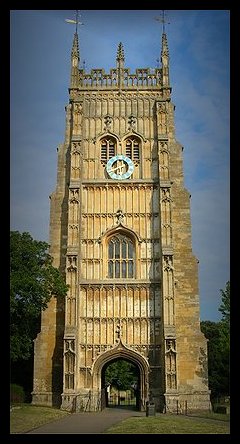
Evesham Abbey
Richard left only daughters, and "to him," says Dugdale, "succeeded by Albert his Brother: who had Issue - Hugh Bushell. According to Baines, Hugh's brother Robert, was the last and fifth baron of the name of Busshell. The principal branch of the family ended soon afterwards.
"Warin Busshell, the second of the name, had Robert Busshell of Leyland, whose heiress Amice was married in 14 Henry III. to John de Farrington." But some of his kin evidently survived; for Baines tells us that "Spout, in the township of Euxton, was formerly the residence of the Bushells; of whom was Dr. Bushell, the founder of Goosnargh Hospital in Lancashire England.
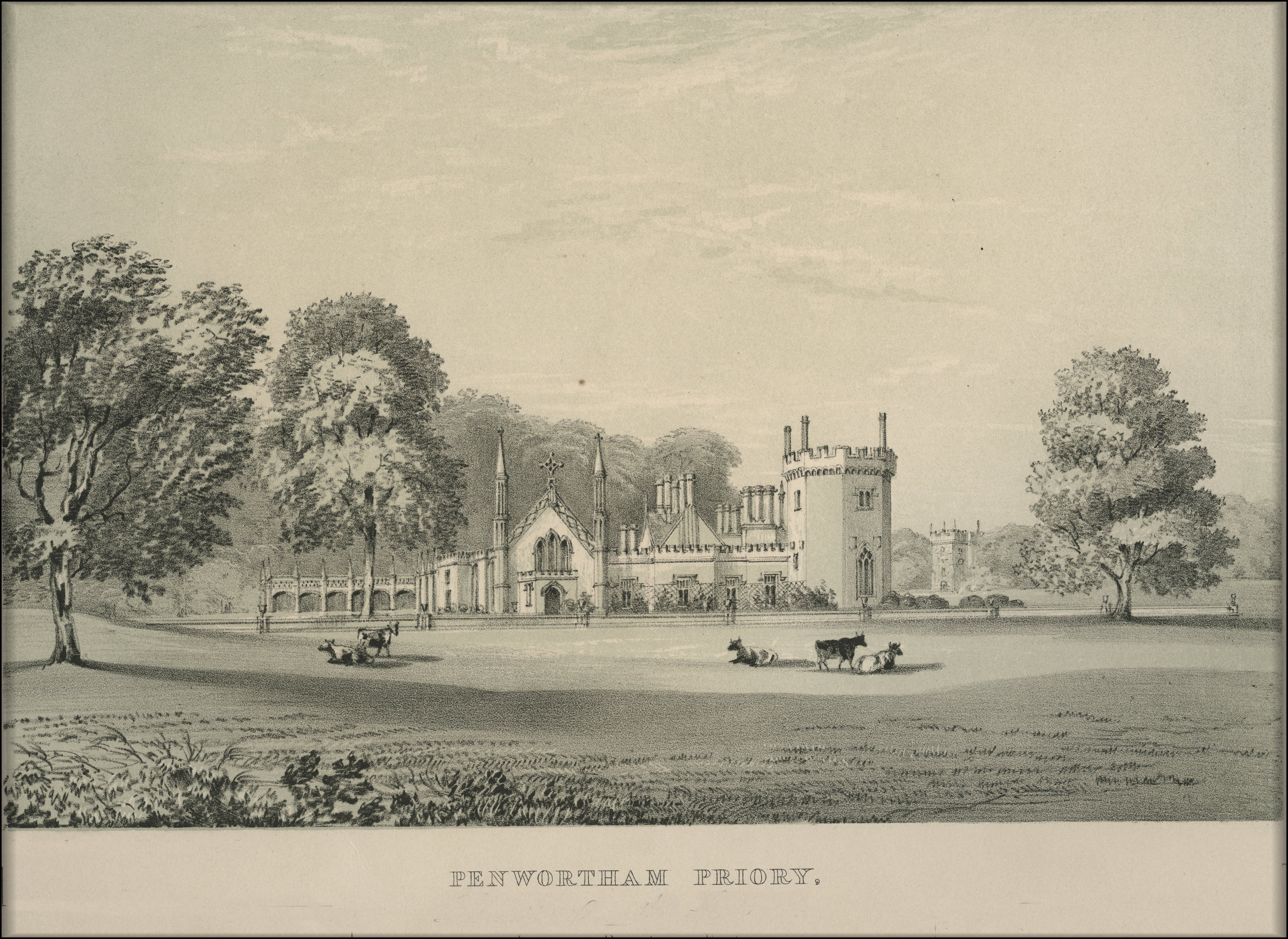
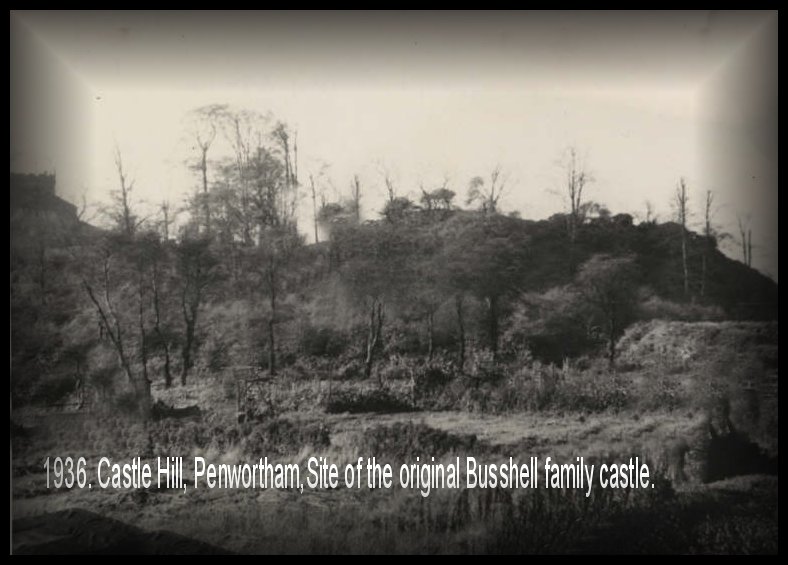
![]()
Amiera wife of Warin Busshell was the niece of Roger of Montgomery and a near kinswoman of William Duke of Normandy – King of England. The bloodline of Amiera descended to the Standish Family.
Richard Busshell gave ij. carucates to Richard Spileman in marriage with his sister, the manors of Standish and Langtree.
Richard Spileman had two daughters from his marriage with the sister of Richard Busshell, the elder, Juliana, and the younger, Edith.
Lancs. Inq. and Extents (Rec. Soc. Lancs. and Ches.), i, 31. No individual records exists for Richard Spileman. In the same time period a Hugh Spileman was recorded as one of the Abbot of Shrewsbury's 'men of Woolston'; Farrer, Lancs. Pipe R. 287.
The first Rector of Standish "Leising" had two sons, the elder, Radulphus, and the younger, Siward.
Ralph de Standish son of Leising is mentioned in the ancient note to a Langtree charter; Cockersand Chartul. (Chet. Soc.), ii, 514.
Spileman and Leising arranged the marriages of the two daughters and the two sons.
Radulphus Leising and Siward Leising sons of the rector Leising thus each married a daughter of Richard Spileman by one of the heiresses of the Busshells, barons of Penwortham, and lords of the wapentake of Leyland in Lancashire.
The de Standish and de Langtree families appear as seperate families about the year 1206, with Ralph de Standish and Siward de Langtree.
The members of the Langtree family were until 1206 known as “de Standish”, as the two manors of Standish and Langtree had been held in common by Richard Spileman.
A partition between Ralph and Siward of the manors of Standish and Langtree was effected by an agreement made in the King s Court at Westminster in Trinity Term, 1206 {Laru. Final Concords PL I p. 24 K }
The Lords of the Manor of Standish 1206 to 1920.
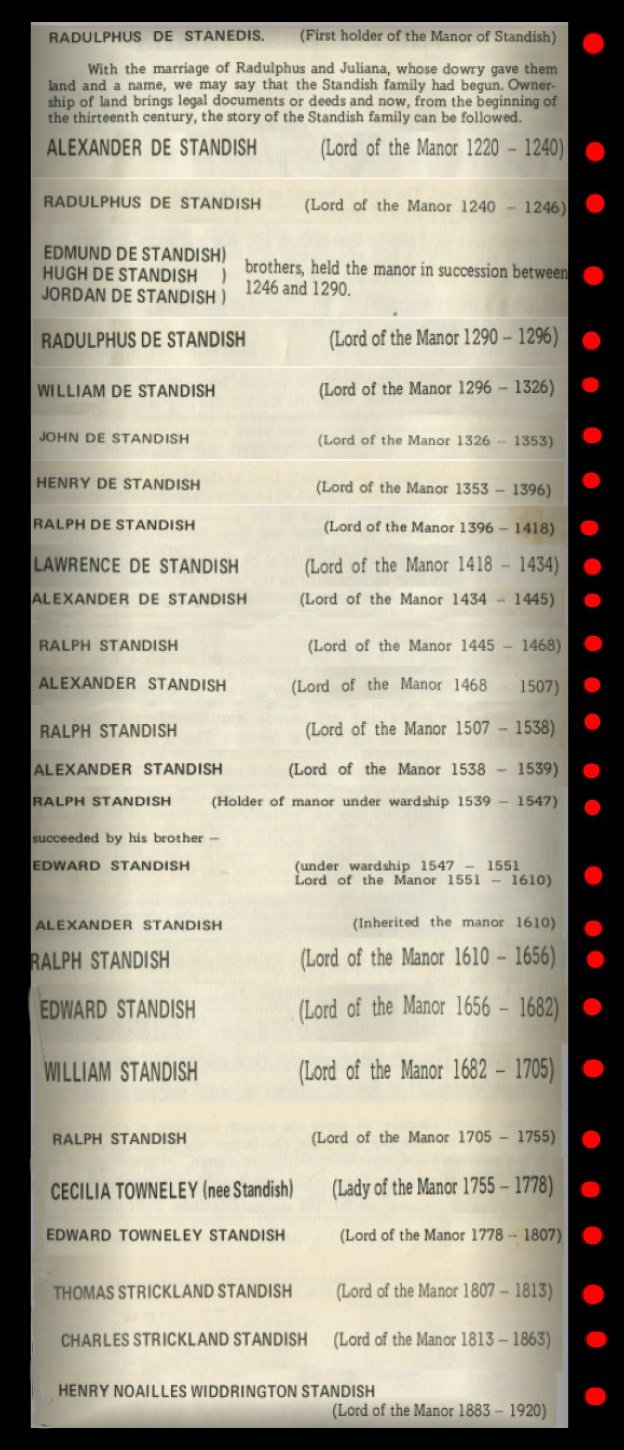
Important Dates in the history of the House of Standish.
1206 AD. Radulphus de Standish first Lord of the Manor of Standish.
Radulphus de Standish first Lord of the Manor of Standish. In one of the earliest deeds of ownership from the House of Standish, Radulphus purchased land from Siwardus de Duxbury and his brother Hugh at the Burgh upon the Manor of Duxbury.
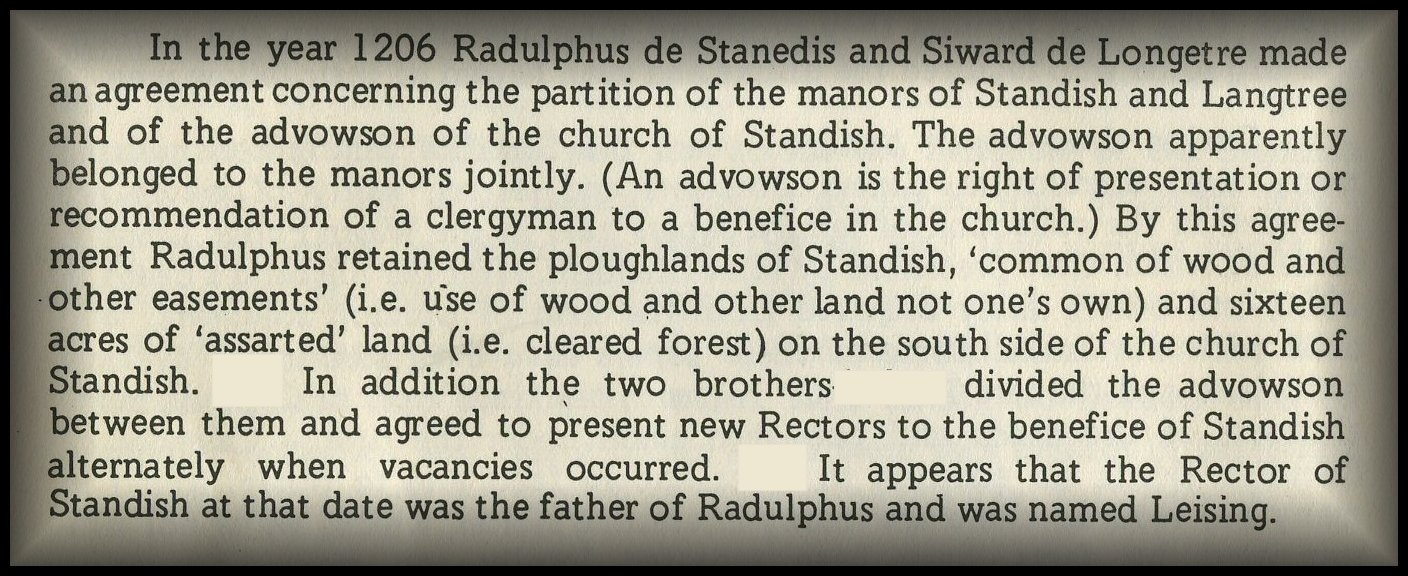
Children of Radulphus Standish and Juliana Spileman:
![]()
1219 - 1240 AD. Alexander de Standish Lord of the Manor of Standish.

Alexander de Standish, the son and heir of Ralph de Standish and Juliana Spileman, died about 1240. He succeeded his father as lord of the manor of Standish in 1219. He had been Rector of Standish since 1205.
He acquired the entire advowson of Standish Church and other rights from the Langtree Family.
Alexander de Standish had one child - Ralph de Standish.
![]()
1240 - 1246 AD. Radulphus de Standish Lord of the Manor of Standish.
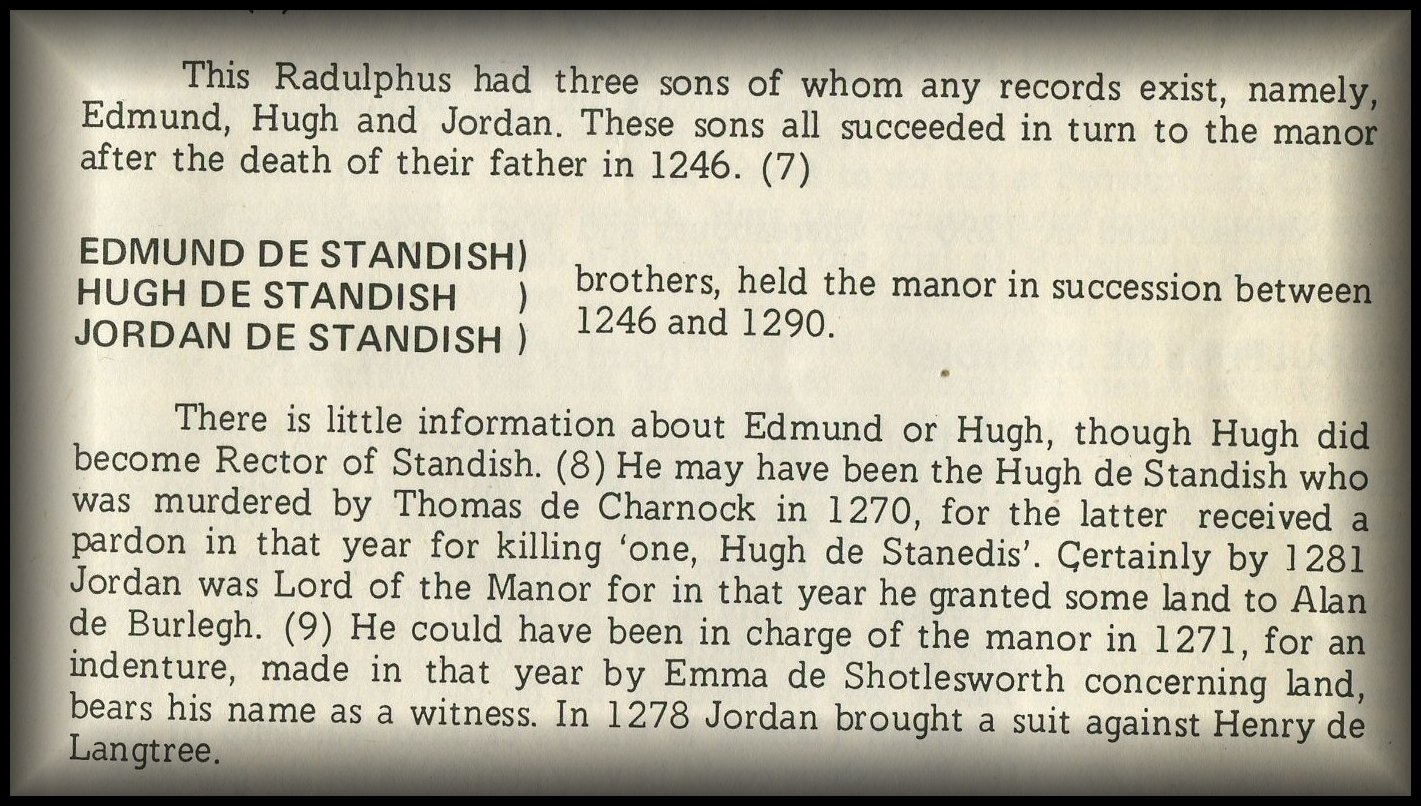
Children of Ralph
de Standish:
Edmund de
Standish, lord of Standish, but d. s. p.
Hugh de Standish,
lord of Standish, was Rector of Standish in 1253
Jordan de Standish, lord of Standish 1271 - 1290.
![]()
1246 - 1290 AD. Jordan de Standish Lord of the Manor of Standish.
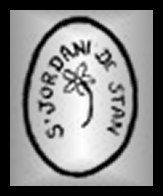
Seal of Jordan de Standish
Children of
Jordan and Alionora de Standish:
Ralph de
Standish, succeeded in 1290, but d. in 1296.
William de Standish lord of Standish from 1296.
Alice de
Standish, living 1304; m. Richard de Ince; Alice, daughter of Jordan de
Standish, releases to her brother William, son of Jordan de Standish, certain
lands in Shevington of which she had been enfeoffed by Jordan, her father.
Mabel de
Standish, living 1309; m. 24 June 1285, Henry Fulshaw.
Edmund de Standish, younger brother of William de Standish, son of Jordan de Standish, married Elena Shuttleworth. In 1346, he gave to Richard his son lands in Standish and Langtree, with remainders to his other sons, — Robert, Edmund and Henry. ref; (Kuerden MSS. V fol. 145)
Mabel and Alice daughters of Jordan de Standish occur in the deeds; Standish D. (Local Glean.), no. 9–13. Some of the deeds (as printed) are dated Edward I instead of Edward II.
![]()
Edmund son of Jordan de Standish.
Children of Edmund and Elena Shuttleworth:
Richard de
Standish, received lands in Standish and Langtree from his father.
Edmund de
Standish.
Henry de
Standish.
Robert son of Edmund de Standish frequently occurs in the Standish deeds and acquired Arley in Blackrod, the Standishes of Arley being his descendants.
The last Male of the Arley line James Standish died in 1525.
![]()
Hugh Haydock de Standish.
Jordan de Standish bequeathed some land to the children of Rector Robert de Haydock who was married to Jordan's sister. Hugh a son of Sir Robert de Haydock was the originator of the Duxbury branch of the Standish family who became Lords of the Manor of Duxbury. The last male of this line was Sir Frank Standish who died in 1812.

1312. Hugh de Haydock the son of Sir Robert de Haydock was granted land (Bradley) in Langtree by Henry de Langtree.
Other adjoining lands within Standish were granted to Hugh de Haydock by Robert de Worthington and William de Standish.
1290 - 1296 AD. Radulphus de Standish Lord of the Manor of Standish.
Radulphus de Standish - Ralph, died without issue in 1296.
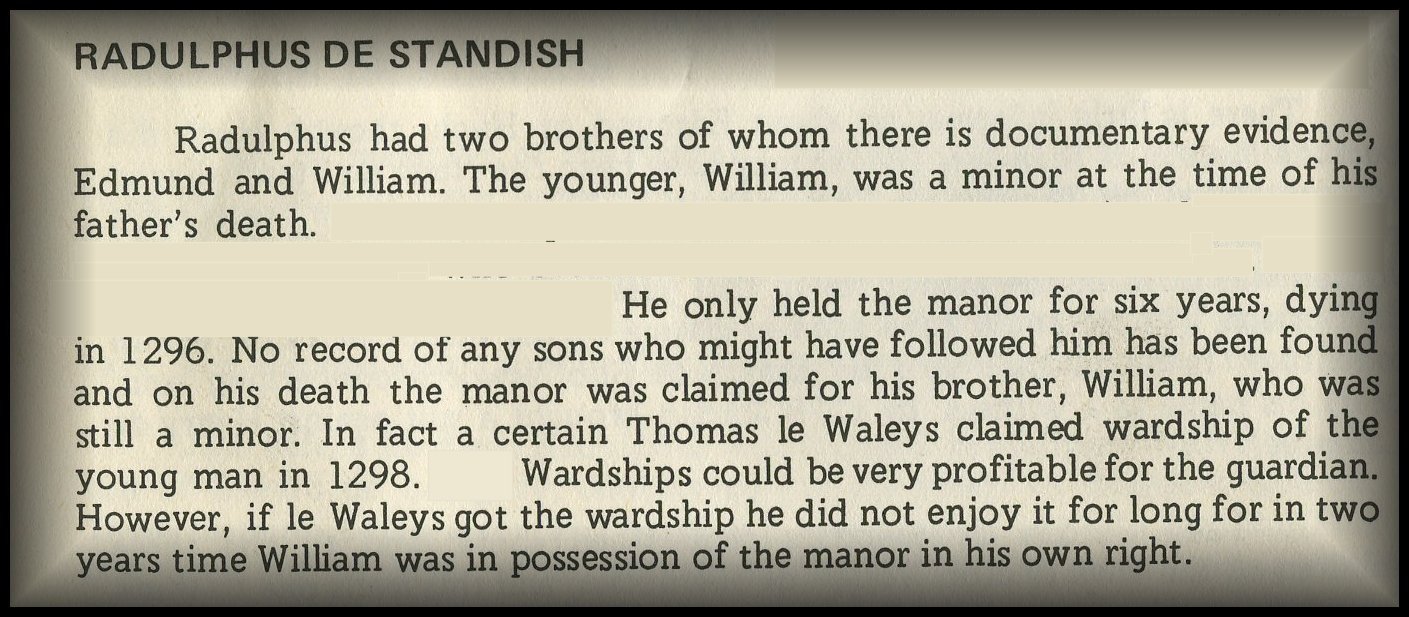
![]()
1296 - 1326 AD. William de Standish Lord of the Manor of Standish.
WILLIAM de STANDISH, lord of the manor of Standish, 1296-1326, son of Jordan and Alianora de Standish, died in 1326. He married Margaret, who died before 1332.
William de Standish had a daughter Joan who married Henry de Burgh, who held lands on the manor of Chorley and Burgh upon the manor of Duxbury.
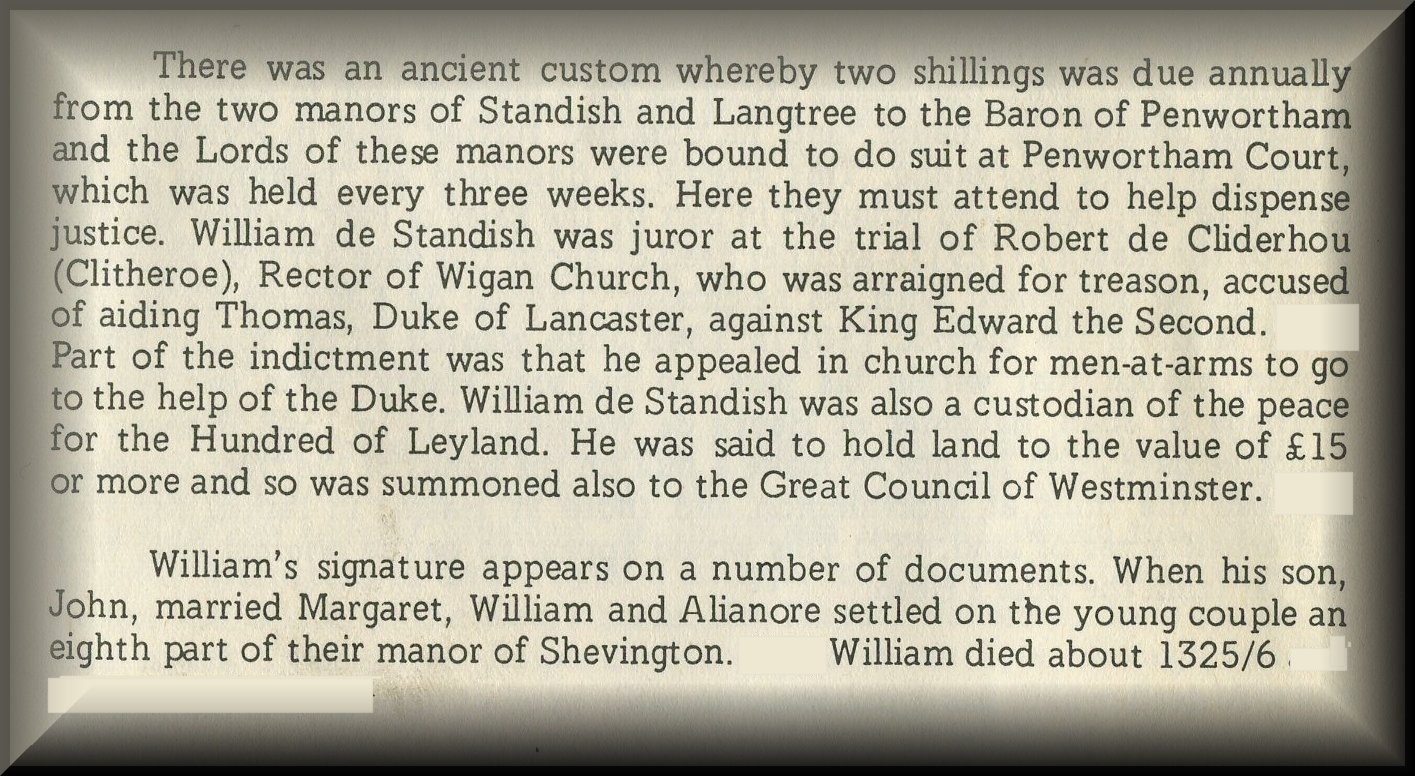
William de Wygan deeded to William, the son of Jordan de Standish, all his estates real and personal in Wigan. Dated, 1309.
William, son of Jordan de Standish, enfeoffs William the son of Nicholas of Wigan and Matilda his wife, in all the lands which had been conveyed to him by Richard de Ince and Alice his wife. Dated 1309.
Children of William and Margaret de Standish: John de Standish, lord of Standish, 1322-1353 Joan de Standish, married Henry de Burgh of Duxbury.
![]()
1326 1353 AD. John de Standish Lord of the Manor of Standish.
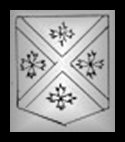
Arms of John de Standish.
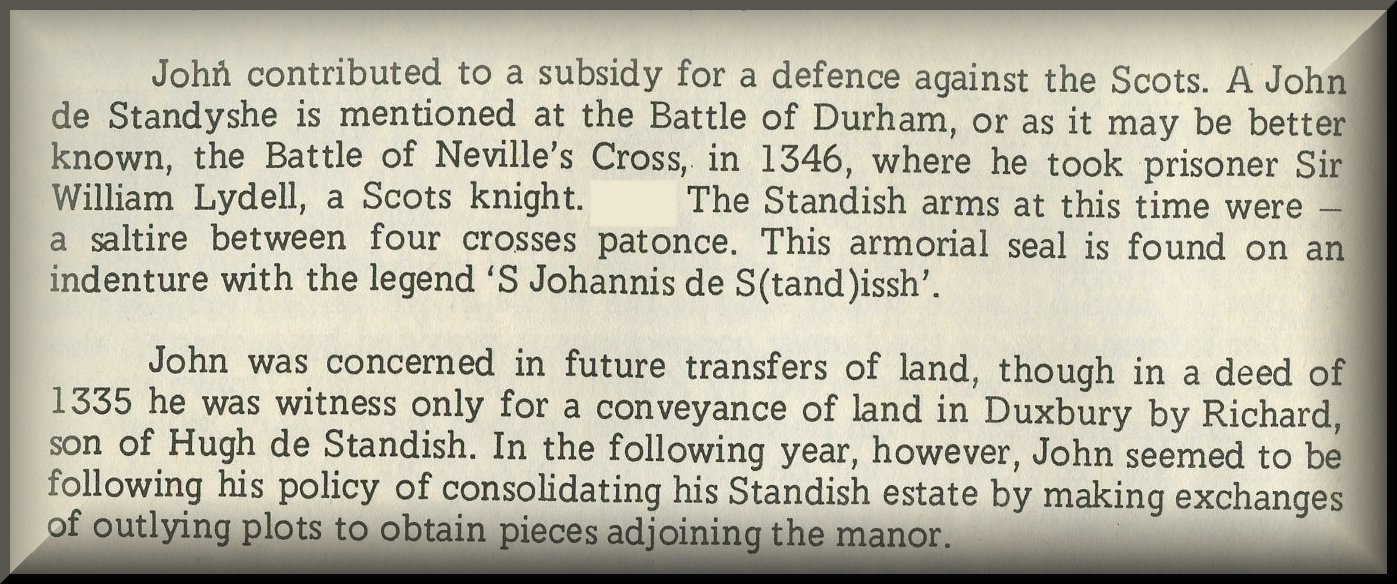
John de Standish had two sons who originated branches of the Standish family.
1. Thomas was the founder of Gathurst branch of the Standish family.
2. Ralph was the founder of Scholes / Ormskirk branch of the Standish family.
Thomas who married Margery de Hulton daughter of Robert de Hulton of Shevington. Thomas and his wife Margery were enfeoffed by his brother Gilbert Standish Rector of Standish of land at Gathurst. Thomas was the originator of the Gathurst branch of the Standish family.
John son of William de Standish in 1332 gave his eighth part of the manor of Shevington to his son William and Margery Hulton his wife, and if it should happen the said William and Margery should die without issue, then it should return to the right heirs of the said John.
(A branch of the Hulton family possessed most of the land in Shevington in the 13th Century and Crook was part of their estate. Jordan de Hulton, in 1253 claimed 8 oxgangs in Shevington and 30 acres in Wrightington.)
THOMAS de STANDISH, son of John de Standish, was living in 1384/5, but apparently had died before 1428. He married Margery de Hulton, daughter of Robert de Hulton of Shevington. Gilbert de Standish, parson of Standish, enfeoffed Thomas de Standish (his brother) and Margery his wife, the daughter of Robert de Hulton, in 1384/5. Witnessed by Henry de Standish (another brother). (SD 77).
To the High Sheriff of the County of Lancaster: — To command Henry de Blakehurst that he restore to THURSTON de STANDISH five acres of land and one acre of meadow with appurtenances in Shevington. To command Roger de Caterall and Katherine his wife to restore to the said THURSTON five acres of land and one acre of meadow with appurtenances in the said vill. To command Hugh del Hey and Isabel his wife to restore to the said THURSTAN five acres of land and one acre of meadow in the same vill, which Robert de Hulton gave to Richard his son and the heirs of his body, and which after the death of the said Richard and Roger his son, and after the death of Henry the son of Roger, the son of Richard, the son of Robert de Hulton aforesaid, and after the death of Robert the son of the said Henry; and Margery the daughter of Robert the son of the said Henry; the said lands ought to descend in virtue of the above grant to THURSTON de STANDISH as son and heir of the said Margery. And unless they shall so do, the said THURSTON then giving security for prosecuting his claim, you shall summon by good summoners the said Henry de Blakehurst, Roger de Caterall, Katherine, Hugh, and Isabel to appear before our Justices at Lancaster on the Monday in the fourth week in Lent next ensuing to show cause why they have not done as commanded. Witness ourselves at Lancaster 4th day of February, in the 6thyear of our reign - Henry VI, 1428.
THURSTAN de STANDISH - descent from the Hulton's -:
Robert de
Hulton, fl. 1253. (See Curia Regis
Roll above).
Robert de
Hulton, fl. 1277, 1292. (See SD 1
and 2; De Banco and Assize Rolls above).
Richard de
Hulton, fl. 1289. De
Banco Roll).
Roger de
Hulton, fl. 1325, 1343. Mrs. T. SD 35, 103; Assize
Roll; Add. MSS).
Henry de
Hulton, m. Maud, and fl. 1343, 1349, 1365, 1383, 1386. Assize
Roll; Add. MSS).
Robert de Hulton, mentioned 1384/5, 1428, 1442.
Margery de Hulton, m. Thomas de Standish.
THURSTAN de STANDISH, son and heir of Thomas and Margery. ( See VCH Lancs. VI ).
Thurstan Standish of Gathurst in Standish leased and released to Oliver son of Alexander Standish certain property at a rent of £ 5 per annum for ten years, and after that for a rent of £ 20 per annum. Dated, 1463/4.
In 1487/8,Thurstan Standish granted white wood, growing on the east side of the Hall of Gathurst and all the wood down the same side as far as Gathurst Bridge to Oliver Standish.
In 1477/8, Oliver Standish granted Thurstan Standish a discharge for money.
In 1502/3, Sir Alexander Standish made an indenture of feoffment to Ralph his son and heir apparent and to Thurstan Standish of Gathurst.
Sir Ralph was married to Elizabeth and left his estate to her and his lawful children by her. However Ralph had two illegitimate children by Mary de Ince and he made provision for them in his will. Ralph was the originator of the Scholes / Ormskirk branch of the Standish family. The Ormskirk branch is said to been founded by John Standish the illegitimate son of Ralph and Mary de Ince.
Sir RALPH de STANDISH, Knight, of Scholes, Prescot Parish, third son of John de Standish, Squire of Standish, died in 1383. He married Elizabeth, living in 1407, who married, second, before 1385, Thomas Lampet of Middlesex County.
Sir Ralph also had two illegitimate children by Mary de Ince.
By 1364, he had acquired lands in Wigan, Standish, Langtree and Shevington, which had belonged to Edward de Fulshagh and others.
He served the King in the retinue of the Black Prince in Aquitaine in 1377/8. The Black Prince granted him an annuity for this service of £ 20 out of the manor of Sutton near Macclesfield, which was continued to him as “our dear esquire” by Richard II. ( Mrs. T. SD 95).
As Sir Ralph de Standish, Knight, he was made warden of Scarborough Castle in 1381. (Calendar of Patent Rolls, 1381-1385, pp. 32, 47).
Children of Sir Ralph and
Elizabeth Standish:
Nicholas de Standish, living 1382/3.
Ralph
de Standish, living 1382/3. (Ibid.).
Mary de
Standish.
Illegitimate children of Sir Ralph Standish by
Mary de Ince:
John de Standish, living 1382-1407. Founder of the Ormskirk branch of the House of Standish.
*** Myles Standish and his descendants in the USA would be descended from this illegitimate line if as stated by the Reverend Porteus in his book that - "Myles Standish was a descendant of the Ormskirk branch of the Standish family".
Joan de Standish, fl. 1382-1407; m. John Sandbruar.
The slaying of Wat Tyler by Sir Ralph de Standish.

Sir Ralph de Standish was esquire to the Black Prince and it was Ralph's sword that fatally wounded Wat Tyler whilst being used by Ralph in defence of the young King Richard II.
He served the Black Prince, who granted him an annuity of £20 out of the manor of Sutton near Macclesfield, which was continued to him (as Ralph de Standish, esq.) by Richard II; Cal. Pat. 1377–81, p. 124.
In Oct. 1382, as Sir Ralph de Standish, he explained to his dearest brother Gilbert de Standish, the rector, the objects of a feoffment he had made. His lands in Wigan, Standish, &c., were for the use of his wife Elizabeth for life, for his issue by her, in default to Joan de Standish and heirs, then to John de Standish son of Mary de Ince. The deed was made in London; Standish D. (Mrs. Tempest's abstract), no. 102. Sir Ralph died soon afterwards, his annuity being at once granted to another; Cal. Pat. 1381–5, p. 180. The feoffees in May 1383 granted the lands to his widow Elizabeth with remainders to their sons Nicholas and Ralph and issue, and then to John and Joan children of Mary de Ince; ibid. no. 104.
![]()
1353 - 1396 AD. Henry de Standish Lord of the Manor of Standish.
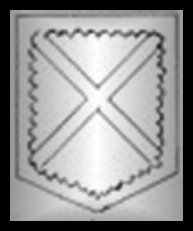
Arms of Henry de Standish.
Henry de Standish had a daughter Alice who married Hugh de Standish Lord of the Manor of Duxbury.
In an aid levied in 1378 it is stated that 6s. 8d. was due from Henry de Standish and Gilbert de Langtree for the third part of a knight's fee in Standish and Langtree; Harl. MS. 2085, fol. 423
In 1381 Henry de Standish granted to Hugh de Standish land called Bolton Field lying between the bounds of Wigan and the Twelve Acre, and extending to the road from Wigan to Standish [and] as far as the Douglas, in exchange for a moiety of 15 acres of the waste of Standish and Langtree next Byrlegh clough as far as the ford by the Cinderheap, and a moiety of a piece of the waste on Ratonraw Green in the same vill; Standish D. (Mrs. Tempest's abstract), no. 99. The seal shows the ancient coat of the family—a saltire within a border engrailed.
In 1396/7, Joan late wife (i. e. widow) of Henry de Standish, released to her son and heir Ralph de Standish, 100 acres of arable land in the vill of Standish and a place called Great Heys, near Standish Hall. Witnessed by her brother-in-law, Gilbert de Standish, Rector of Standish.
Children of
Henry Standish and Joan de Worseley.
Sir Ralph de Standish, lord of Standish, 1396-1415.
Alice de Standish, m. 1369, Hugh de Standish, of Duxbury.
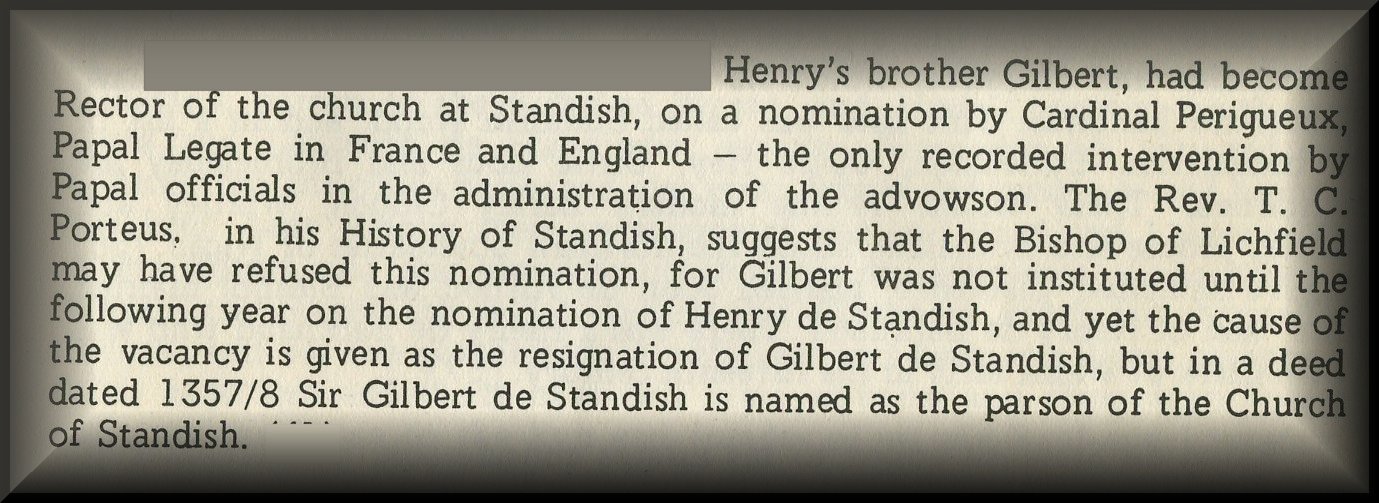
![]()
1396 - 1418 AD. Sir Ralph de Standish Lord of the Manor of Standish.

Arms of Sir Ralph de Standish.
Sir RALPH de STANDISH, of Standish, lord of the manor of Standish, 1396-1415, son of Henry and Joan (Worseley) de Standish, died after 1414/5. He married, about 6 May 1359, Cecilia Bradshagh, living 1411/2, the daughter of Roger Bradshagh of Haigh and granddaughter of John Osbaldston of Osbaldston, Esq. Sir Ralph served as Sheriff of Lancashire in 1392, was granted in 1398, a general pardon by the King , and was later appointed escheator in Ireland and died there. (Deputy Keepers Report, xli App. 727, 760).
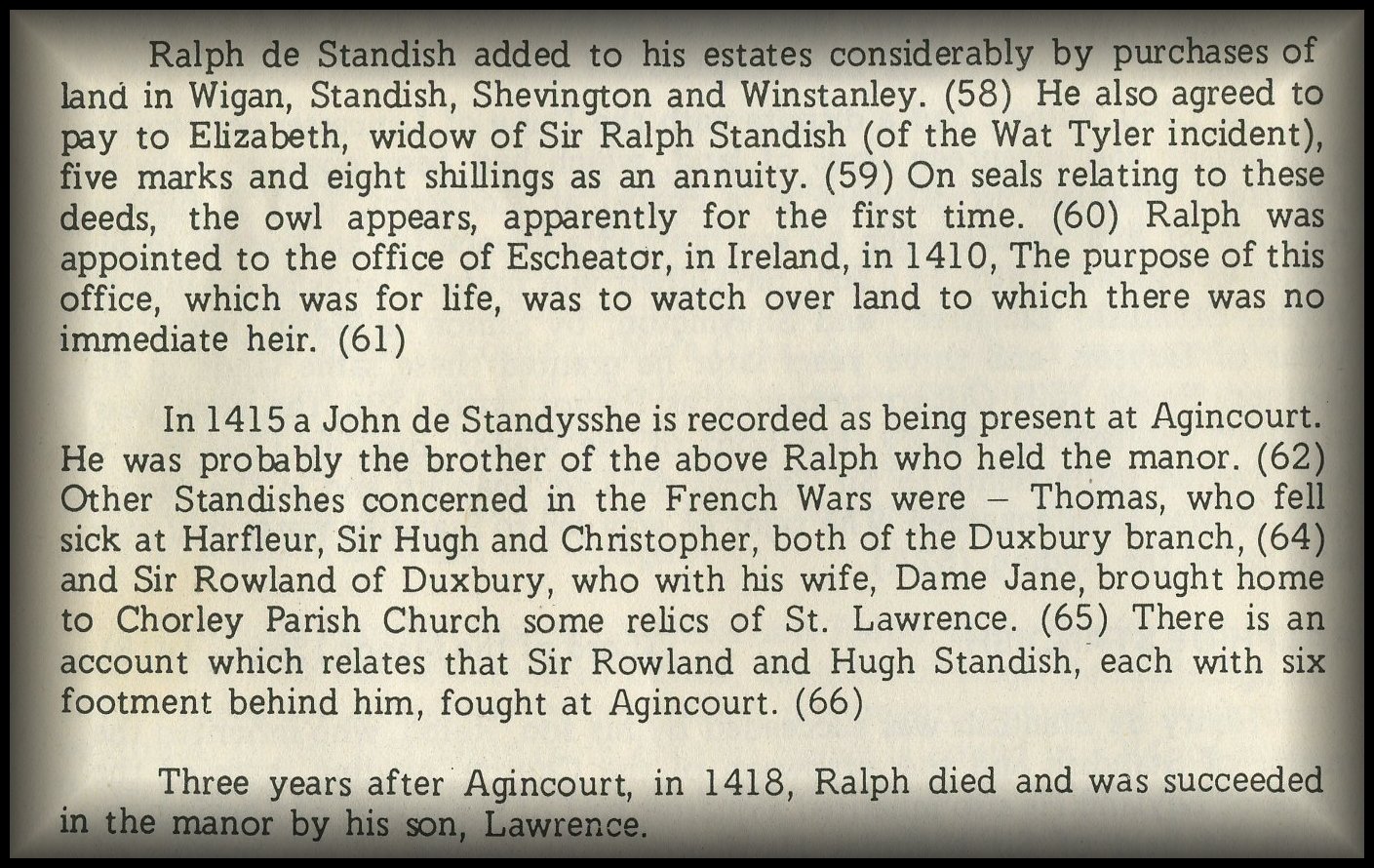
Sir Ralph acquired the estates of his uncle Sir Ralph de Standish of Scholes, 1406. On the 20th May 1407, Lawrence, son of Sir Ralph de Standish, and Gilbert his brother, took possession of these lands as trustees which had been granted to Ralph son of Henry son of John de Standish by Thomas Lampet, Esq., Elizabeth his wife, John de Standish, and included lands in Standish, Wigan and other places nearby.
Children of
Sir Ralph and Cecilia (Bradshagh) de Standish:
Lawrence
de Standish, Squire of Standish,
1415-1434.
Robert de Standish, served as a witness with Gilbert de Standish and John de Standish of Shevington, in 1423/4.
Gilbert de Standish was living in 1423/4, when he served as a witness. In 1400, he was mentioned in a deed , and entered into covenants with John Smith, chaplain, and Henry Matthew, 1411/2, as authorized by his mother and father. (S
James de
Standish.
John de Standish, fought in the battle of Agincourt, 23 Oct. 1415. Deed 102 concerns an indenture from John son of Sir Ralph de Standish, 1410. Ralph de Standish and Cecilia his wife gave a letter of attorney to their son John to enter into covenants with John Smith and Henry Matthew, chaplains. Seal: A saltire with a border engrailed.
Clemence de
Standish, m. John de Torboc.
Elizabeth Isabel de Standish m. 1405, Richard de Langtree, son of Gilbert de Langtree. The Bishop of Coventry granted a dispensation to Richard de Langtree to marry Elizabeth daughter of Rauff de Standish, 1403/4. In 1405/6, Alexander de Standish, parson of the church of Standish, with Thurstan de Anderton conveyed and settled upon Elizabeth Isabelle daughter of Rauff de Standish, married to Richard, son of Gilbert de Langtree - a parcel of land in Standish called Standish Wood.
![]()
1418 - 1434 AD. Lawrence de Standish Lord of the Manor of Standish.
Lawrence de Standish was married to Lora Pilkington the daughter of Sir Roger Pilkington.
LAWRENCE de STANDISH, of Standish, Esquire, lord of the manor of Standish, 1415-1434, son of Sir Ralph and Cecilia (Bradshagh) de Standish, died soon after 1434.
He married, 1398, Lora Pilkington, died after 1422/3, the daughter of SirRoger de Pilkington and Margaret de Verdon.
An indenture (1398) by fine for the seventh part of the manor of Shevington, two messuages, and two acres of land there, and five messuages in Standish, between Sir Roger Pilkington and Ralph de Standish and Cecilia his wife, for Lawrence their son, married to Lora, daughter of Sir Roger Pilkington. Dated 1398/9.
Also a fine of lands between Lawrence de Standish and Lora his wife, and Ralphde Standish and Cecilia his wife, of three messuages, 100 acres of land, six acres of meadow, four acres of pasture, and twelve acres of wood in Shevington and Standish, by which the said lands were settled on the said Lawrence and Lora. Dated, 1399/1400.
Children of Lawrence de Standish and Lora de Pilkington :
Sir Alexander de Standish of Standish, Knt., lord of the manor of Standish, 1434-1445.
Reverend
Roger de Standish, 1424-1478, gave an award for a family dispute in 1468/9. He also served as trustee in certain family matters from 1451 to
1466, and as a witness to deeds during the same period. He was inducted at Standish, April 2, 1424, his
father Lawrence de Standish, being patron. (Lich. Epi. Reg. IX fol.
113b). He was called clerk and parson at the time; later he is called priest
and Rector. (Pal. of Lane. Plea Rolls; Inq. p.m. (Chet. Soc.)7 II
104). fl. 1473. (Pal. of Lane. Chan. Rec. Answers). He was also Rector
(priest) at Eccleston, Mar. 28, 1467-July 6, 1478. (Lich. Epis. Reg. XII
fol. 120).
Richard de
Standish, served with his brother Roger in the family dispute of 1468/9.
James de Standish. (1428-1434).
![]()
1434 - 1445 AD. Alexander de Standish Lord of the Manor of Standish.
Alexander de Standish had a son Lawrence who was the originator of the Shevington - Park Brook branch of the Standish Family.
ALEXANDER de STANDISH of Standish, son of Lawrence de Standish and Lora Pilkington, was lord of the manor of Standish, 1434-1445, and he died in the year 1445. He married, 1421/2, Constance Gerard, who was living in 1468, the daughter of John and Alice Gerard of Bryn. His father, Lawrence, arranged in 1421, that Alexander should marry Constance daughter of John Gerard of Bryn.
Children of Alexander de Standish and Constance Gerard :
Ralph de Standish, of Standish, Esq., lord of the manor of Standish, 1445-1468.
Lawrence de
Standish, 1463-1495. (Shevington - Park Brook branch).
Hugh de Standish, 1468-1479.
Robert de Standish, 1468-1479.
Oliver Standish, infant in 1434. As son of Alexander and Constance Gerard, he was mentioned in deeds between 1463 and 1508. He was born in 1434. In 1479, Richard Rota and Joan his wife, with Seth their son, sold land in Shevington to Oliver Standish.
Piers de Standish, 1468-1480.
Henry Standish. (This Henry was not the Bishop of St. Asaph as sometimes quoted).Lawrence de Standish, 1463-1495. (Shevington - Park Brook branch).
Lawrence de Sandish, of Park Brook, Shevington, was son of Sir Alexander de Standish and Constance Gerard. He is mentioned in deeds between 1463 and 1495.
Lawrence and Oliver, sons of Alexander Standish, were arbitrators betwixt Gilbert and Robert Moody, son of John Moody, in 1463/4. He received from Gilbert Langtree certain damages allowed to him by George Stanley, Knt, Lord Strange, in 1494/5.
Child of Lawrence and Jane Standish of Park Brook: Lawrence Standish, of Shevington.Children of
Lawrence Standish:
Matthew Standish, gent., of Shevington and London,
Thomas Standish, gent, of Park Brook in Shevington.
Humphrey Standish.
Roger Standish,of Park Brook.
Roger sold all his lands, which he had inherited from his father Thomas Standish of Park brook to Edward Standish lord of Standish.
In 1553, Roger, son of Thomas Standish, made a deed of covenant with Edward Standish, Esq.
In 1556/7, Roger, son and heir of Thomas Standish of Park Brook, gent., granted Park Brook to Edward Standish of Standish, Esq.
Roger, son and heir of Thomas Standish, late of Shevington, gave a bond of £ 1000, to Edward Standish, Esq., to convey to him under good title all the estates of Thomas Standish his father and Elizabeth his mother. Dated, 1561/2.
On 8 March 1562, by a finelevied by Roger Standish to Edward Standish, Esquire, he grants all his lands
and hereditaments in Shevington, consisting of 3 messuages, 5 cottages, 60
acres of land, 40 acres of pasture, 20 acres ofmeadow, 20 acres of wood and 20
acres of turbary. ).
![]()
1445 - 1468 AD. Ralph de Standish Lord of the Manor of Standish.
Ralph de Sandish of Standish, Esquire, lord of the manor of Standish, 1445-1468,
died 1468, when there was a settlement of family disputes. He
was the son of Sir Alexander and Constance (Gerard) Standish of Standish. He
married Margaret Radcliffe, the daughter of Sir Richard Radcliffe of Chadderton,
thus further augmenting the family inheritance. She survived him and was living
as a widow in 1473. She afterwards married Thomas
Radcliffe and died in 1476, when Alexander, her son and heir, was twenty-four
years of age. (Lane. Inq. p.m. (Chet. Soc), II 126).
Ralph de Standish owned estates in Lancashire - Cheshire -Warwickshire and Essex.
Ralph de Standish conveyed his estates in Lancashire, Cheshire, Warwickshire and Essex with the advowson of the Church in Standish to Roger de Standish, Rector of Standish, and other trustees, in order to make settlements on the marriage of Alexander, his son and heir apparent, with Sibyl, daughter of Henry Bold of Bold, Esq. This was dated, 1451/2.
Children of Ralph de Standish and Margaret Radcliffe :
Sir Alexander de Standish, of Standish, Knight, born 1452, lord of the manor of Standish, 1468-1507.
Reverend Thomas Standish, D.D., living 1451/2.
Brian Standish, living 1451/2.
Hugh Standish, in will of Ralph
Roger Standish, in will of Ralph
1441. In the year 1441 Ralph bought land from Richard Greeg located in Chorley and Duxbury. This parcel of land lay across the boundary of Chorley and Duxbury. One part lay upon the Manor of Chorley the other larger part formed the Burgh upon the Manor of Duxbury including a Mill. This Land would become the inheritance of his grandson Thurstan Standish second son of Sir Alexander Standish originator of the Burgh branch of the Standish family.
The lands of Thurstan Standish of The BURGH at Duxbury.
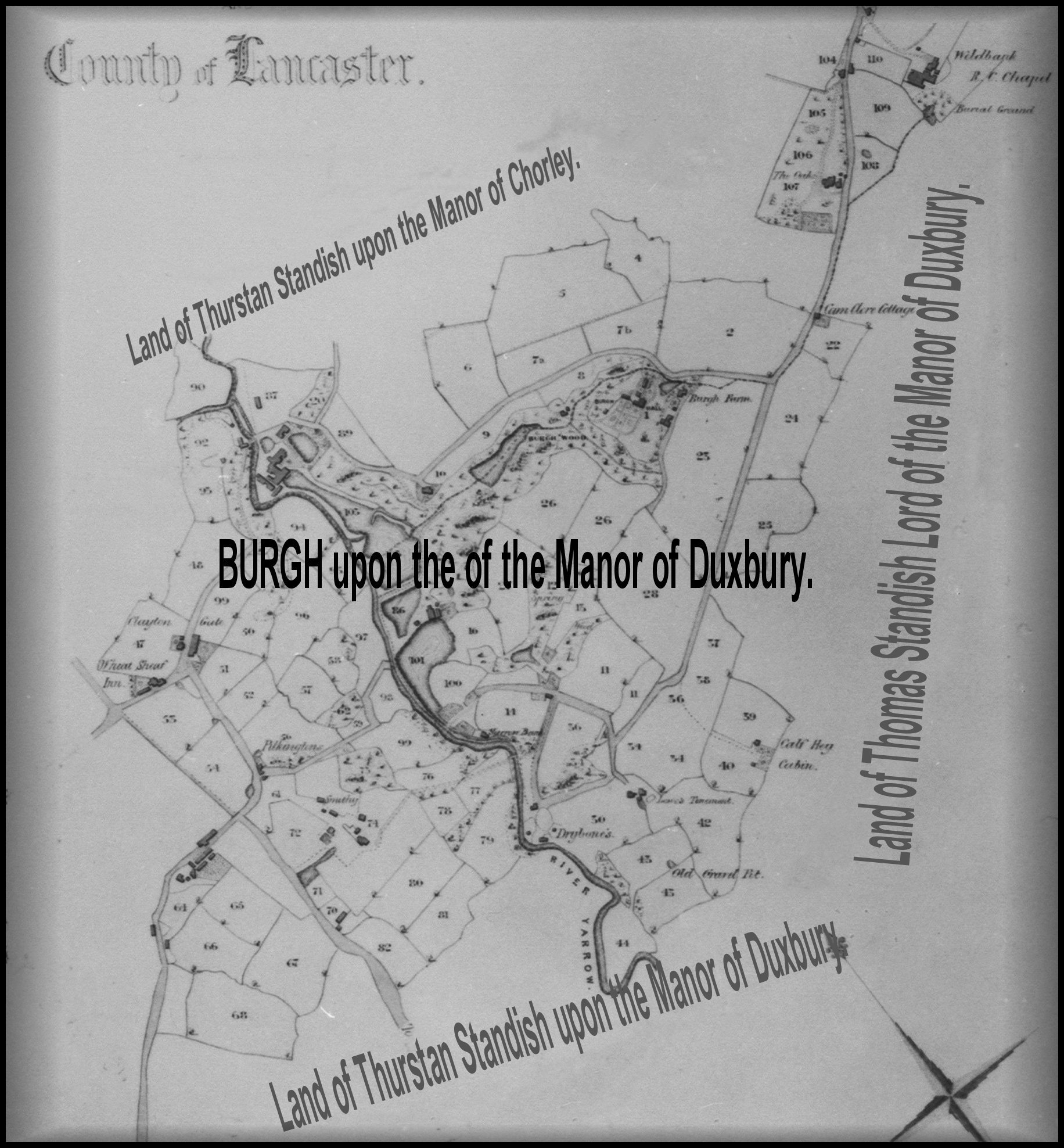
![]()
1468 - 1507 AD. Sir Alexander de Standish Lord of the Manor of Standish.
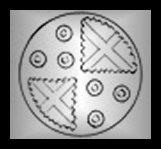
Arms of Sir Alexander de Standish.
. Sir Alexander Standish of Standish, Knight, lord of the manor of Standish, 1468-1507, son of Ralph de Standish and Margery Radcliffe, died in 1507, holding the manor of Standish of Sir Edward Stanley, Sir Richard Shireburne and Lady Le Stange in socage by a rent of five shillings, together with others manors and lands. Sibyl his widow was living at Bromley in Wigan at the date of the inquisition, and Ralph, their son and heir, was twenty-eight years of age. (Duchy of Lancaster Inq. p. m. iii No. 25).
Sir Alexander
was knighted at the battle of Hutton Field in Scotland, 1482. (Metcalfe, Book
of Knights, 7). He owned manors,
lands and tenements in Blackrod, Standish, Shevington, Langtree, Worthington,
Coppull, Chorley, Duxbury, Whittle, Adlington and Wigan besides estates in
other shires such as Chester, Warwick and Essex. A large landowner,Alexander appeares frequently in deeds.
Sir Alexander de Standish had by various accounts a large family of between seven to eleven children. Ralph his eldest son became Lord of the manor on his father's death and his marriage to Alice daughter of Sir James Harrington brought the Manor of Brixworth into the Standish Estates.
Children of Sir Alexander Standish and Sibyl de Bold :
1. Ralph Standish, of Standish, Esq. (born 1479), lord of the manor of Standish, 1508-1538.
2. Thurstan Standish, founder of the Burgh branch of the Standish family.
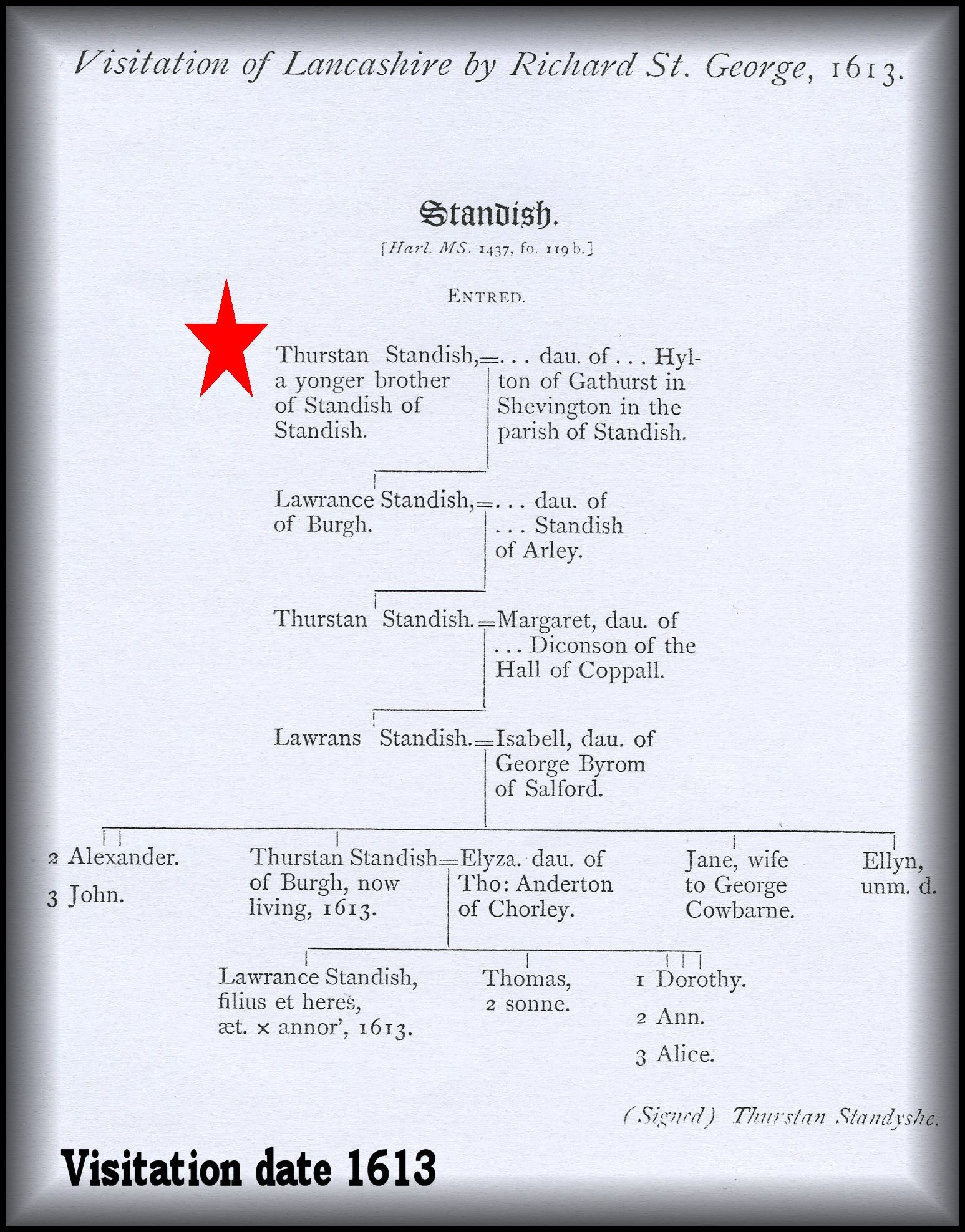
The second or younger brother Thurstan was the founder of the Burgh branch of the Standish family.
The original visitation record of 1613 for the Standish family of the Burgh upon the manor of Duxbury is held at the College of Heralds, London.
Standish Deed 296 records the purchase of Land in Chorley and Duxbury by Ralph Standish grandfather of Thurstan Standish in 1442. These lands became the inheritance of Thurstan Standish.

Thurstan Standish and his descendants were Catholics in common with the Standish Family of Standish. Should Myles Standish be descended from Thurstan Standish, Myles would have been born into a devout Catholic family and Myles would also have the royal French blood line direct from the Dukes of Normandy, France.
3. Henry Standish - Bishop of St. Asaph - Henry brother of Ralph and Thurstan was the Bishop of St. Asaph. (Katherine Standish the sister of Ralph - Thurstan - Henry married Thomas Standish Lord of the Manor of Duxbury).
1534.Court document.
1534. James Standish Lord of the Manor of Duxbury versus Henry, Bishop of St. Asaph.
James Standish son of Katharine and Lord of Duxbury was in dispute with his uncle Henry Standish - Bishop of St. Asaph. James Standish versus Henry, Bishop of St. Asaph, as Arbitrator between Abbot of Whalley and James Standish re Title to Tythes of Standish Parsonage, &c. the Right Honourable Sir William Fitzwylliam, Knight. Commission dated 04 Jul [1534] , 26 Henry 8., directed to Sir Henry Faryngton, Knight, Sir Roger Bradshagh, Knight, Rauff Standyshe, Esq., and Roger Asshowe, Esq.
Katharine Standish mother of James Standish Lord of the Manor of Duxbury was the sister of Henry, Bishop of St. Asaph.
4. Joan Standish, m. 1477, James, son of Sir William Bradshagh of Haigh. ( will of Sir Alexander de Standish)

5. Grace Standish, d. 1511/2. (Standish deed 349).

6. Katherine
Standish, m. 1497/8, Sir Thomas Standish b. 1480, d. 1517., lord of
the manor of Duxbury 1495-1517, son of Sir Christopher Standish of Duxbury and Alice Poole of Cheshire his wife. (Standish deed 190).
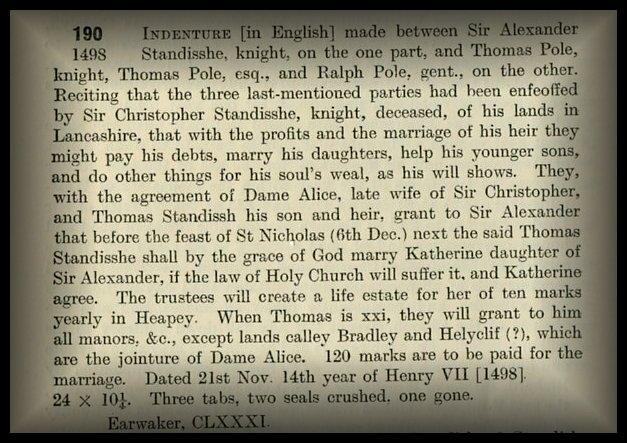
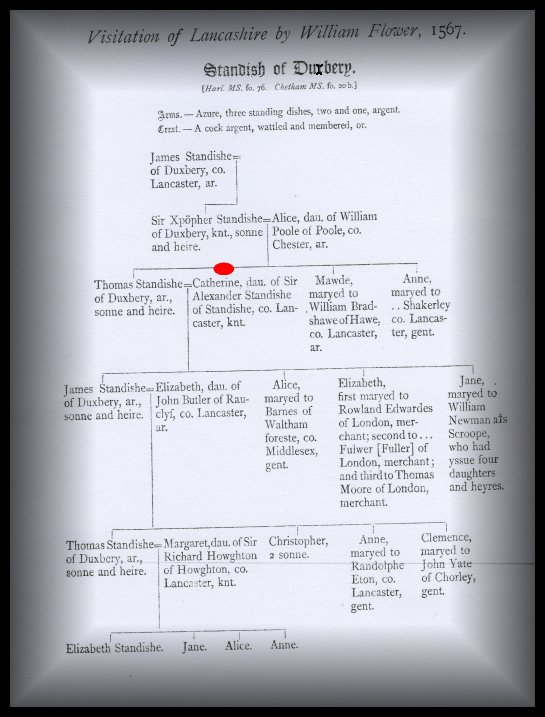
7. Robert Standish. (Standish deed 161)

![]()
1507 to 1538 AD. Ralph de Standish Lord of the Manor of Standish.

Arms of Ralph de Standish.
Ralph de Standish was a major purchaser of land and property in his time as Lord of the Manor. One major purchase was the final part of the Manor of Duxbury including Ellerbeck Hall that remained in the possession of the Duxbury family. The land known as Ellerbeck upon the Manor of Duxbury. Ellerbeck Hall was the last home of the Duxbury family who were descendants of Deowuc the Saxon the first Lord of Duxbury.
Ralph de Standish Lord of the Manor of Standish was the originator and first Lord of the Manor to use the Owl and Rat as a crest above the three standing dishes. His younger brother Thurstan Standish of the Burgh upon the Manor of Duxbury also used the Owl and Rat as a crest above the three standing dishes. Documents sealed by Ralph and Thurstan provide evidence of that use.
Ralph Standish married Alice daughter of Sir James Harrington and this marriage brought the Manor of Brixworth into the Standish Estates.
Sir William Harrington and Elizabeth his
wife were in possession of the Manor of Brixwoth, (fn. 39) and they in turn
were succeeded some time before 1492 by their son Sir James Harrington. (fn.
40) Sir James died on 26 June 1497 leaving the manor to his wife Isabel during
her lifetime, (fn. 41) with remainder equally among their daughters: Anne wife
of Sir William Stanley, Isabel wife of John Tresham, Joan wife of Edmund
Ashton, Catherine wife of William Myrfield, Agnes wife of Thomas Ashton,
Elizabeth wife of John Lumley, Clemence wife of Henry Norrys, Alice wife of
Ralph Standish, Margaret wife of Thomas Pilkington, and Eleanor Leicester.
Isabel Harrington of Wolfage and Brixworth received a general pardon in 1509.
(fn. 42) This appears to be the first reference to WOLFAGE Manor, which was
probably a part of Brixworth Manor. Isabel died on 20 June 1518, (fn. 43) and
the manor was divided. Of her daughters each of the following seems to have had
possession of a fifth share of the manor within a few years of her mother's
death: Alice Standish, (the heir of) Elizabeth Lumley, Eleanor Leicester, Agnes
Ashton, and Joan Ashton.
Inquisition Post Mortem of Ralph de Standish.
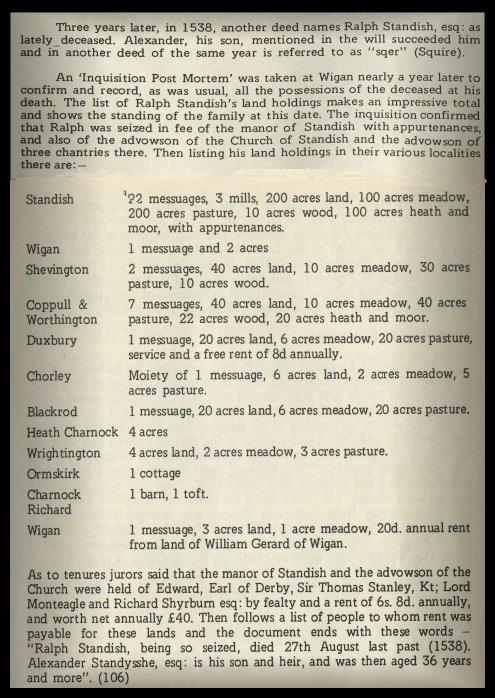
Children of Ralph and Alice
(Harington) Standish of Standish:
Alexander Standish lord of the manor of Standish, 1538-1539, born in 1502.
Anne Standish, (b. ca. 1500), m. 3 Nov. 1518, Sir John Holcroft of Holcroft, Knt, son of John and Elizabeth Holcroft of Holcroft. Their daughter Alice Holcroft was living in 1534 and was named in her grandfather’s (Ralph) will.
George Standish, second son, was living 24 Mar. 1513.
Roger Standish, of Standish, Esq., third son, was living 24 March 1513.
Jane
Standish, m. James Bradshagh of Haigh.
![]()
1538 - 1539 AD. Alexander de Standish Lord of the Manor of Standish.
Alexander de Standish died within 8 months of his inheritance at the age of 36 years.
Alexander Standish of Standish, Esquire, lord of the manor of Standish, 1538-1539, son of Ralph and Alice (Harington) Standish, was born in 1502, and he died in 1539. He married, in 1518, Anne Molyneux, daughter of Sir William Molyneux of Sefton, Knight. On 21st of October 1518, an arrangement was made for the marriage of Alexander, son and heir apparent of Ralph Standish, with Anne, daughter of Sir William Molyneux of Sefton. (Mrs. T. SD 201).
Alexander died only a few months after his father, in 1539, leaving a son and heir, Ralph, only nine years old. (Duchy of Lane. Inq. p. m. viii No. 23). The heir, not then married, was at that time in the custody of Alice Standish, widow, his grandmother.
Children of Alexander Standish and Anne Molyneux :
Ralph Standish, eldest son, born 1530; d. s. p. 1546, aged sixteen years.
Edward Standish, Esq., second son, b. July, 1532.
Jane Standish, m. Roger Bradshagh of Haigh.
Alice Standish, m. afteer 1539, Hugh Anderton; she had 200 marks at her marriage.
Agnes Standish, single in 1539; to receive 200 marks at her marriage.
Isabel
Standish, mentioned 17 Sept. 1535, in the will of her grandfather;
m. Thomas Lathom of Parboil; received £ 20 from her grandfather.
Eleanor Standish,
m.1539, William Warton of Warton, Lancashire; she received 200 marks at
her marriage.
Margaret
Standish, m. Lambert Tyldesley of Garret, Lancashire, 1539; she received
200 marks at her marriage.
![]()
1539 to 1547 AD. Ralph de Standish Lord of the Manor of Standish.
Ralph de Standish was Lord under wardship at the age of 9 years he died before reaching his maturity.
Ralph Standish, eldest son, born 1530; d. s. p. 1546, aged sixteen years. He married at an early age, Mary Tyldesley of Wardley. Ralph had been taken into the king’s wardship and dying in 1546, his younger brother Edward, born in July, 1532, was the heir. Edward obtained livery in 1553. (SD 107). (Duchy of Lane. Inq. p. in. vii No. 17).
![]()
1547 to 1610 AD. Edward de Standish Lord of the Manor of Standish.
Edward Standish was the brother of Ralph and was Lord under wardship at the age of 14 years. In 1551 at the age of 18 years Edward became Lord of the Manor in his own right and in his term as Lord he significantly increased the land holding of the Standish Estates, rebuilt the Church of Standish in 1582 and built Standish Hall in 1574. At the age of 30 in the year 1563 Edward married Ellen, daughter of Sir William Radcliffe. Two of Edwards sons Thomas and Edward were convicted of recusancy.
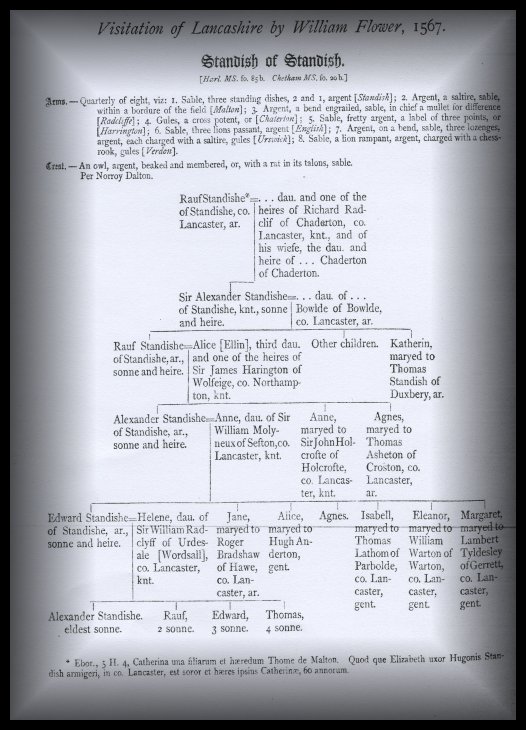
Edward Standish, lord of the manor of Standish, 1553-1610, second son of Alexander Standish and Anne Molyneux , was born in July, 1532, and he died in 1610. He married, first, Ellen Radcliffe, daughter of Sir William Radcliffe of Ordsall, Knight. She died in 1558. He married, second, Elizabeth Towneley, whose will was proved in 1614. Edward recorded a pedigree in 1567. (Visitations (Chet. Soc), 102).
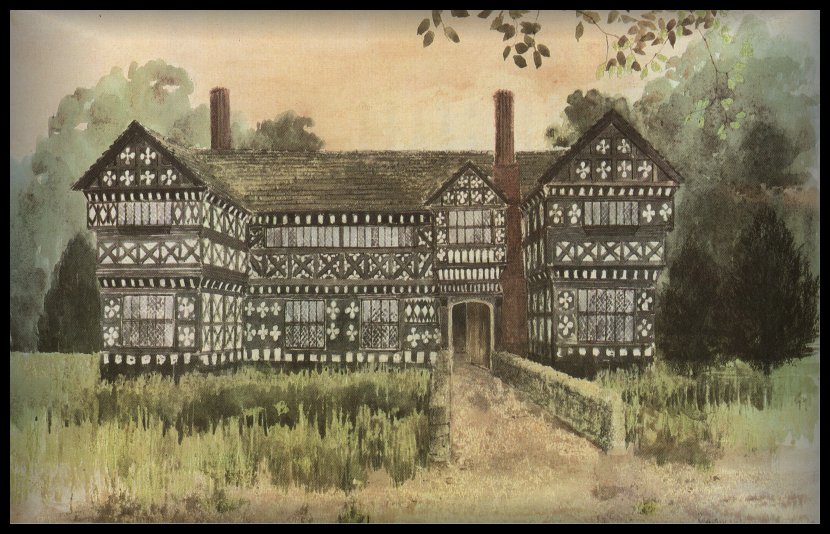
Standish Hall - 1574
Edward de Standish Lord of the Manor was dedicated to the crown in common with all his ancestors before him. In 1574 he furnished horses and arms for a muster, he also loaned a substantial sum of money to Queen Elisabeth I to finance armed resistance to Spain.
The will of Thurstan Tyldesley of Wardley, 1547, states that his daughter Mary has been espoused to Ralph Standish ( Edward's older brother), and a desire is expressed that the match should be continued by her marriage with Edward the brother and heir of Ralph. (Piccope’s Wills (Chet. See), i 101).
In 1583, Edward Standish was suing for woods called Gillotts and
Hayhurst in Chadderton, Coppull and Duxbury, the defendant being Mary widow of
his brother Ralph, and afterwards wife of William Tatton. (Pal. of Lane.
Plea R. 257 m. 9.).
1584. Rental of Duxbury.


In 1584, Sir William Tatton and his wife Mary widow of Ralph Standish (Edwards brother) are living on Standish of Standish land at Ellerbeck upon the Manor of Duxbury, in the former hall and home of the Duxbury family, the original descendants of Deowuc the Saxon.
Children of Edward Standish and Ellen Radcliffe :
Alexander Standish, eldest son.
Roger Standish.
Edward Standish, recusant.
Thomas Standish, recusant.
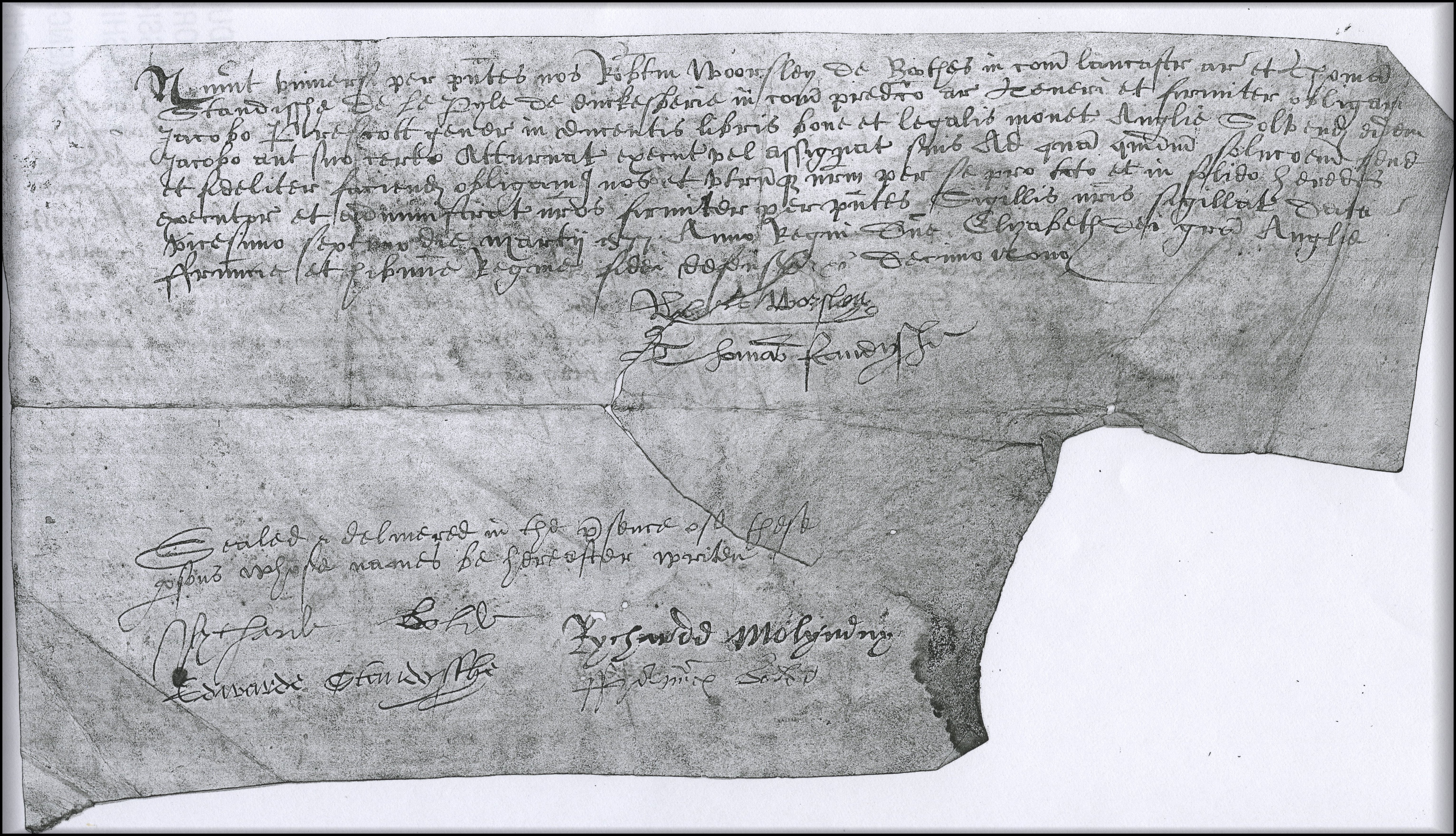
1577. Contract signed by Edward de Standish Lord of Standish and Thomas de Standish Lord of Duxbury.
1582. Church levy.
1582. Church levy - Names of all the residents upon the Manor of Standish - required to make a payment towards the rebuilding of the Parish Church of St. Wilfrid.
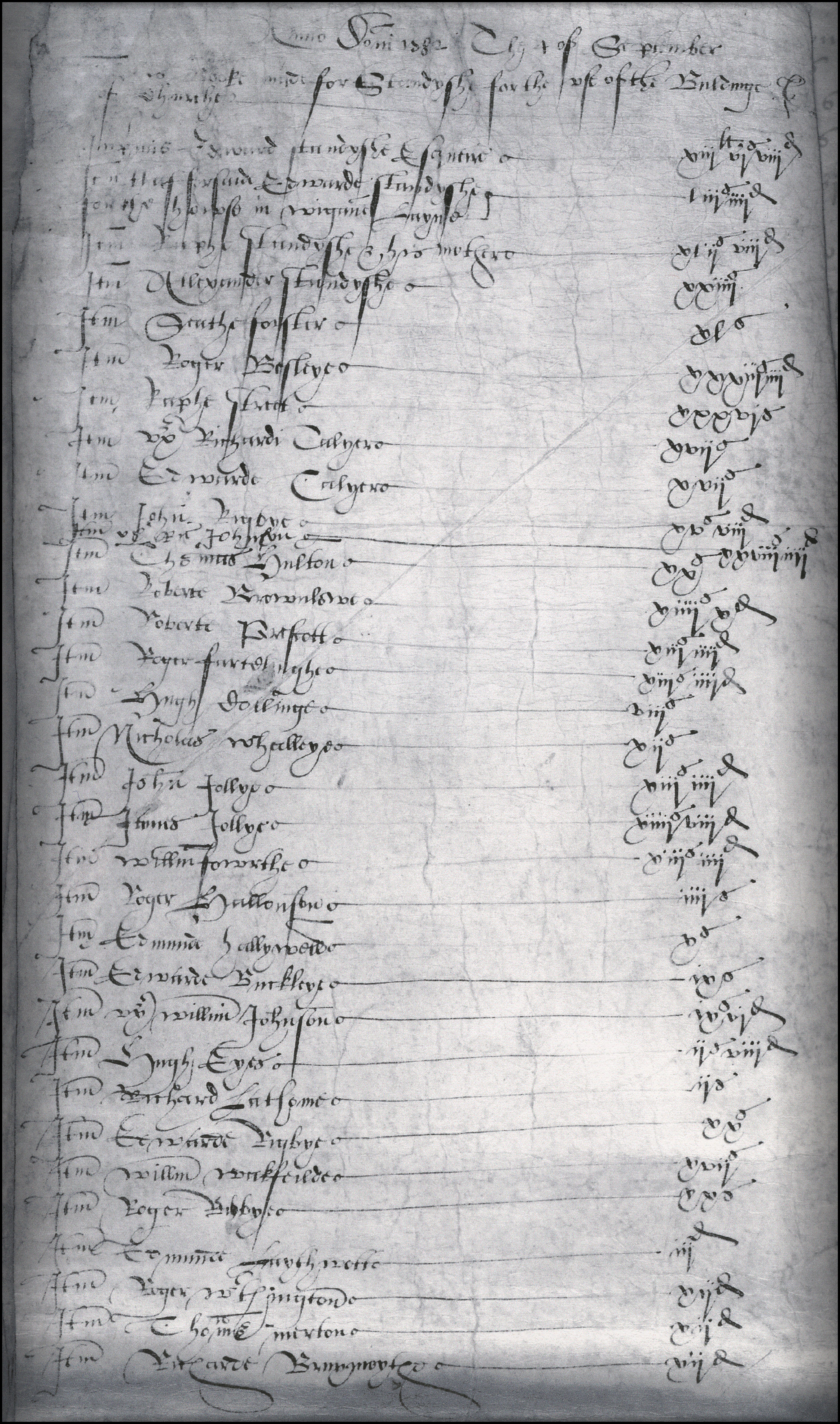
![]()
1584 AD.
In the term of Edward de Standish as Lord of the Manor of Standish, Myles Standish was born.


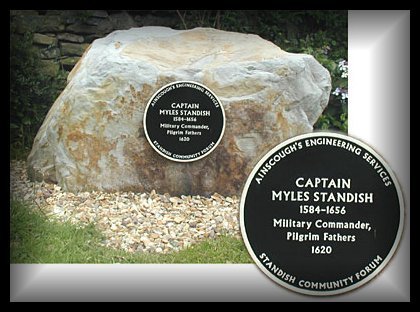
Tribute to Myles Standish at Standish, Lancashire, England.

![]()
1610 AD. Alexander de Standish Lord of the Manor of Standish.
Alexander Sandish of Standish and Woolston, lord of the manor of Standish 1610 son of Edward Standish and Ellen Radcliffe , was born 1560, died in 1622 and was buried at Warrington, Lancashire, April 23, 1622
Alexander was around fifty years old at the time of his fathers death and was living at Woolston, in Shropshire.
Alexander de Standish had married Elizabeth Hawarden when very young. She had brought estates with her in England and Wales and the Manor of Woolston .
1610. Alexander settled the Standish estates on his heir, Ralph in the year 1610, together with Parkbrook Hall, Urchinaiape and The Acres in Shevington whilst he continued living at Woolston, in Shropshire. .
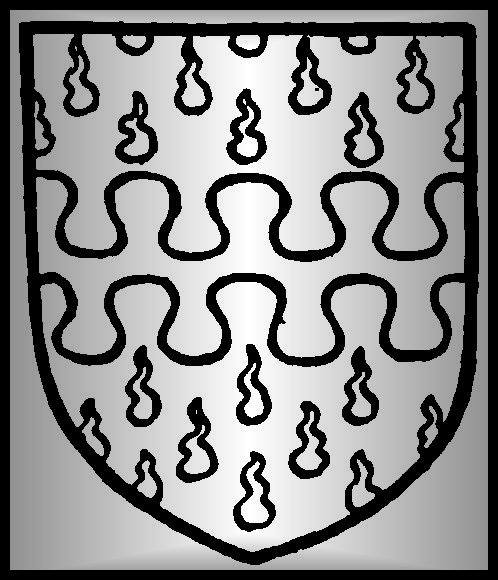
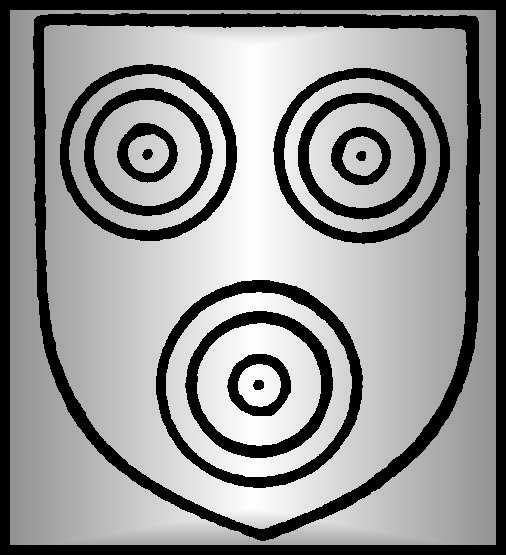
Hawarden Standish
The descent of the family of Woolston is
somewhat obscure. In 1401 Hugh de Woolston was in
possession of the manor. (fn. 19) By the marriage of his daughter Annabel (or
Elizabeth) to John de Hawarden of Hawarden, co. Flint, the manor passed to the
last-named family. (fn. 20) In 1432 John Hawarden and Elizabeth his wife were
freeholders in Poulton and Woolston. (fn. 21) His son Thomas Hawarden (fn. 22)
had a son Thomas, who died before 1513, in which year Joan his wife gave 20 marks
for the marriage of her son John, which Sir Thomas Boteler claimed in respect
of lands held of him in Warrington. (fn. 23) In 1523 John Hawarden was amerced
for not appearing at a court held at Warrington to do his suit for the same
lands. (fn. 24) He died in 1556–7 seised of this manor and of lands in
Halewood. (fn. 25) Adam his son, aged thirty years in 1556–7, entered his
pedigree at the visitation of William Flower in 1567. (fn. 26) The manor was
settled upon him by his father John Hawarden by fine in 1548. (fn. 27) He died
6 February, 1596–7, (fn. 28) his only son having predeceased him. Elizabeth,
daughter of Adam, had married Alexander, son and heir of Edward Standish of
Standish, in 1575, (fn. 29) and in 1581 Adam Hawarden and Alexander Standish had
conveyed the manor and family estates by fine to trustees, (fn. 30) as
Alexander Standish and Elizabeth his wife likewise did in 1609. (fn. 31) The
manor subsequently descended with Standish until March, 1870, when the hall was
sold to the present owner, Mr. John Bennett, by the Standish trustees, with the
consent of the late Charles Henry Lionel Widdrington Standish. The 'manorial
rights, if any,' were reserved by the vendors. (fn. 32)
Children of Alexander Standish and Elizabeth Hawarden :
Ralph Standish, eldest son b. 1583.
John Standish.
Thomas Standish, unmarried.
Alexander Standish, unmarried.
Margaret Standish.
Ellen Standish.
1610 to 1656 AD. Ralph de Standish Lord of the Manor of Standish.
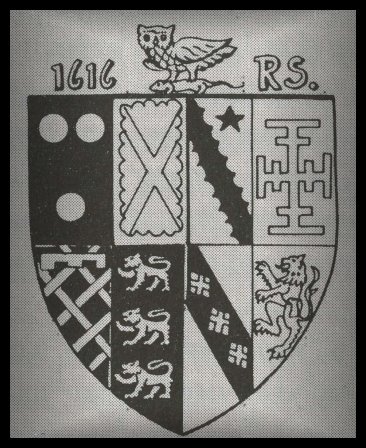
Arms of Ralph Standish.
Ralph succeeded to the manor in 1610 he married in the preceding year Frances, daughter of Sir Thomas Gerard. It was a brief love affair, for Frances died in 1610.
In 1613 Ralph made settlements of the manor of Standish and of Shevington. The following year his step-grandmother died; she was the second wife of Edward Standish and was a Towneley. Her brothers - Charles and Lawrence Towneley are mentioned in the will (1613) Ralph married for a second time in 1615, his second wife being Brigit Molyneux of Sefton and there were four known children of the marriage - Frances, Elizabeth, Edward and Alexander. Then in 1622, on the death of Alexander, his father, Ralph also succeeded to the manor of Woolston. Alexander's grave is at Warrington, where his wife Elizabeth was buried also.
Ralph Standish avoided conviction for recusancy, and on account of his age, took no part inthe Civil War. In his petition to the Parliament in 1652, Ralph Standish stated that he was “neither recusant nor delinquent.” (Cal. Com. for Comp. iv2812).
In 1632, he paid £ 30 on refusing knighthood. (Misc. (Rec. Soc. of Lane, and Ches.), i 222). A survey of part of his estate seems to have been made in 1634. (Towneley MS C 8 13 (Chet. Lib.), p. 1091).
In 1653, Oliver Cromwell issued an injunction to Richard Hoghton, gent., to stay a suit against Ralph Standish, Esq.
Alexander son of Ralph was a Colonel of Horse in the Royalist army and Wigan Lane House estate in Standish was sequestered in the belief that it belonged to him.
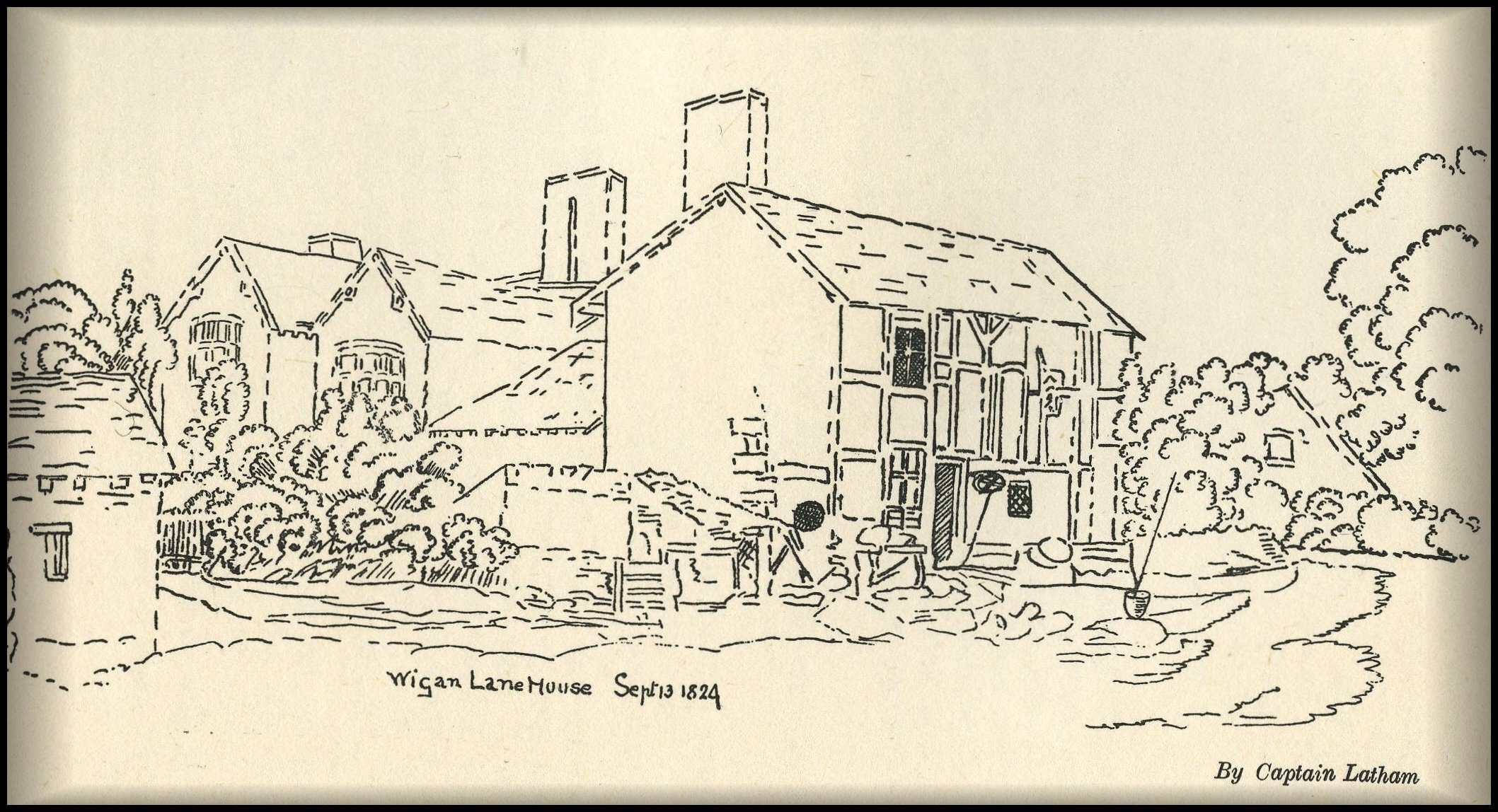
Ralph's daughter, Frances, was the wife of Sir Thomas Tyldesley, the famous Royalist General, who perished in the last battle of the Civil War in Lancashire, the Battle of Wigan Lane. A monument to his memory, erected by his Cornet, Alexander Rigby, still stands at the site of the battle in Wigan Lane, Wigan, Lancashire.
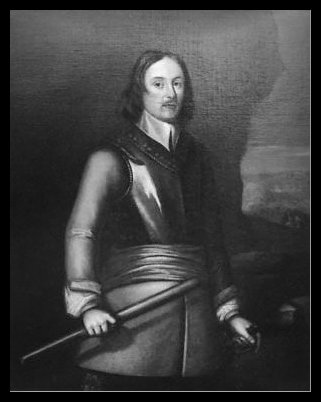
Sir Thomas Tyldesley

Monument to memory of Sir Thomas Tyldesley- Wigan Lane, Wigan, Lancashire.
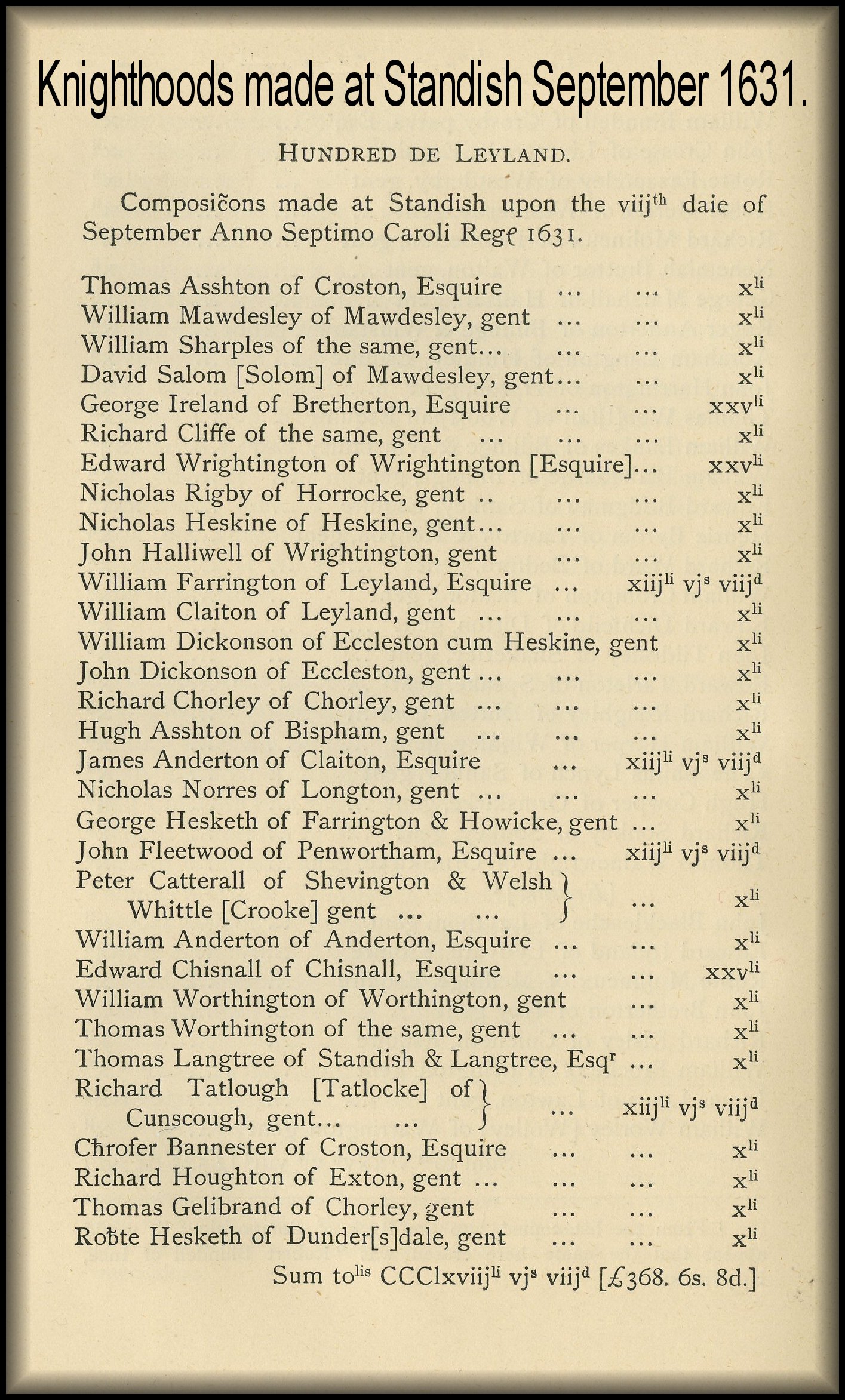
In 1656 Ralph Standish died and was buried in Standish Churchyard.
Children of Ralph Standish and Brigit Molyneux :
Edward was born in 1617 and died in 1682.
Frances.
Elizabeth.
Alexander.
![]()
Estates
confiscated by Order of the Commonwealth.
Lands and Estates forfeited for Treason,
Index of the Names of Royalist Traitors.
ALLENSON, William late of Woolton-Magna
in Lancaster County
ARNOLD, William of Crosby
BRADLEY, James of Bryning
BEESLEY, Thomas of Layton and Boughton
BOND, John of Inkling-Green
BARKER, John of Weetley
BARNS, Thomas of Goose-Nargh cum Wittingham
CRAVEN, Robert of Billington
CARTER, Joseph of Furnes
DENTON, John of Widnes
DARWEN, William of Wavertree
DOUGHTY, Henry of Thotnley
GREEHALGH, John late of Bramblesholm, deceased
GREEN, William of Torisholm
GERRARD, Charls of Halsal
HORNBY, George of Standish
HAUGHTON, Gilbert of Brinscals
KIRKBY, John of Upper Rawcliff cum Turnaker
KEY, John of Walmersley
LEWIS, William of Torkesteth, Clerk
LEYLAND, Richard of Abraham
LEYLAND, Ellis of Woston
LAMB, William of Turnham
MARTINGDAL, Philip of Blackrod
MELLING, William of Chorley
NORRIS, Edward late of Hale, deceased
NICHOLSON, Christopher of Tatham
PILKINGTON, Hugh of Coppul
PRESCOT, Edward of Standish
PERKINSON, Thomas of Chipping
PARK, Lawrence of Cuesdal
RIGBY, James of Coppul
ROBINSON, George of Bretherton
RATCLIFF, William of Foxdenton, deceased
RICHARDSON, Thomas of Outrawcliff
ROBINSON, John of Oldlaund
REDMAN, Sir John of Writon
SNART, Henry late of Bretherton, deceased
SCOT, Ralph of Pemberton
SALVAGE, Richard of Rufforth
SUDEL, Richard of Fishwick
STAMPARD, James of Warton
TRAVERS, Peter of Skilmersdale
WOOD, Henry of Widnes
WAINWRIGHT, John of Latham
WRIGHT, Ellis of Croston
WARD, James of Osbulstone
ANDERTON, James of Birchley in Billing
ANDERTON, Hugh of Euxton
ANDERTON, James of Clayton
ANDERTON, William of Anderton
ASHTON, Henry of Blackrod
BOOTLE, Robert late of Thornton, deceased
BLUNDEL, William of Crosby-Parva
BARKER, Alexander of Dalton
BERRY, John of Haughton
BROWN, John of Standish
BAMBER, John of Layton
BUTLER, Edward of Outrawcliff
BUTLER, Henry of Goosenargh cum Whittingham
BIRTWISLE, Thomas of Huncoat
BROCKHOLES, Thomas of Cheyley
BROCKHOLES, Thomas of Hayton
BAINS, Thomas of Sellet
BRADSHAW, John of Scale
BUTLER, William of Mierscough
CLIFF, John of Eccleston
CARTER, Richard of Widnes
CHORLEY, Richard of Chorley
CLIFTON, Jervase of Salming-Grange
CLARK, Thomas of Catteral
COTTAM, Richard of Dilworth
CONWEL, George of Watton
CALVERT, John of Cockerum
CHORLEY, Robert of Yealand
CROSLAND, Jordan of Furnes
DENTON, Edward of Ditton
DOBSON, Hugh of Legrum
DALTON, Thomas late of Turnham, deceased
ELTONHEAD, Richard of Eltonhead Junior
EYVES, Richard of Bradley and Fiahwick
FIZAKERLEY, Nicholas late of Fizakerley, deceased
FIZAKERLEY, Robert late of Walton, deceased
FOWL, Robert of Billington
FLETCHER, John of Burscoe
GREEN, James of Tilsley cum Astley
GORE, Edward of Alker
GREGSON, John of Latham
GORSUCH, James of Scaresbrick
GELLIBRAND, Thomas of Chorley
GREEN, Richard of Bowerhouse
GRADEL, William of Ulneswalton
GRIMSHAW, Thomas of Clayton
GRIMSHAW, Robert of Clayton
GRIMSHAW, Nicholas of Clayton
GERRARD, William of Ashton
HOWARD, Ralph of Sutton Senior
HOWARD, Edward of Eccleston Junior
HARRISON, Tho,as of Speak
HESKETH, William late of Northmeals, deceased
HAUGHTON, John of Parkhall
HOUGHTON, William of Grimzargh
HARRIS, Christopher of Chipping
JACKSON, Christopher of Bold
JANYON, George of Blackrod
KNOWLS, John of Par
KELLET, Richard late of Fishwick, deceased
LANCASTER, John of Reynel
LIVESEY, George late of Sutton, deceased
LINEAKER, John of Widnes
LATHOM, John of Hugton
LAWRENSON, John of Hugton
LATHOM, William of Allerton
LATHOM, Richard of Allerton
LATHOM, Edward of Allerton
LOVELADY, Henry of Alker
LUCAS, Richard of Haughton
LANGTON, Abraham of Hindley
LANGTREE, Thomas of Langtree
LATHOLM, Richard of Perbold
LABURN, William of Torisholm
MANWARINGG, of Windle
MIDGEAL, Edward of Goosenargh
MARSH, Roger of Goosenargh
MOLLINEUX, Edmund of Ince-Blundel
MELLING, John of Ince-Blundel
MOLLINEUX, John of Ince-Blundel
MOSS, Richard of Lathom
SKINNER, ??
MOSSOCK, Henry of Bickerstaff
MOSS, Richard of Skelmersdale
DYER, ??
MOSS, Henry of Skelmersdale
MORLEY, Thomas of Wymington
NORRIS, Thomas of Fornby
NELSON, Henry of Madesley
NAYLOR, William of Croston
NORRIS, William of Adlington
NELSON, Thomas of Wrightington
NORRIS, William of Blackrod
NEWSHAM, Andrew of Little-Plumpton
NORTH, Richard of Docker Junior
MEWSHAM, Nicholas of Little-Plumpton
ORTON, Francis of Woodplumpton
PEMBERTON, James of Whiston
PARKER, John late of Bradkirk, deceased
PLESHINGTON, Robert of Dimples
PARKINSON, Thomas of Clawton
PARKINSON, Lawrence of Goosenargh
PARKER, William of Woolfal
PARKINSON, Thomas of Graston-Leigh
PAR, Ralph of Altham
PARKER, John of Loveley
PARKINSON, Lawrence of Swinshead
PRESTON, William of Ellel
PARK, Giles of Furnes
QUICK, Richard of Woolton-Magna
RICE, James of Crosby-Magna
RICE, Edward of Crosby-Parva
PEARSON, Thomas of Mierscough
PARKER, Thomas of Graston-Leigh
RIGMADEN, George of Latham
RIGBY, John of Standish
RISHTON, Ralph Senior, of Whiteash
RISHTON, Ralph, Junior, of Whiteash
RISHTON, Edward of Michaelhaies
RISHTON, William of Ponthaulgh
ROSCOE, John of Dalton in Furnes
RUTTER, Michael of Croston
SHUTTLEWORTH, Richard of Bedd'
STANNANAAUGHT, Henry of Fizakerley
SPEAKMAN, William of Latham
STANLEY, Peter of Bickerstaff
SMITH, John of Euxton
SENHOUSE, John of Ecclestone
STANDISH, Lawrence of Standish
SMITH, John of Conow
SUDEL, Lawrence of Fulwood
SHEPHEARD, Thomas of Preston
SOWERBUTS, Thomas of Samlessbury
SHERBURN, Robert of Little-Mitton
SERGEANT, Robert of Alcliff
SINGLETON, Thomas of Dendron in Furnes
TURNER, George of Garston
TICKLE, John of Alker
TICKLE, John of Derby
TUTLOCK, Edward of Kirby
TOOTLE, Hugh of Whitkel
TOOTLE, John of Chorley
TREFAL, Cuthbert of Goosenargh
THORNTON, Richard of Fence
TALBOT, John of Dinkley
TOWNLEY, Christopher of Curre
STANNANAUGHT, Lawrence of Kirby
TURVOR, John of Tunstal
TRELFAL, Wil. of Warton
THISTLETON, Andrew of Mierscough
THOMPSON, Wil. of Eccleston
TILSLEY, Edward of Ashley
UNSWORTH, Edward of Windle
URMSTON, Richard of Leigh
WETHERBY, George of Whiston
WADMOUGH, Richard of Sutton
WEBSTER, Hugh of Eccleston
WELSH, Thomas of Awton
WHITTLE, John of Wheelton
WOODCOCK, Thomas of Brindle
WARING, Robert of Chorley
WATERFORTH, Hugh of Mawdesley
WESTBY, John of Mowbrick
WESTBY, Francis of Mierscough
WHITE, Robert of Kirkland, deceased
WESTBY, George of Uprawcliff
WILKINSON, John of Furnes
20th Day
of May, 1642
Source: An Index of the Names of
the Royalists Whose Estates were confiscated During the Commonwealth.
Compiled by Mabel G.W. Peacock London, Longmans Green & Co.
39 Paternoster Row
Hertford: Printed by Stevin Austin & Sons
Published in 1878
![]()
1656 to 1682 AD. Edward de Standish Lord of the Manor of Standish.
Edward Standish of Standish, lord of the manor of Standish, 1657-1682, was born in 1617 and died in 1682. He married Nov. 11, 1632, Elizabeth Howard, daughter of Sir Francis Howard of Corby Castle, Cumberland.
Edward
Standish took the King’s side in the Civil War and his estates were sequestered
by the Parliament and sold. (Cat
Com. for Comp.
In 1664, Edward Standish recorded a pedigree.
In 1669, Edward made a settlement of his estates.
In 1670 the confiscated lands of the Langtree family were sold by order of Parliament and came into the possession of Edward Standish.
.
1664, Pedigree of Edward Standish
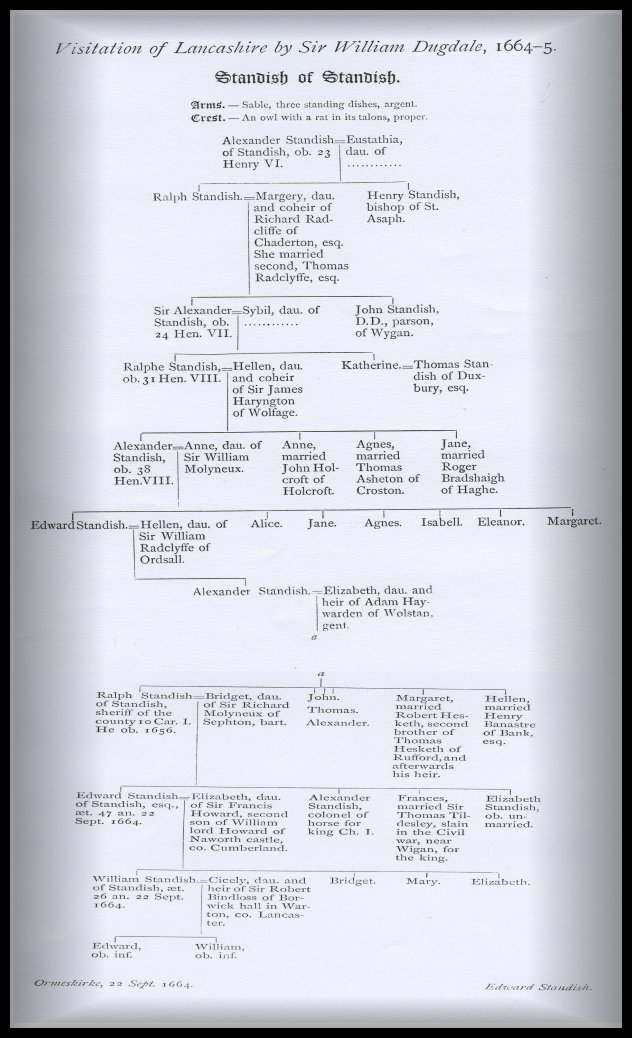
Children of Edward Standish and Elizabeth Howard :
William Standish, son and heir, b. 1638
Frances Standish, m. Major-General Sir Thomas Tyldesley, Knt, of Morley.
Elizabeth Standish, d. unm.
1682 to 1705 AD. William de Standish Lord of the Manor of Standish.
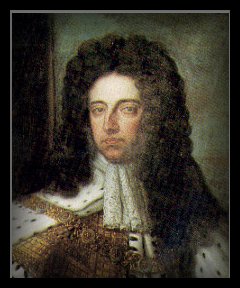
William de Standish.
William Standish son and heir, b.1638 and died in 1705. He married Cecilia daughter and heiress of Sir Robert Bindloss of Worwick.
William Standish was charged with participation in the Lancashire plots of 1690 and 1694; the hall was alleged to have been a meeting place of the conspirators and was accordingly searched. (Lane. Plot (Chet. Soc.), 36-37; Hist. MSS Com. Rep. XIV App. iv 238, 296 &c.)
William, married Cecilia, daughter and heiress of Sir Robert Bindloss of Borwick.
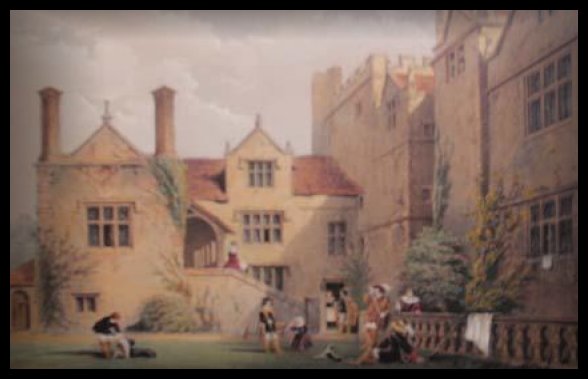
Borwick Hall the home of Cecilia Bindloss.
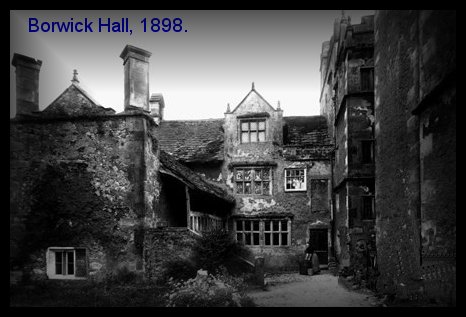
William Standish belonged to the Old Faith of his ancestors and like many others of that Faith resented the coming of William of Orange and looked upoa him as a usurper. Consequently there were many plots to restore the Stuart monarchy by the Jacobites as they were called, and of whom there were many in Lancashire. Standish Hall, secluded and situated among lonely woods, away from the main road, was an ideal meetingplace for conspirators, and William Standish became their ringleader.
At Christmas, 1689, about a year after William of Orange came to England, there was a large party at Standish Hall including many Jacobite sympathisers. Some time later, one of the guests named Robert Dodsworth talked about a conspiracy which, he said, had been discussed at the Hall. He was found murdered shortly afterwards. In April, 1690, Roger Kenyon was given the following information by a friend - “There is a story about a plot in Lancashire which was discovered by one Dodsworth, a Papist. As a result Mr. Standish was beset but I hear that he escaped”. Standish Hall was searched but nothing was found and William was not to be found either.
Four years later another plot was discovered and many Jacobite adherents were arrested (149) and sent for trial in Manchester, eight prominent Lancashire and Cheshire gentlemen among them. In evidence put forward by the Crown, a man named John Lunt said that he had been employed by these men, not only to collect arms but also to help on the murder of William III. John Wombwell, a carrier, testified that he had carried arms from London to Standish Hall where, at meetings in 1692, he had seen a great quantity of arms being distributed among several gentlemen. He named Mr. Molyneux, Sir William Gerard, William Dicconson and Sir Thomas Clifton. Wombwell’s servant, Oliver Pearson, also said he had with his master carried pistols and other arms to Standish Hall. Another accusation was that a servant of William Standish had enlisted men in Standish, Wigan and in other places, for King James, each man being given a shilling. Positions of rank were promised to men from Standish, a procedure which had caused some wrangling. This evidence led to another search of Standish Hall, but only a few saddles and war belts were found, anything else incriminating having been removed to safer places of which Parkbrook was one.
- Eleanor Johnson.

Once again William Standish disappeared and avoided arrest, and a reward of £500 was offered for his apprehension.
There is however a sequel to the above story. Some sixty years later, in 1757, a coppice wall was being rebuilt on the Standish estate near the Hall and the workmen came upon some documents in a hollow place in the wall. The writing was in cipher and could not be read. Fortunately they were not destroyed and the contents remained unknown until, some time in the 1920s, the late Rev. T. C. Porteus managed to work out the key to the cipher. How damning would have been these documents if they had fallen into the hands of the Crown Prosecutors in 1694. Amongst them was a Declaration of Loyalty to King James, which included an assurance that nothing would be wanting when the time came for the King to require their service. The signatures included those of Richard Widdrington, Will Standish, Stephen Tempest, H. Smithson, and Charles Towneley. Another paper, in cipher, revealed a reply from James II approving the arrangements made. There were also military commissions signed by King James and given at the Court of St. Germain. Among the other papers, some in cipher some not, many supported the evidence that had been given at Manchester concerning the plotters. The carrier had said that he carried boxes from London to Standish which had distinctive markings on them, and one of the papers described boxes sent to Standish Hall with the letters G.G. on them, while the following week three more boxes had been sent with the same markings but addressed to the grocer. It would have gone very hard with William Standish and his friends had the papers come to light when the Hall was searched all those years before.In 1696, William made a settlement of the manor and the names of Lady Phillippa Howard and of Lord George Howard appear in the document. It was evidently part of a marriage settlement for In the following year William’s only son and heir married Lady Phillippa who was a daughter of Henry, Duke of Norfolk. William had two daughters. Mary and Cecilia. William Standish died at Woolston in 1705 and was buried at Standish. He was succeeded by Ralph, who, like his father, was an ardent Jacobite. - Eleanor Johnson.
Standish Plot Papers - D/D St. M1 - 3 (not dated).
These documents are held at Wigan Archives Service.
Contents:
Lancashire was particularly strong in
its Jacobite sympathies, and one of the leading plots to restore James II to the
English throne was centred around Standish Hall. The following papers - mainly
correspondence and blank commissions relating to the projected Jacobite
invasions - were found in a garden wall at Standish Hall in 1757, where they had
been hidden some 60 years earlier. Had they been available to the Crown then, it
is most unlikely that the conspirators would have been acquitted at their trial
in Manchester in 1694. Even after they had been discovered, some of the papers
could not be read for over a century and a half, as they were in cipher, the key
to which was only discovered in 1927, by Rev. T.C. Porteus. See his 'New Light
on the Lancashire Jacobite Plot, 1692-4', in Transactions of the Lancashire and
Cheshire Antiquarian Society, vol. L. (available in the Record Office library)
for further background information, and transcriptions of the
correspondence.
1705 to 1755 AD. Ralph de Standish Lord of the Manor of Standish.
Ralph de Standish the Last Male in the line of the House of Standish.
1755. When Ralph de Standish the Last Male in the line of the House of Standish died in 1755 no male claimant came forward from the United States of America to claim title to the Lordship of the Manor of Standish.
1715. When the supporters of the Jacobite cause raised the standard of rebellion in Scotland in 1715 and marched South to place the son of James II on the throne newly occupied by George I, Ralph Standish rode with some of his tenants and servants to join the Scots army at Preston. There a battle took place; the Scots were defeated and surrendered and Ralph Standish was taken prisoner and conveyed to London. As he passed through Wigan he was able to send a letter to his mother who was at Borwick Hall asking her to take his children there, as Lady Phillippa Standish his wife had announced her intention of following him to London so that she could approach friends and relatives to use their influence on his behalf. He was indicted as a “false traitor intending to subvert the good government of the country by exalting the person who took upon himself the title of James III and as one of those in warlike array at Preston on 12thNovember last”.
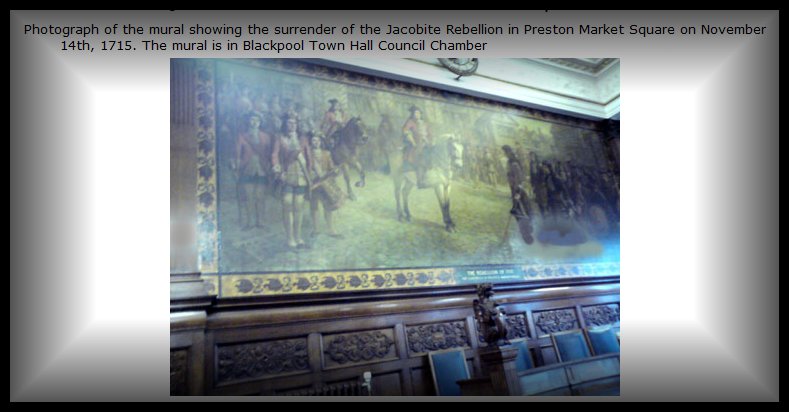


He was tried and found guilty in June 1716, although he pleaded not guilty, and was sentenced to death. However, he was reprieved and released from Newgate Gaol, and his estates which had been seized and sold, were bought back. The Committee for Forfeited Estates had sold them to a Joseph Briscoe in April 1720, and he sold them to the Earl of Lichfield, John Austes and Nicholas Starkie. They made declarations on the 24th May - the day they bought them - to the Duke of Norfolk and to the Dowager Lady Petrie and were apparently acting on behalf of the Standish family.
In 1732, Lady Phillippa Standish wife of Ralph died. She had borne a number of children but several had died in infancy. Ralph, one of her sons, took the name Ralph Standish Howard and went to London under the patronage of the Duke of Norfolk.
Ralph Standish, Lord of the Manor of Standish remarried, his second wife being Mary Hodson. They had two sons, Ralph and Edward, but they both died before their father. Thus, when Ralph died in 1755, none of his sons was living and the estate went to his daughter, Cecilia, who had married William Towneley in 1735. In his will, made in 1750, Ralph left to his wife, Mary, two coach horses named Tinker and Robin, “the silver teapot that I constantly use” and other silver. A string of diamonds and a diamond cross were left to his grand-daughter, Cecilia Towneley; and to his daughter, Cecilia, he left two five guinea pieces, his chariot with harness and four coach horses that he usually drove, while all medals and any curiosities were to be left at Standish Hall to be enjoyed as family heirlooms, including those which had formerly belonged to the Howard family. Among the collection of Ralph’s papers are an account book of his, some correspondence relating to the accounts, a diary and a description of his journey through Flanders in 1720. There are also letters and lists of furniture belonging to the Strickland family. - Eleanor Johnson.
1755 - 1778 AD. CECILIA STANDISH (m. TOWNELEY) (Lady of the Manor).
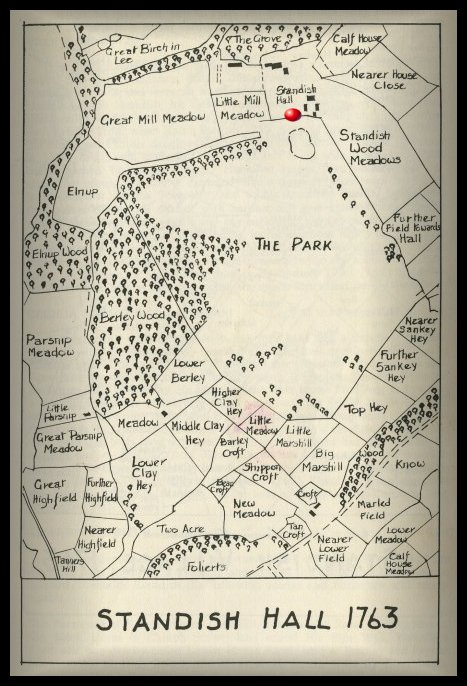
Children of Cecilia Standish and William Towneley .
Charles Towneley,
son and heir of William Towneley and Cecilia Standish was born 1st
He never married and died on 3rd January 1805 and was buried at Burnley.
Ralph Standish Towneley the second son was born 18th June 1739. He married Henrietta, 9th daughter of Roger Strickland, on 28th August 1762. There were no children from this marriage when he died at Paris in March 1766.
Edward Towneley
the third son was born 25th June 1740. He took the surname of Standish in 1766. He married Anne,
only daughter of Basil Thomas Eccleston, on 11th February 1771 at Prescot. She died on 17th May 1801 and was buried at Chiswick.
Edward inherited and assumed the Standish name and as Edward Towneley
Standish became Lord of the Manor when his mother died in 1778, aged
sixty four years. There were no children from this marriage and he died 29th March 1807 and was buried
In 1807 Edward died , and all his brothers had already died before him, Edward had no surviving children, thus the estate and Lordship of the Manor of Standish passed to his sister Cecilia's son, Thomas Strickland, who assumed by sign manual the name Thomas Strickland Standish. Lord of the Manor of Standish 1807 - 1813.
Cecilia, the only daughter of Cecilia Standish and William Towneley.
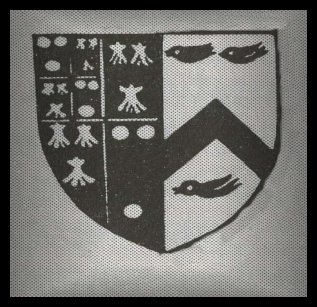
Arms of Strickland - Standish.
Cecilia, the only daughter of Cecilia Standish and William Towneley
Born 30th July 1741. She was married at Standish on 20th
Charles died on 6thOctober 1770 and was buried at Kendal.
Cecilia secondly married Gerard Strickland who died in 1795.
She died in 1814.
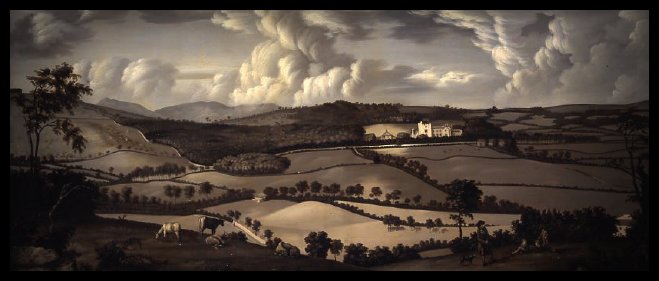
Sizergh Castle.
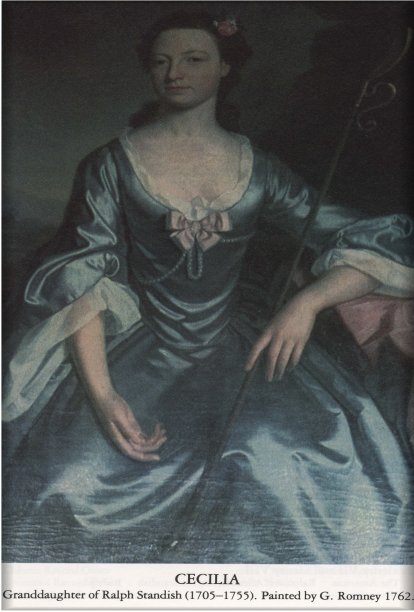
A string of diamonds and a diamond cross were left by Ralph Standish to his grand-daughter, Cecilia Towneley.
1778 . Charles Townley, Lord of the Manor of Standish.
First son of Cecilia Standish and William Towneley.
Charles Townley, (1737–1805), collector of antiquities, was born on 1 October 1737 at Towneley Hall, near Burnley, Lancashire, the eldest in the family of three sons and a younger daughter of William Towneley (1714–1742) and his wife, Cecilia (1714–1777), the fifth daughter and eventual heir of Ralph Standish and his wife, Lady Philippa Howard, the daughter of Henry, sixth duke of Norfolk. The spelling Towneley is now usual for both the family and the place, but Charles, his brother Edward, and their mother all signed themselves Townley.
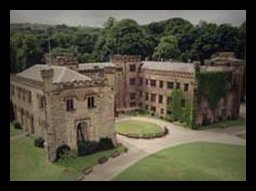
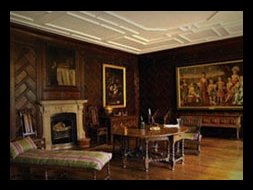
Towneley Hall, Burnley, Lancashire.
Townley was four when his father died on 2 February 1742, and he did not take
control of the estate until he came of age. The family had remained Catholic
after the Reformation, and Townley was sent abroad to the English College at
Douai, entering with his brother Ralph (1739–1766) in 1747. After leaving Douai
in 1753, he was tutored in Paris by the Revd John Turberville Needham and was
introduced to Parisian society by an uncle of his father's, the
Chevalier John Towneley (bap. 1697, d.
1782). Having taken possession of Towneley Hall about 1758, he spent
some years in the social and sporting activities of a country squire before
undertaking the grand tour.
Townley arrived in Rome on 25 December 1767 and stayed until the following
August, visiting Naples and Paestum during March. In Rome he began to collect
antiquities, especially marble sculptures. Many early acquisitions were mere
tourist souvenirs or outright fakes, but he gradually established himself as a
serious collector with purchases from the printmaker Giovanni Battista Piranesi
and other Roman dealers, and especially from the English dealer in art and
antiquities Thomas Jenkins. Shortly before leaving Rome he paid Jenkins £400
for a fragmentary group of two boys quarrelling over a game of knucklebones, Astragalizontes.
During Townley's second and longest visit to Italy, in 1771–4, he spent a year
in Rome and nine months based in Naples, and made extended journeys in southern
Italy and Sicily. In Naples he acquired from the family of Prince Laurenzano a
marble bust traditionally identified as the nymph Clytie, which later appeared
with busts of Homer and Pericles on an ornate calling card engraved by William
Skelton. In Rome he bought antiquities including sculptures from Jenkins,
Thomas Byres, and several Italian dealers, and began to buy direct from the
painter and excavator Gavin Hamilton. From 1773 some expensive items were bought
on credit from Jenkins, on whose death in 1798 Townley was hard pressed to
settle a debt of over £500 with his heir. Among these expensive sculptures were
a statue of Diana at £250 and a group with a nymph struggling to escape the
attentions of a faun, for which Townley paid £350, perhaps influenced by the
group's erotic qualities. Although this work doubtless had a certain piquancy
for an eighteenth-century collector, in a British Museum inventory of 1848 the
group is annotated ‘not exhibited’.
After returning to London, Townley corresponded regularly with Jenkins and
Hamilton and expanded his collection with purchases from both, especially with
sculptures excavated by Hamilton at Monte Cagnolo, Ostia, and elsewhere.
Correspondence with Hamilton was sometimes acrimonious, as Townley complained
of the quality of the sculptures he sent. With Jenkins he was on better terms:
for many years Jenkins supplied Roman gossip as well as sculptures, and Townley
undertook purchases in London for him and his friends, obtaining anything from
scientific instruments to silk stockings. In 1777 Townley spent another three
months in Italy, mainly in Rome, buying as before from Jenkins, Hamilton, and
Italian dealers. Following this last trip to Italy the rate of Townley's acquisitions
decreased, but he continued to receive consignments of antiquities of all kinds
from Jenkins, including a monumental caryatid (BM), similar to one retained for
the papal collection, and other sculptures from the Montalto collection at
Villa Negroni in 1786 and a Roman marble copy of the bronze discus-thrower (discobolus)
by the Greek sculptor Myron (fifth century BC),
found in Hadrian's villa in 1791. He also bought sculptures, coins, and other
antiquities in London, either privately (for example, from Lyde Browne in 1773)
or at auction. Over a period of more than twenty years Townley bought at some
of the most important public sales of antiquities, among them those of Henry
Constantine Jennings (1778), the duchess of Portland's museum (1786), Lord
Cawdor (1800), and Lord Bessborough (1801).
From about 1771 Townley lived in a house in Crown Street (now Whitehall). Early
in 1778 he moved into 7 Park Street (now 14 Queen Anne's Gate), designed by
Samuel Wyatt and built for him by Michael Barrett. Townley was a compulsive
collector. A financial summary drawn up in 1779 shows that he had by then spent
about £11,600 on his collections and almost as much on successive houses,
accounting for almost three-quarters of the £27,700 that he had borrowed on mortgage
and bonds. With experience he became discriminating in his purchases, rejecting
objects wrongly restored with alien heads.
In 1783 Johan Zoffany painted Townley in the midst of an imaginary arrangement
of his sculptures in the library at Park Street, along with the Hon. Charles
Greville, Thomas Astle, and Pierre Hugues, better known as the Barond'Hancarville.
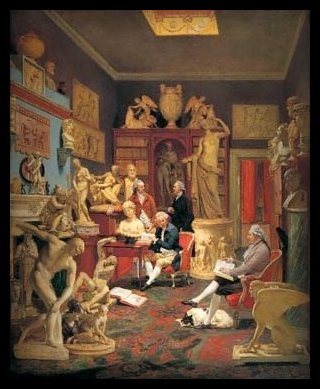
Having fallen under the spell of d'Hancarville's over-ingenious speculations on ancient religion and mythology, Townley engaged him to catalogue
his marbles and supported him for some years from 1777 with hospitality and
frequent ‘loans’.
Townley was elected fellow of the Society of Antiquaries in 1786 (and to its
council in 1798) and fellow of the Royal Society in 1791. In 1786 he was also elected
to the
Society of Dilettanti, and
from 1799 served on a committee appointed to publish engravings and
descriptions of Specimens of Antient Sculpture (drawn
largely from his own collection and that of Richard Payne Knight), which
eventually appeared in 1809. In 1791 he was elected a trustee of the British
Museum, where he influenced the design of the extension planned to house the
museum's growing collection of antiquities.
Townley's youthful sojourn in Paris has been seen as the origin of a dissolute
lifestyle. To his mother's distress he remained unmarried, but very explicit
letters from Richard Payne Knight and various ladies confirm a hint in his
travel diary that he led a far from celibate life. He even became a freemason,
but towards the end of his life he returned to the practice of his childhood
faith.
Townley was reputed a good landlord, considerate of his tenants. He improved
the estate, overseeing the planting of many trees, and was involved in the
construction of the Leeds–Liverpool canal. In London he lived relatively
frugally, having few servants and keeping no carriage (his coach house provided
storage for sculptures). He was, however, a generous host, his Sunday dinners
being highly praised by the sculptor Joseph Nollekens. Other members of his
circle included Sir Joseph Banks, Richard Payne Knight, Sir Joshua Reynolds,
and Richard and Maria Cosway.
Townley's collection became one of the sights of London. Dr Johnson wrote for
an appointment in May 1792, and in The Picture of London for
1802 visitors to the metropolis were advised to apply at the house to
learn the hours of admission to ‘the finest collection of antique statues,
busts, etc, in the world … collected with the utmost taste and judgment’ (Cook,
The Townley Marbles, 7). While no private collector
outside Italy could in fact hope to rival the great Roman collections, it
remains true that the Townley marbles could bear comparison with any collection
in the noble houses of England, even Lansdowne House and Petworth, both of
which included sculptures rejected by Townley's taste and judgement. Visitors
were freely admitted to see the collection. Some were given conducted tours by
Townley himself; for others from about 1786 he provided manuscript catalogues,
which were rewritten as the collection grew and the arrangement changed.
Barred from public life for his religion, Townley devoted much time and energy
to learning, but his only publication was an account of an ornate Roman helmet
found in 1796 at Ribchester in Lancashire, first issued in 1799, and later
appearing in Vetusta monumenta (4, 1815, 1–11, pl.
1–4). He was also a talented amateur artist. Some of his sculptures are now
known only from the drawings he made before disposing of them, and a miniature
of the Medici Venus on ivory remains in the possession of the Towneley family.
Townley died without legitimate issue at his house in Park Street on 3 January
1805 and was buried in the family vault at St Peter's Church, Burnley, on 17
January. His estates
passed first to his brother Edward Townley Standish
(1740–1807), to whom he had already made over the Standish
estates when their mother died, and then to an uncle, the bibliophile John
Towneley (1731–1813).
In his will, dated 29 November 1802, his marbles were bequeathed to the British
Museum, but in a codicil dated 22 December 1804 he left them in trust for his
brother or his uncle on condition that a gallery be built to display them
either at Towneley Hall or in London, and failing that for the British Museum.
John Towneley wished to build a gallery, but Edward was unwilling to undertake
the expense, and a compromise was eventually negotiated under which the marbles
(including all those mentioned above), with some terracottas and bronzes,
passed to the British Museum for £20,000 and (until the passage of the British Museum Act, 1963) the right to nominate a trustee.
After John Towneley's death the small antiquities and drawings were sold to the
British Museum by his son Peregrine Edward Towneley (1762–1846). The arrival at
the British Museum of more than 300 antiquities transformed its collection.
From 1808 the marbles and terracottas were exhibited in a new wing, which had
been planned in Townley's lifetime, but within a decade Townley's mainly Roman
sculptures, many of them copies of earlier Greek works, were overshadowed by
the museum's acquisition of Greek originals, the Bassae frieze and the Elgin
collection. New acquisitions were merged with Townley's sculptures, and,
although they remained ‘the nucleus of the Graeco-Roman series’ (Smith, 3.v),
it was many years before the intrinsic value of Roman sculptures was fully
appreciated, and it was not until 1984 that the museum again had a gallery
dedicated to the Townley marbles.
B. F. Cook.
Nichols,
Illustrations · T. D. Whitaker, An history of the original
parish of Whalley, and honor of Clitheroe, in the counties of Lancaster and
York (1801) · G. Vaughan, ‘Townley, Charles’, The dictionary of art,
ed. J. Turner (1996) · B. F. Cook, The Townley marbles (1985) · S. J.
Hill, Catalogue of the Townley archive at the British Museum, British
Museum Occasional Papers, 138 (2002) · J. Ingamells, ed., A dictionary of
British and Irish travellers in Italy, 1701–1800 (1997) · P. R. Harris,
ed., Douai College documents, 1639–1794, Catholic RS, 63 (1972) · B. F.
Cook, ‘The Townley marbles in Westminster and Bloomsbury’, British Museum
Yearbook, 2 (1977), 34–78 · L. Cust and S. Colvin, eds., History of the
Society of Dilettanti (1898); repr. with suppl. chaps. (1914) · B. F. Cook,
‘A miniature of the Medici Venus executed by Charles Townley, FSA, 1786–1805’, Antiquaries
Journal, 58 (1978), 383 · personal knowledge (2004) · private information
(2004) [Sir Simon Towneley] · A. H. Smith, A catalogue of sculpture in the
department of Greek and Roman antiquities, British Museum, 3 (1904) · A.
Wilton and I. Bignamini, Grand tour (1996) [exhibition catalogue, Tate
Gallery, 1996]
BM,
department of Greek and Roman antiquities · BM, archives · Bodl. Oxf., archives · priv. coll. · Towneley Hall, Museums and Art
Gallery, Burnley, archive
C. Hewetson, marble bust, 1769, BM; repro. in A. Dawson,
Portrait sculpture: a catalogue of the British Museum collection c.
1675–1975 (1999), 218–20, no. 81 · R. Cosway, group portrait, oils, 1771–5,
Towneley Hall, Burnley · J. Brown, pencil drawing, 1772?, NG Scot. · factory of J. Wedgwood, ceramic
medallion, 1780, BM;
repro. in M. Clarke and N. Penny, eds., The arrogant connoisseur: Richard
Payne Knight, 1751–1824 (1982), 146, no. 74 · attrib. W. Tassie, Wedgwood
medallion, c.1780, Wedgwood Museum, Stoke-on-Trent · J. Zoffany, group
portrait, oils, 1781–3, Towneley Hall, Burnley [see illus.] · J. Opie,
oils, c.1783, repro. in A. Earland, John Opie and his circle
(1911), 319; in possession of J. Smith Barry, 1911 · W. Owen, oils, exh. RA
1799 · J. Flight, miniature?, exh. RA 1802 · J. Nollekens, bust, modelled 1805
(from a death mask), repro. in M. Clarke and N. Penny, eds., The arrogant
connoisseur: Richard Payne Knight, 1751–1824 (1982), 143, no. 60 · J.
Nollekens, marble bust, before 1805, BM; version, 1807, Towneley Hall, Burnley · P.
Turnerelli, marble bust, exh. RA 1805 · J. Godby, stipple, pubd 1812 (after J.
Tassie, Wedgwood medallion), BM;
repro. in General Chronicle and Literary Magazine, 5 (1812), facing p.
35 · attrib. T. Gainsborough, oils; photograph in NPG, Heinz archive; formerly
at Leger, 13 Old Bond Street, London · W. H. Worthington, engraving (after
drawing by T. Baxter), repro. in Nicholls, Illustrations, facing p. 721
· W. H. Worthington, engraving (after Zoffany), BM · line engraving, repro. in F. Hugues, Baron
d'Hancarville, Recherches sur l'origine, l'esprit, et le progrès des arts de
la Grèce, 3 vols. (1785), xxv
£15,636 6s. 10d.: PRO death duty
registers, IR 26/95 · Standish received £2000 (value of lease on 7 Park
Street), £1464 (household contents of 7 Park Street), and residue of £12,172 6s.
10d.; excl. collection of antiquities and contents of Towneley Hall
|
© Oxford University Press 2004–5 |
1778 - 1807 AD. EDWARD TOWNELEY - STANDISH (Lord of the Manor)

Arms of Towneley - Standish.
Documentary records of the Standish land holdings are available for the properties belonging to Edward Towneley Standish, the following estates and farms are still recognisable :- The Parsonage or Rectory Farm, Lark Hill, Bessie's Well Farm, Moody House, the Black Horse in Church Street, land round Hie Bibe Well, Wakefield Farm and one nearby called Lower House Farm, land at Bradley and Pepper Lane, much of High Street, the Wheatsheaf, South Villa by Southlands, Grannum's Hey (where Prospect House stands), Cat-i-th-Window Cottage and Farm, the Hermitage, Strickland House (then known as New House), Highfield, Round Moor House, Wigan Lane House (later known as Limes Farm), Limbrick House, Boar's Head Inn, Mere Oaks and Lurdin Lane Farm Jolley Mill, Bowling Green Farm and Primrose Hill Farm, Gunnell's Fold Farm, Robin Hill Farm, Dam House, Jane Standish's House and Windy Harbour Estate. Edward also owned the land called Brimelow and, in addition to the park, a considerable part of Standish Lower Ground. Lists of tenants and the rents they paid are given in the estate account books now in Wigan Library. Further documents dating from about 1500 have now been acquired by the Library from the firm of London solicitors who were acting for the Standish family when the last Lord of the Manor died in 1920. These documents passed into the keeping of the Wigan Library about the end of 1970. There are documents relating to the Church leys dated 1748/9 and to Standish manor about the same time. Standish Hall was first built on its present site in 1574 by Edward Standish, somewhere near to where an older Manor House stood. There have been many alterations and additions to the Hall down the years and the form in which it was at its greatest extension was maintained until 1923, when large sections, including the oldest portion and the chapel, were sold and taken down. The building remaining in the year 1972 conveyed no impression of Standish Hall in its heyday. The original house of 1574 was H shaped, which was typical of the period, and was built of timber and plaster on a stone base. The middle section, which was black and white timbered, as it stood till 1923, was the oldest part.The south wing was rebuilt as a chapel in 1742/3, and in 1748 the three storey brick north wing was added. The Great Hall was originally 36 feet long by 17 feet wide and one of the rooms above it was oak panelled, probably in the late 17th century. Of interest also were two carved oak mantlepieces which had been brought from Borwick Hall (where Ralph Standish's mother lived in 1715), and a panel on which were the Royal Arms with the Garter and motto. Another shield had the Arms of Bindloss of Borwick impaling Eltofts-Byndlos 1603 Eltofts. Other interesting relics were a 17th century panelled ceiling and an 18th century mantel on which were the Royal Arms, without the Scottish and Irish quarters, enclosed by the Garter surmounted by a Crown with a motto and Lion and Griffin supporters. Another panel had the arm of Bindloss impaling Dalton and fireplace had the arms of Standish impaling those of Howard. (165) In Wigan Library there is a picture of Standish Hall in the 18th century and letters relating to the work done there during the lordship of Edward Towneley Standish. He had the moat filled in, about 1780, and made a number of alterations to the Hall. Accompanying the documents in Wigan Library is a plan of Standish in 1764 and documents relating to the Wigan to Chorley turnpike road. There are letters written to various people by Edward Towneley Standish concerning a housing shortage in Standish and to houses built to remedy this want.
Other correspondence concerns the Strickland family with whom there were ties by marriage. Edward's sister, Cecilia, married Charles Strickland, son of Thomas Strickland of Sizergh, her brother, Ralph, having married Henrietta Strickland of Catterick.
Edward died in 1807, and as his brothers had already died and he had no surviving children, the estate passed to his sister's son, Thomas Strickland, who assumed by sign manual the name Thomas Strickland Standish.
The American descendants of Towneley.
Quite a
few descendants of John Towneley and Isabel Sherburne, who married in 1445, had
visited America before 1700. Almost certainly the first was Alexander Whitaker
(1585-1616). His grandmother was Elizabeth Nowell, granddaughter of Grace
Towneley. He settled in Virginia in 1611 and his first hand account of the
country was published as Good News from Virginia in London in 1613. He
never married but his brother Jabez, who also lived for a time in Virginia,
left many Virginian descendants.
Mary
Townley (1614-1662), the sixth daughter of Laurence Townley of Stonehedge and
Jennet Halstead, is shown in the 1664 pedigree to have married Augustine Warner
of Norwich, gent. A number of Mary’s relations had settled in Norwich, then one
of the largest cities in England after London. Augustine Warner (1611-1674)
first went to Virginia in 1628 and it seems that Mary Townley joined him in
1638.There appears to have been a regular emigration of people from East
Lancashire in the following years. It is important to realise that land was
granted to those who could import others to Virginia in the 17th
century and so they encouraged their friends and relations. Laurence Smith,
born in Burnley in March 1629, went to Virginia in 1652. He was the son of
Christopher Smith of Stannihurst and Elizabeth Townley, sister of Mary Townley.
In 1656 and 1657 he was granted land for bringing in others. Sometime before
October 1672, the fourth Laurence Townley of Stone Edge went to Virginia to
marry Sarah Warner, daughter of Augustine and Mary Warner. His brother John may
have gone at the same time because he was granted land in Virginia in 1676.
Many of the Townleys of Virginia who are alive today are descended from this
John Townley.
The descendants of Augustine and Mary included President George Washington whilst those of Laurence and Sarah included General Robert E. Lee.
Further information on the Townleys of
Virginia can be found in two articles by Mary Burton Derrickson McCurdy in the
Virginia Magazine of History and Biography Vol.
Townley of Littleton in America.
Richard Townley 8th son of Nicholas Townley of Littleton went to America
in 1683. He was in the suite of Francis Howard, Lord Effingham who was going to
Virginia as Governor of the Colony. Within two years, Richard had moved to New
Jersey where he married Dame Elizabeth Carteret, widow of Sir Philip Carteret,
first Governor of the Province of New Jersey. They had two sons Effingham and
Charles (c1686-1756) and a daughter Sarah. All the children married and had children
themselves. They were a prolific family and details of the many descendants of
Colonel Richard Townley were published in the Jersey Genealogy column of
the Saturday issues of the Newark (N.J.) Evening News between September 2 and
December 19 1903. Their history is also recorded in Naomi Slater Heydon Looking
back ... (Nemo Publications, Ottawa Ontario,1980).
1807 - 1813 AD. THOMAS STRICKLAND - STANDISH (Lord of the Manor).
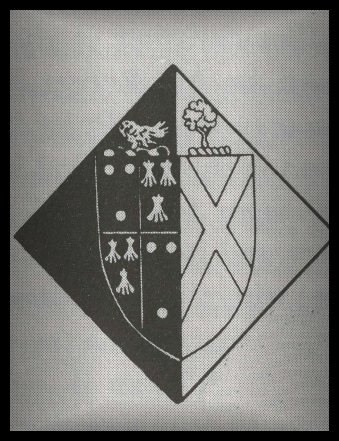
Thomas Strickland Standish was married to Anastasia, daughter of Sir John Lawson of Brough, and they had several children. During the relatively short period he held the manor he became Colonel of the Wigan Militia. (166)
He died in 1813 and was succeeded by his son, Charles Strickland - Standish.
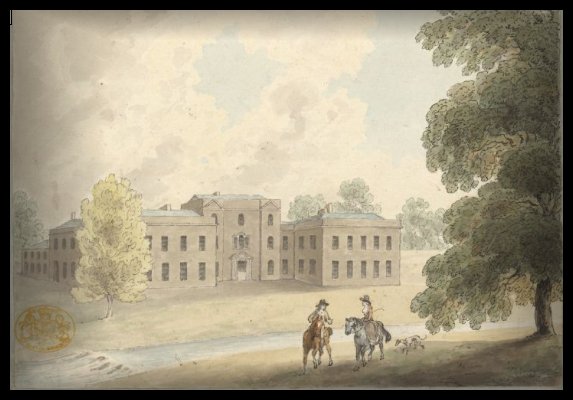
Brough Hall the home of Anastasia Lawson.
Thomas Strickland Standish, the son of Charles and Cecilia, died at York December 4th 1813, and is buried in Standish Church.
1813 - 1863 AD. CHARLES STRICKLAND - STANDISH (Lord of the Manor).
Four years after coming into his inheritance, Charles was appointed Deputy Lieutenant for the County of Lancaster. He married Emmeline Conradinc de Mathieson and they had several children, the sons being named -:
Charles Henry Standish,
Charles Frederick Standish,
Charles Edward Standish,
Their father travelled extensively abroad but did take an interest in politics and was elected Member of Parliament for Wigan, as a Whig, in 1837 and again in 1842-(168) He had by this time, however, ceased residence at Standish Hall, having leased it in 1824 or 1825 to Thomas Darwell, Mayor of Wigan. In fact no Standish ever lived there again, the Hall being occupied by various tenants until its partial demolition in the 1920s. It is said that Charles Strickland Standish was greatly esteemed, his integrity and hospitality were highly praised, he was credited with "the most finished manners" due to his travel and inherent good taste, and his political opponents said his only offence was being a Whig. He died in 1863 and was buried in the family vault in Standish Church, (167)
He was succeeded by his eldest son Charles Henry Widdrington Lionel Standish.
Charles Frederick Standish, (1824 - 1883) second son of Charles Strickland Standish.

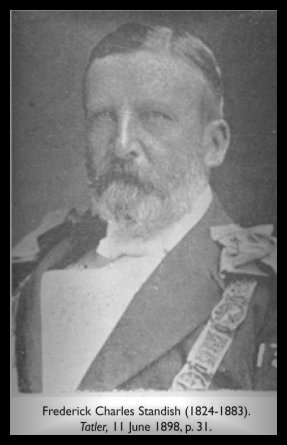
1824-1883. CHARLES FREDERICK STANDISH, government officer, was born on 20 April 1824 at Standish Hall,
Wigan, Lancashire, England, son of Charles Standish, one-time companion of the
prince regent, and his wife Emmeline-Conradine, née de Mathiesen. He was
educated at the Roman Catholic Prior Park College and at the Royal Military
Academy, Woolwich, and was commissioned in the Royal Artillery (second
lieutenant, January 1843; first lieutenant, April 1844; captain, August 1850).
His nine years in the army included a period on the staff of the lord
lieutenant of Ireland. Financed by his father he bought Cayton Hall near
Harrogate, Yorkshire. From 1848 'no backer of horses was better known or more
liked upon English racecourses', but despite his popularity his money losses
were heavy, and in 1852 he sold his mortgaged property and left England for the
colonies.

Cayton Hall near Harrogate, Yorkshire.
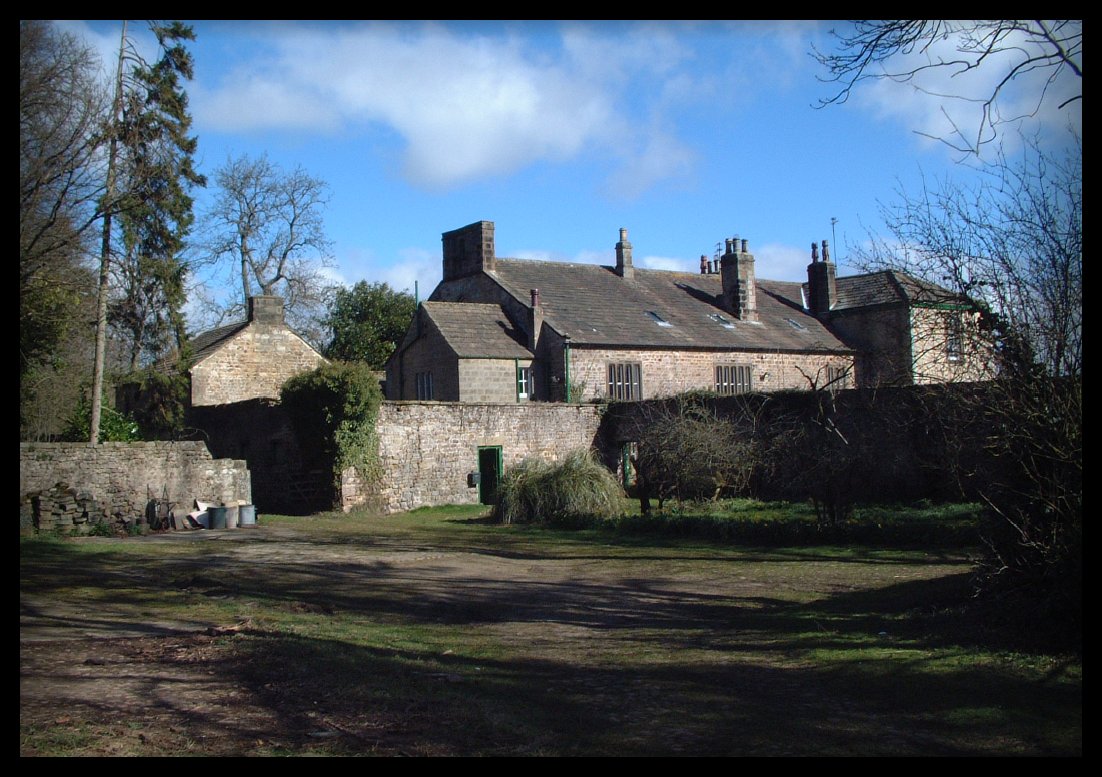
Cayton Hall near Harrogate, Yorkshire.

Standish worked on the gold
diggings in various parts of Victoria until April 1854, when he was appointed
assistant commissioner of the goldfields at Sandhurst (Bendigo) and later was
also protector of the Chinese. He remained at Sandhurst until September 1858
when he was appointed chief commissioner of police in Victoria with salary of
£1200 to succeed Captain
(Sir Charles) MacMahon. Standish remained in charge of the police
force until September 1880, when he retired on a pension of £468. While in the
full vigour of health he was credited with considerable intellectual
administrative skill, and he dealt ably with the secret conspiracies and open
attacks of 1862. He inspired loyalty among his men until his later years, when
his lack of firmness led to a state of disorganization, particularly noticeable
in the heyday of the Kelly
gang. Although there is no evidence to support the legend that Standish
suspended the hunt for the gang when the weights for the Melbourne Cup were
declared, his conduct of the police operations was, according to the 1881 royal
commission on the police, 'not characterized either by good judgment, or by
that zeal for the interests of the public service which should have
distinguished an officer in his position'.

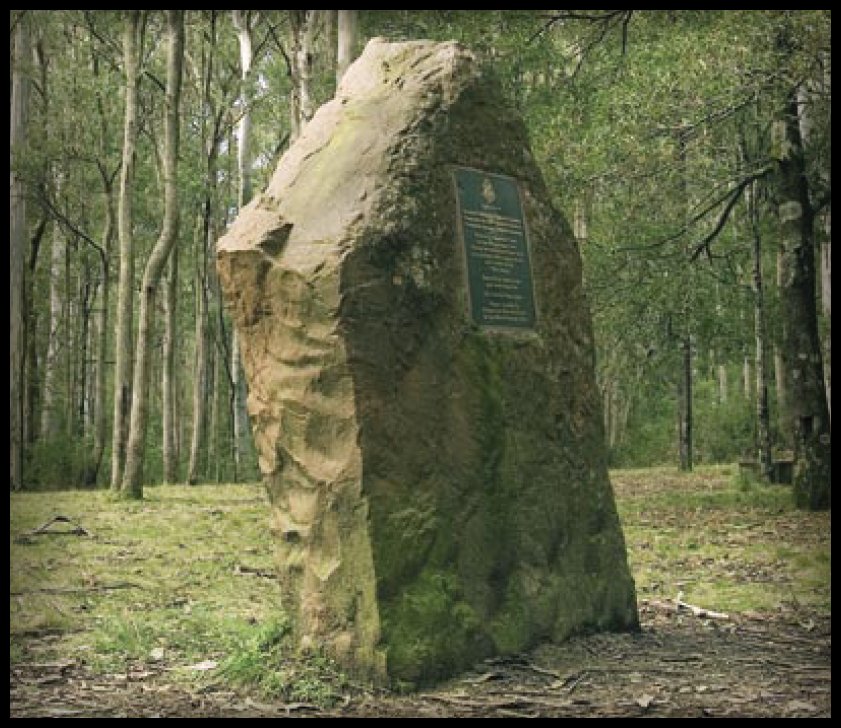
Monument to the officer's killed by the Kelly gang - Victoria, Australia.

Indenture for the benefit of officer's killed by the Kelly gang - signed by Frederick Standish, Victoria Australia.
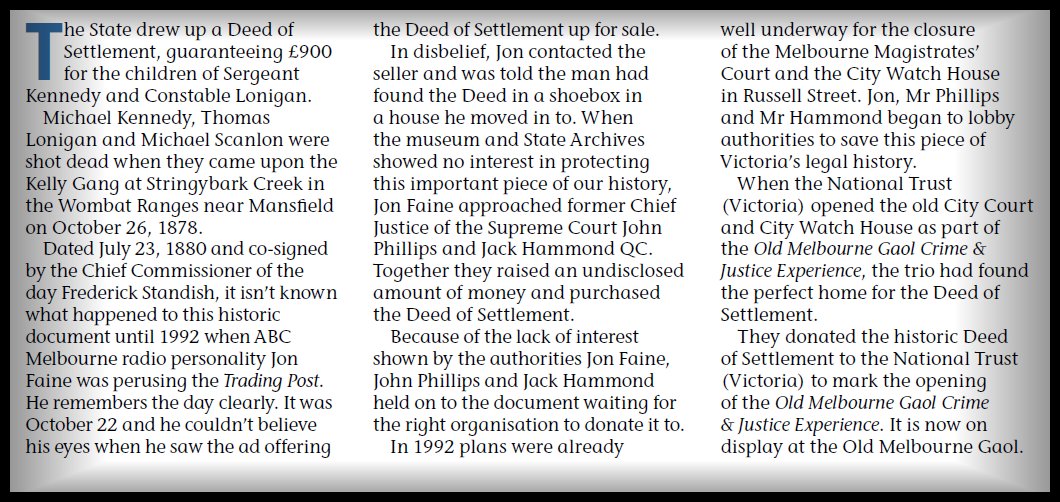
A prominent Freemason, in 1861 Standish was installed as provincial grand master for Victoria (English
constitution). His keen interest in the turf continued and he was for many
years a member and in 1881-83 chairman of the committee of the Victoria Racing
Club. He was an elegant, free-and-easy personality, indolent and addicted to
the delights of the sideboard, the card table and the theatre. His diary,
written in the firm hand of an educated gentleman of the time, reveals an
aimless pursuit of pleasure. According to John Sadleir, this hedonism led
Standish to 'form intimacies with some officers of like mind, and to think less
of others who were much more worthy of regard', but his 'almost pathetic'
affection for Superintendent Frank Hare, notable in the period of the Kelly
pursuit, was a symptom of the mental trouble under which he eventually broke
down. In 1882 he was involved in what was for many years a cause célèbre
when he was almost thrown out of the window of the Melbourne Club by one
Colonel Craigie Halkett, whom he had addressed by a provocative nickname.
H. M. Humphreys (ed), Men of the Time in Australia: Victorian series, 1st ed (Melb, 1878); J. Sadleir, Recollections of a Victorian Police Officer (Melb, 1913); E. Scott, Historical Memoir of the Melbourne Club (Melb, 1936); N. A. Hudleston, Stainley and Cayton (Scarborough, 1956); Votes and Proceedings (Legislative Assembly, Victoria), 1881, 3 (1); Bulletin, 30 June 1883; J. A. Panton autobiography, and F. C. Standish diary (State Library of Victoria).
Author: J. S. Legge
Print Publication
Details: J. S.
Legge, 'Standish, Frederick Charles (1824 - 1883)', Australian Dictionary
of Biography, Volume 6, Melbourne University Press, 1976, pp 172-173.
1863 – 1883 AD. CHARLES HENRY WIDDRINGTON LIONEL - STANDISH (Lord of the Manor).
Although inheriting the Standish estates, Charles Henry never resided on them, spending most of his time on the continent.
He married a French lady with a very distinguished French family tree - Angelique Leontine Sabine de Noailles.
Charles Henry died in 1883 and his only son, Henry Noailles Widdrington Standish, succeeded to the Standish estate.

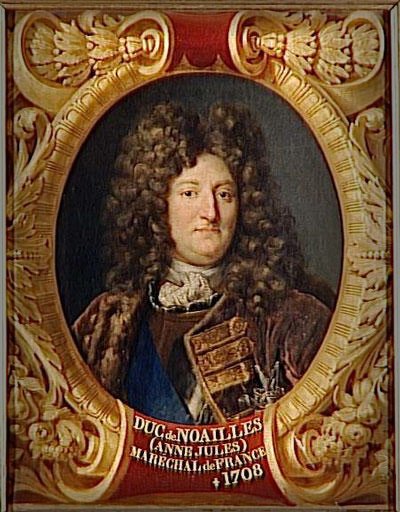
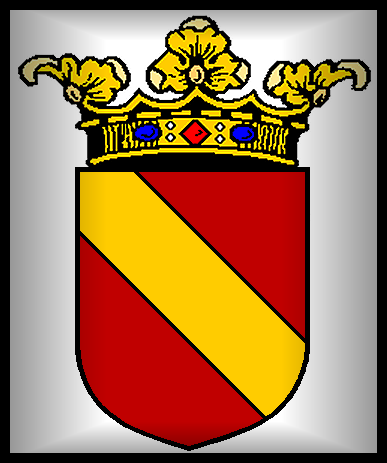
Arms of de Noailles.

Chateau of Rambouilet .
Family tree of Angelique Leontine Sabine de Noailles.
Antonin Claude Dominique Just de
Noailles ( 22 August 1777 (Paris) - August 1846 (Paris) ), seventh prince of pitch then ( 1834 ), fourth Duke Spanish Mouchy third Mouchy French duke and duke of pitch , was also a French politician.
He was the son of Philippe Louis Marc Antoine de Noailles ( 1752 -1819 ), and the Duchess Anne Marie Louise de Beauvau ( 1750 - 1834 ).
Antonin Claude Dominique Just de
Noailles married on 11 May 1803 Frances Xaviere Melanie Honorine de Talleyrand-Perigord ( 18 September 1785 (Paris) - 19 February 1863 - Versailles ), lady of the bedchamber of Madame , Duchesse de Berry , niece of Prince Talleyrand and daughter of Archambaud
Louis-Joseph ( September 1762 (Paris) - 3 May -1838 - Saint-Germain-en-Laye ), Duc de Talleyrand-Perigord , Lieutenant General in the royal army, and
Madelaine-Henrietta Sabine Olivier de-Senozan Viriville ( 1764 - 26 July 1794 ), died a victim of the Revolutionary Tribunal .
They had four children:
1.
Philippe de Noailles ( 1808 - 1854 ), 5th Duke of Mouchy , duke of pitch ;
2.
Charles Antony ( March 13 1810 - August 24th 1852 - Chateau du Val ( Seine-et-Marne ), Count of Noailles , Commander of the Legion of Honor , married in 1849 Anne Marie Elena Cosvelt;
3.
Adelaide Amedee Louis ( October 9 1811 - 27 February 1860 - Valves ), Secretary of Embassy ;
4. . Angelique Leontine Sabine Alexandrine ( 13 May 1819 - Paris ), married ( 5 September 1846 ) Charles Henry Widdrington Lionel Standish-( 1823 - 1920 ).

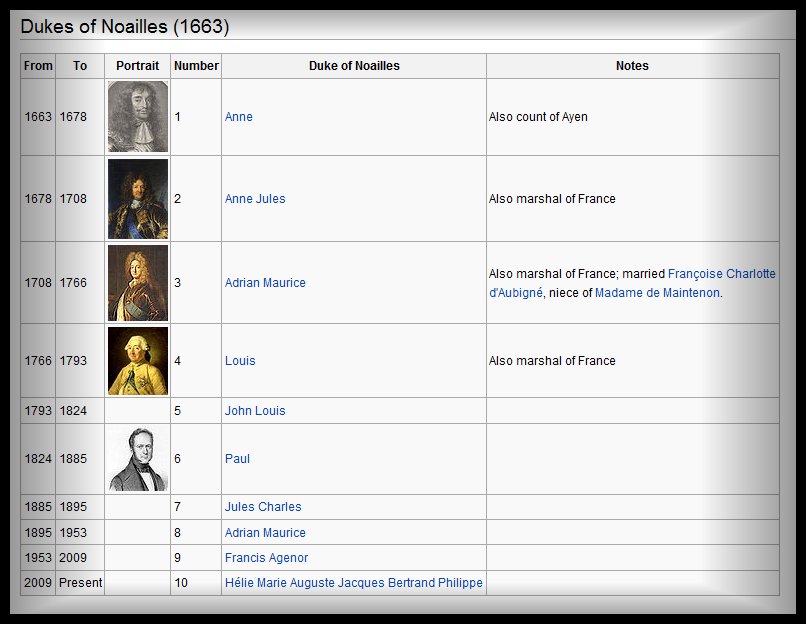
1883 – 1920 AD. HENRY NOAILLES WIDDRINGTON - STANDISH (Lord of the Manor).
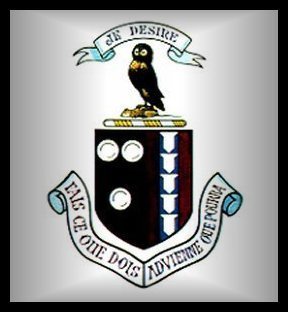
The Last Male in the line of descent from Cecilia Standish.
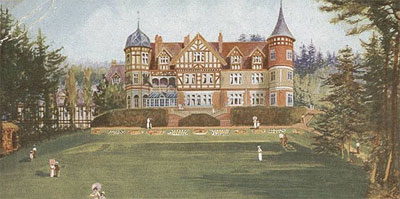
Berystede House in Ascot, Berkshire, England. Home of Henry & Helen Standish.
Henry spent all his life on the continent and never lived at Standish Hall.

HENRY NOAILLES WIDDRINGTON - STANDISH also like his father married a French lady with a very distinguished French family tree - Helene de Perusse.
Helene de Perusse, daughter of the French Comte Des Cars.

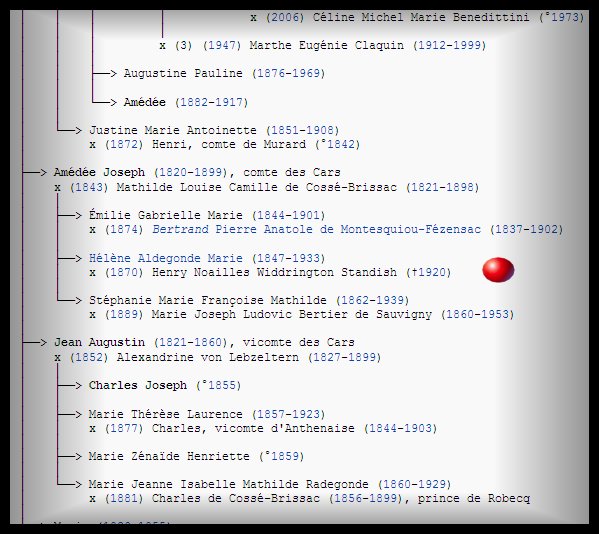
, Family Members.jpg)

Helen de Cars wife of Henry.N.W STANDISH.
, Castle.jpg)
The Cars (Haute-Vienne, Fr), ruins of Castle ancestral home of Helen de Cars.

Château de Hauteville home of Helen de Cars.
When Henry died in 1920, at Contreville in France, he
left no children. Thus the ancient and illustrious house of Standish officially came to an end. Madame de Standish presented many of the
Standish documents to the Wigan Library but a large number of other papers
remained with the London solicitors of the estate. These have recently (in 1970) been handed over to the Wigan
Library and have provided further information about the family.
2010. Berystede Hotel, Ascot, Berkshire, England.

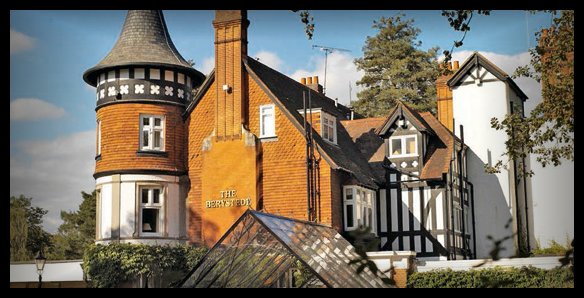
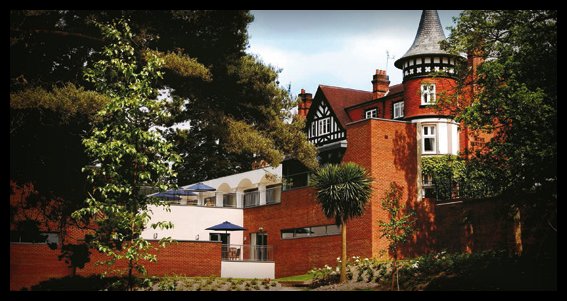
2010. Berystede Hotel at Ascot, Berkshire, England.
BERYSTEDE HOTEL & SPA - ASCOT England.
![]()
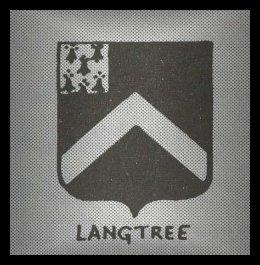
Arms of Langtree.
EDITH SPILEMAN (daughter of Richard Spileman), married Siward Leising .
Radulphus Leising and Siward Leising sons of the Rector Leising each having married a daughter of Richard Spileman by one of the heiresses of the Bussells, barons of Penwortham, and lords of the wapentake of Leyland in Lancashire.
The de Standish and de Langtree families appear about the year 1200, with Ralph de Standish and Siward de Langtree.
The members of the Langtree family were in early times called “de Standish”, for the two manors of Standish and Langtree were held in common for some years by Richard Spileman.
Siward de Standish was fined in 1177/8; a witness in 1185; and in the period of 1189/94, signed a deed. His wife, Edith, together with Juliana, wife of Ralph de Standish witness a grant made by Alina de Darlaston.
Siward made a division with Ralph de Standish in 1206. Siward also received a caracute of land in Langtree and other lands. He gave lands to Cockersand Abbey.
RICHARD de LANGTREE succeeded his father, in 1219. He also gave land to Cockersand Abbey. He appears as "Richard de Standish", with his sons Henry and Hugh about 1220, when he made over his moiety of the advowson to the Standishes.1312. Hugh de Haydock the son of Sir Robert de Haydock was granted land (Bradley) in Langtree by Henry de Langtree.
GILBERT de LANGTREE, son of Richard, succeeded, and in 1377 granted turbary in Hodspull Moss to Robert son of Edmund de Standish, in exchange for Robert's right to pasture in Langtree.
He was in the King's service in Ireland in 1399. In 1410, he made a grant of land in Liverpool, using a seal which bore a shield with a
chevron and a canton ermine, the crest being a tree (for Langtree). He was
living in 1412.
RICHARD de LANGTREE, son of Gilbert, succeeded, and had married by papal dispensation, 1405, Isabel daughter of the late Ralph de Standish. An estate called Standish Wood was settled upon them in 1406.
GILBERT LANGTREE, born about 1530. He married Helena Stanley in 1562, and recorded a pedigree in 1567. In 1588, he made a settlement of his lands. The estate lay in Langtree, Standish, Shevington and Worthington. He died in May 1595.
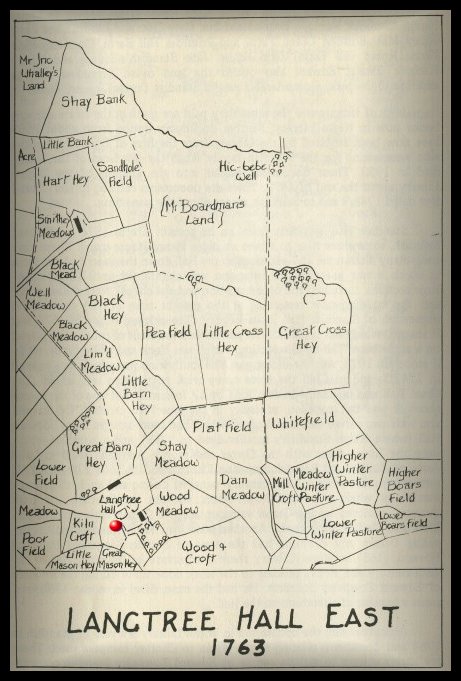
Lancs. Pipe R. 38. Siward de Langtree's name occurs in a charter made about 1190; ibid. 378.
Cockersand Chartul. ii, 513; he gave land called Wallcroft in his vill of Langtree, bounded on the east by Perburn, on the south by Worthington and a road to the west, by a valley and stream on the other sides. From this it seems that the brook bounding Standish on the north was the Perburn.
Cockersand Chartul. ii, 515. The bounds of one grant were defined by Aspensnape, Tathelache and Perburn, and of another by the Harestan between Langtree and Worthington, the great brook up to Beleford, up by a certain shady place (wascellum) between Littlecroft and Wetbutts, by ditches and crosses to the cross in Greenlache, and so to the starting-point.
In 1276 William son of William de Preston and Eleanor his wife claimed a tenement in Standish against Henry de Langtree, but were unsuccessful; Assize R. 405, m. 1 d.
Henry de Langtree in the time of Jordan de Standish made a grant of land lying near the boundaries of Wigan; Standish D. (Mrs. Tempest's abstract), no. 7.70Lancs. Inq. and Extents, i, 269.
William son of Henry de Langtree gave a release of land granted by his father; Kuerden MSS. ii, fol. 145b.
From Thomas de Langtree living in the time of Edward II the pedigree is given thus in a pleading of 1429:— Thomas —s. Thomas—s. Richard —s. Gilbert —s. Richard, the plaintiff; Pal. of Lanc. Plea R. 2, m. 31. The dispute arose from a grant by the first-named Thomas to John son of Ralph de Bradshagh in 1311 of 3 acres of land and waste lying together in the vill of Standish and Langtree at a rent of 12½d. Adam son of Ralph de Bradshagh was in 1313–14 plaintiff against Thomas de Langtree in a plea of mort d'ancestor; Assize R. 424, m. 4 d.
Richard son of Thomas de Langtree in 1341 paid 12d. to the lord of Penwortham as relief on succeeding; Mins. Accts. bdle. 1091, no. 6. In the same year he allowed Dame Mabel de Bradshagh for her life his attachment of the water of Douglas at a rent of 2s. (Bradshaw D.); and in 1348 gave John de Standish licence to make a mill on the Douglas between the mills of Worthington and Haigh, in return for 2½ acres of land; Standish D. (Local Glean.) no. 35.
In 1370 Margery widow of Richard de Langtree claimed a third part of the manor of Langtree against Thomas de Langtree.
Gilbert son of Richard de Langtree in 1377–8 granted to Robert son of Edmund de Standish right of turbary at Hodspull in the vill of Standish in exchange for Robert's claim to the waste in Langtree; Standish D. (Local Glean.), no. 63. In the preceding year Gilbert de Langtree and his wife Alice, daughter of Robert de Winstanley, are mentioned, Gilbert being bound to pay £40 in case he moved for a divorce; Add. MS. 32105, no. 339.
In 1383–4 Gilbert made a settlement of his manor of Langtree; Standish D. (Local Glean.), no. 357. Gilbert was still living in 1401; Dep. Keeper's Rep. xxxiii, App. 2.
Richard son of Gilbert de Langtree was married by dispensation to Elizabeth daughter of Ralph de Standish, and land called Standish Wood was settled upon them, with remainders to Richard's brothers, Ralph, Gilbert, Robert and Henry; Standish D. (Local Glean.), no. 363. In another deed (no. 124) Richard is described as grandson of Richard de Langtree.
The next known possessor is Lawrence Langtree, with whom the recorded pedigree begins. He was witness to a deed in 1458; Standish D. (Mrs. Tempest), no. 146. He had disputes with the Standish family, and Gilbert his son was a party to them in 1484–5; ibid. (Local Glean.), no. 172. Gilbert Langtree ten years later received £2, portion of damages awarded him against Lawrence Standish; Standish D. no. 180.73Duchy of Lanc. Inq. p.m. vi, no. 55.
John Langtree's name appears in the Visit. of 1533 (Chet. Soc. 191), but the herald had not spoken with him and no particulars are given.
Duchy of Lanc. Inq. p.m. xi, no. 18; the estate included a water-mill in Standish and Langtree.
John Langtree had in 1562 purchased messuages in Standish, &c., from Richard Rutter; Pal. of Lanc. Feet of F. bdle. 22, m. 87.
Pal. of Lanc. Feet of F. bdle. 50, m. 212. Administration of Gilbert's estate was granted in Feb. 1596–7; Wills (Chet. Soc. new ser.), i, 218.His son Edward succeeded, and died in 1619 holding the manor of Langtree and various lands as before; Thomas, his son and heir, was not quite of full age; Lancs. Inq. p.m. (Rec. Soc. Lancs. and Ches.), ii, 207.Thomas Langtree made a settlement of his manor and lands soon after coming of age; Pal. of Lanc. Feet of F. bdle. 99, no. 13.
Misc. (Rec. Soc. Lancs. and Ches.), i, 167. Thomas Langtree in 1631 paid £10 on refusing knighthood; ibid. i, 214.
Royalist Comp. Papers (Rec. Soc. Lancs. and Ches.), iv, 59–64. alhough Thomas Langtree appears to have avoided any share in the war, his son Edward served with Prince Rupert. Hence the father's whole estate in Leyland Hundred was sequestered for 'delinquency ' and two-thirds of that in Amounderness for 'recusancy only. Index of Royalists (Index Soc.), 43. The purchaser was Samuel Foxley of Westminster, the estate being described as 'half the manors of Langtree, Standish, Coppull, Worthington and Swarbreck'; Cal. Com. for Comp. iv, 2660.
Thomas Langtree, Edward his son, Samuel and Joshua Foxley were deforciants in a fine of 1655 relating to the manor of Langtree and lands in Standish, Langtree, Wigan and Worthington; Pal. of Lanc. Feet of F. bdle. 157, m. 97.
The Langtree family are found among the recusants convict.' (fn. 78)
The heavy penalties resulting contributed to their ruin, although Thomas Langtree, lord of the manor during the Commonwealth, did not take any active part against the Parliament, his lands were sequestered for recusancy, and he was overwhelmed with debt. (fn. 79)
The estate was confiscated in 1652 and sold, (fn. 80) and the family disappears from view. (fn. 81)
The manor also ceases to be named after 1652.
1841 Census - the residents of Langtree Old Hall.
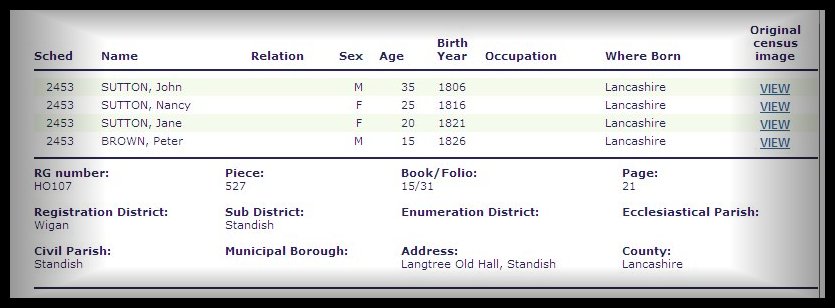
1841 Census - the residents of Langtree New Hall.

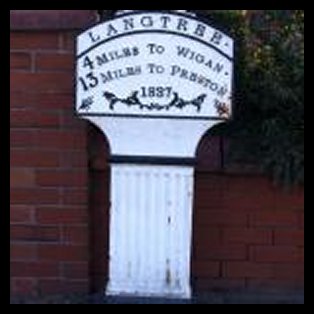

The Meadow's of Langtree Manor Summer 2009.
![]()
The Haydock Family and the Manor of Haydock Lancashire England.
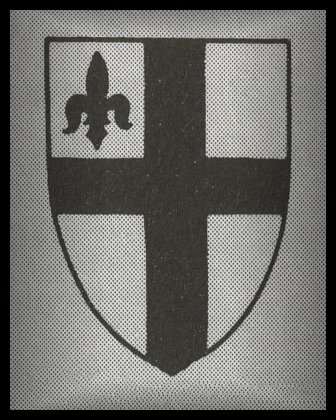
Arms of the Haydock Family.
Haydock of Haydock. Argent a cross with a fleur-de-lis sable in the first quarter
Hugh Haydock de Standish. the originator of the Duxbury branch of the Standish family.
Jordan de Standish bequeathed some land to the children of Rector Robert de Haydock who was married to Jordan's sister. Hugh a son of Sir Robert de Haydock was the originator of the Duxbury branch of the Standish family who became Lords of the Manor of Duxbury. The last male of this line was Sir Frank Standish who died in 1812.
1312. Hugh de Haydock the son of Sir Robert de Haydock was granted land (Bradley) in Langtree by Henry de Langtree. Other adjoining lands within Standish were granted to Hugh de Haydock by Robert de Worthington and William de Standish.
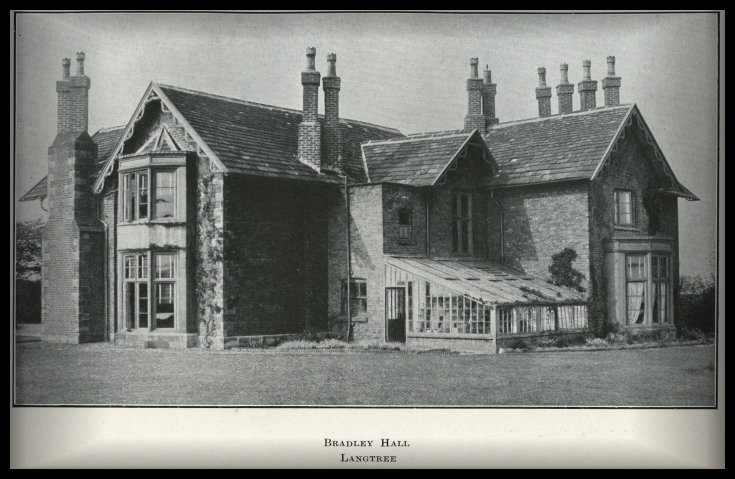
1841 Census - the residents of Bradley Hall.
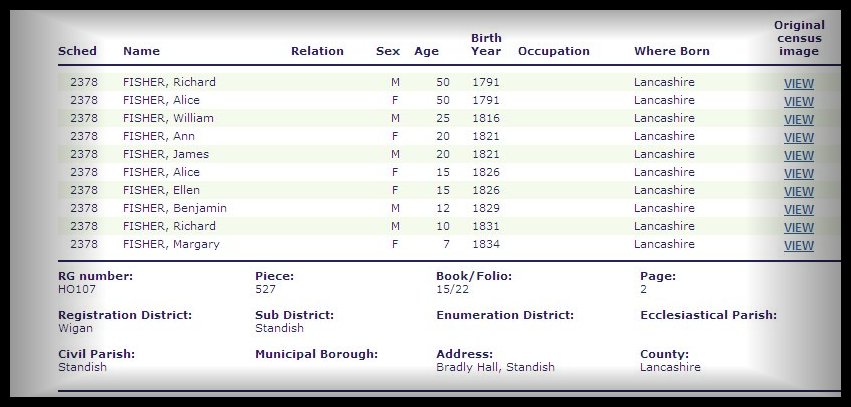
Henry de Langtree gave Bradley to Hugh son of Robert de Haydock, rector of Standish; Kuerden MSS. iii, W 26.
The Bradley estate in Standish was settled by fine in 1304; FinalConc. i, 204. In Kuerden MSS. vi, fol. 96, are a number of short notes of Standish of Duxbury deeds relating to acquisitions of land in Standish by Hugh Haydock de Standish and his successors. Bradley was in 1471 in the possession of Christopher son and heir of James Standish lord of Duxbury; no. 101.
A 'manor of Bradley,' of tenure unknown, was held by Thomas Standish lord of Duxbury in 1517, being occupied by his mother Alice; Duchy of Lanc. Inq. p.m. v, no. 11; see also Lancs. Inq. p.m. (Rec. Soc. Lancs. and Ches.), iii, 398.
Hugh Cooper, the benefactor of Chorley, records in his will (1682) that he had purchased Bradley from Sir Richard Standish; he bequeathed it to his grandson Hugh Warren. 83Baines, Lancs. (ed. 1870), ii, 161.
Roger Haydock, Quaker preacher.
1643–1696. Roger Haydock, Quaker preacher, was born at Coppull, in the parish of Standish, Lancashire, on 1 May 1643, the second son of Roger Haydock (d. 1670), and his wife, Alice Nightingale. He was baptized in the parish the following day. He was educated but where is not known. In 1667 Roger's brother, John, became a Friend. This conversion upset their mother, who is recorded as being inclined to presbyterianism, and she apparently enlisted Roger's help in dissuading his brother. The result, however, was that Roger likewise converted in November 1667. The brothers began to travel to Quaker meetings throughout Lancashire. In April 1668 they were both arrested at a meeting in Bury and were imprisoned at Lancaster Castle for some months. Roger was again apprehended in January 1669 for attending three meetings at Bury and was fined £15 by the Manchester quarter sessions. On the death of his father in 1670, John inherited the estate at Bogburn Hall, Coppull, Lancashire, England where Roger acted as steward in his brother's absences.
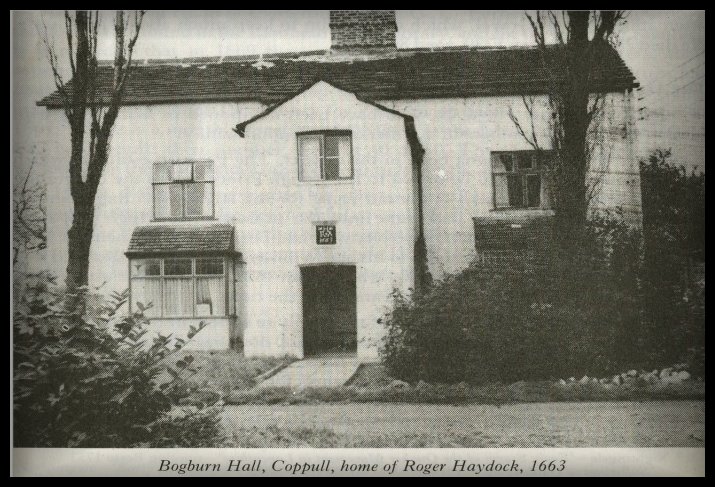
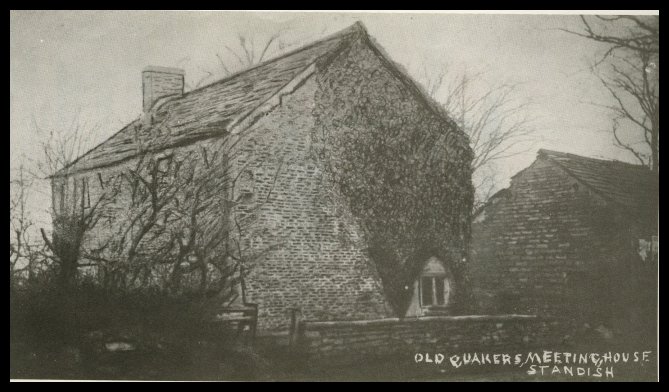
Manor of Haydock
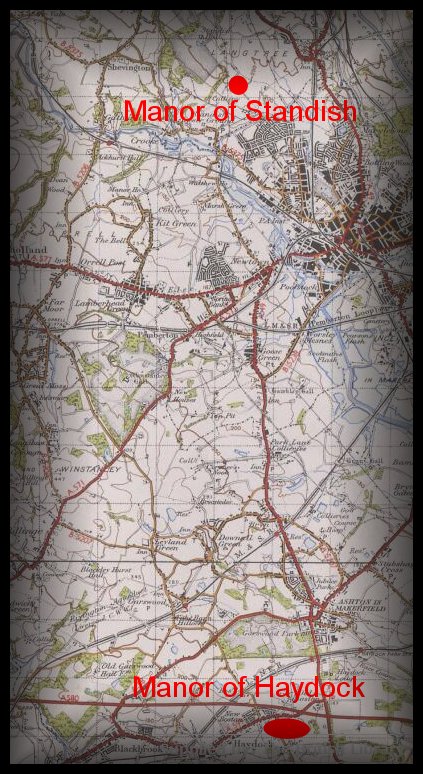
Hugh de Haydock of 1212 married a daughter of Adam de Lawton; ibid. 73.
Hugh de Haydock granted to William de Coldcotes, in free marriage with Amice his daughter, land in Haydock which Henry Roebuck formerly held in Fathercroft; Raines, loc. cit. 221. The grantee afterwards restored it to Gilbert son of Hugh, for '100s. given in his great need'; ibid.14Ibid. 277; Cronshaw, Timberhead, and Blacklache are named among the bounds.
Hugh de Haydock, rector of Standish and Robert de Holland rector of Winwick, are among the witnesses.
Hugh de Haydock had a son Gilbert, who married Alice daughter of Matthew de Bold, and received lands in Bold with her. (fn. 14)
Their son and heir was named Matthew, and in 1286 ten messuages, eight oxgangs and 4 acres of land in Haydock and Bold were settled on Matthew by his father, (fn. 15) and the moiety of the manor of Haydock was granted in 1292. (fn. 16)
Matthew de Haydock lived till about 1322; (fn. 19) a number of his charters are extant, (fn. 20) showing that he acquired fresh properties; one of these, in Walton le Dale, he gave to his son Hugh. (fn. 21)
His son Gilbert succeeded. He had a grant of free warren in Haydock and Bradley, Langtree in the year 1344; also leave to make a park in Haydock. (fn. 22)
By his wife Emma (fn. 23) there was a numerous offspring, but elder sons, named Matthew and Gilbert, seem to have died young, (fn. 24) and the heir to the manor was John de Haydock, who was in possession by 1358. (fn. 25) John de Haydock married Joan, daughter of Sir Thomas de Dutton, (fn. 26) and died 12 December 1387, holding the moiety of the manor of Haydock and lands there of Sir John de Holland of Thorpe Watervill in socage by a rent of 17s.; holding also various lands in Newton, Golborne, and Bold.
His son and heir Gilbert was thirty years of age. (fn. 27) Of Sir Gilbert's children the heir was his daughter Joan, who carried this and other manors to the family of her first husband, Peter de Legh of Lyme in Cheshire. (fn. 28) She afterwards married Sir Richard de Molyneux of Sefton, and her tomb is in Sefton Church. (fn. 29) The manor has since remained a part of the Legh inheritance, (fn. 30)
The American branch of the Haydock family.

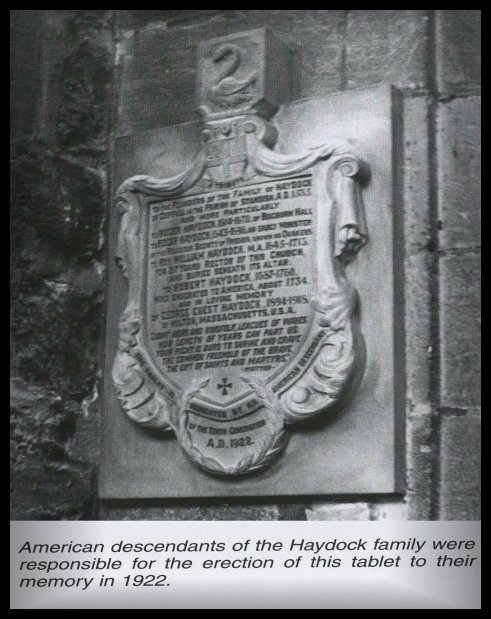
Memorial in Standish Parish Church Lancashire, England.
In 1700 John Haydock published A Collection of the Christian Writings, an anthology of his brother's works, which includes an account of Haydock's life and death together with testimonials from Eleanor Haydock and other Friends. It also included the claim that he had traveled nearly 33,000 miles during his career, and ministered to more than 2600 meetings. Haydock's will, proved at Chester in 1701 some five years after his death, bequeathed half his estate to his wife with bequests to his son, nephews, and nieces. Eleanor Haydock outlived her husband by many years. She was also a zealous Quaker, traveling throughout the country to meetings. She died in 1723. In 1743 their son Robert emigrated with his family to America, where they eventually settled in Flushing, Long Island. In 1922 a memorial was raised in Standish parish church to the Haydock family, which commemorates not only Roger Haydock but also his father, his son, and Roger's brother William, rector of Standish from 1678 until 1713.
![]()
1871. The Owl the Rat and the Myles Standish Monument - USA.
Thank you to Mr. Thomas Waller, London, Ontario, Canada - owner of the plate shown below.
Rowland & Marsellus Co.
Rowland & Marsellus were importers, wholesalers and retailers, especially of 'souvenir' wares operating out of New York USA.
The dealt with numerous Stoke-on-Trent pottery manufacturers and then sold the wares (with their R&M back stamp) to other distributors in the US.
The mark on the bottom is a diamond with "R & M Co" this item is believed to have been produced by British Anchor Pottery Co. for Rowland & Marsellus of New York.
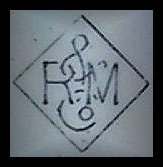
Why the souvenir ware was fired with the Owl - Rat and standing dishes is an interesting question?
![]()
The last Lord of the Manor 1883 - 1921 used his own individual arms as did each of the Lords of the Manor of Standish before him.

Arms of Lord of the Manor of Standish 1883 - 1921
![]()

Arms of Lord of the Manor of Standish 1396 - 1418.

Ralph Lord of the Manor of Standish 1396 - 1418 used the Owl and Rat upon his seal, but not as the crest above his arms. Ralph did not use the standing dishes upon his arms.
![]()

Arms of Lord of the Manor of Standish - Ralph Standish from 1507 - 1538.
Arms of Lord of the Manor of Standish - used by Thurstan Standish and family of the Burgh at Duxbury (brother of Ralph) from 1507.
![]()
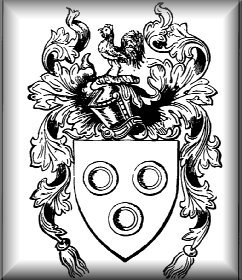
Arms of Lord of the Manor of Duxbury - Thomas Standish from 1507.
Arms of Lord of the Manor of Duxbury - used also by the Irish branch of the Standish Family.
![]()
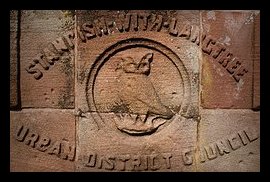
Owl & Rat logo of the Standish with Langtree Urban Distict Council.
![]()
The Sale of Standish Hall on the 17th and 18th
of March, 1921.
In 1921, the Wigan Observer reported that "The two day
sale of the Standish Hall Estate which began on Thursday last week at the
Empress Hall was concluded on Friday. Over £55,000 was realised by the week-end
as a result of the lots sold privately and under the hammer. The Hall, a
mansion of the Queen Anne Type, was withdrawn at £4,800. The auctioneers stated
that an offer of £3,000 had been received for the fine oak paneling alone.
This offer came from America.


1921. Dining Room Standish Hall.
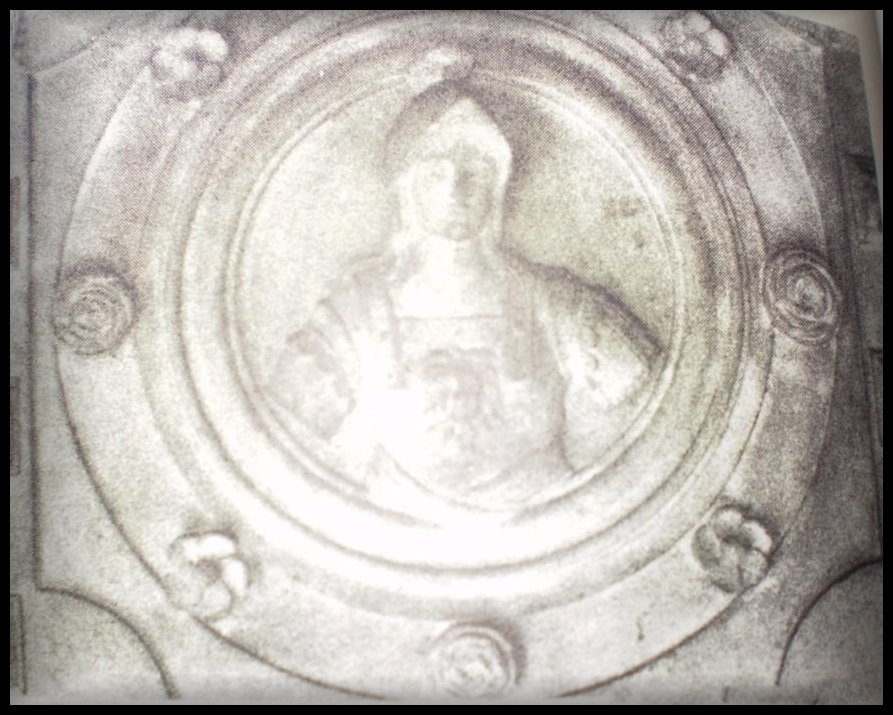
1921. Dining Room Standish Hall.
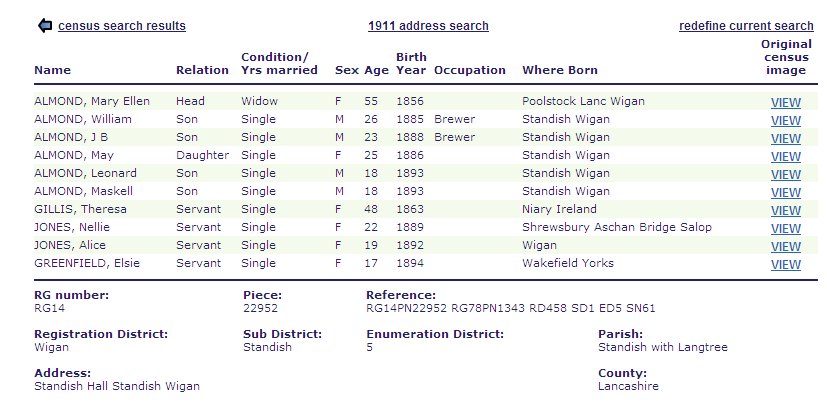
1911. Census. The Almond family the last residents of Standish Hall.
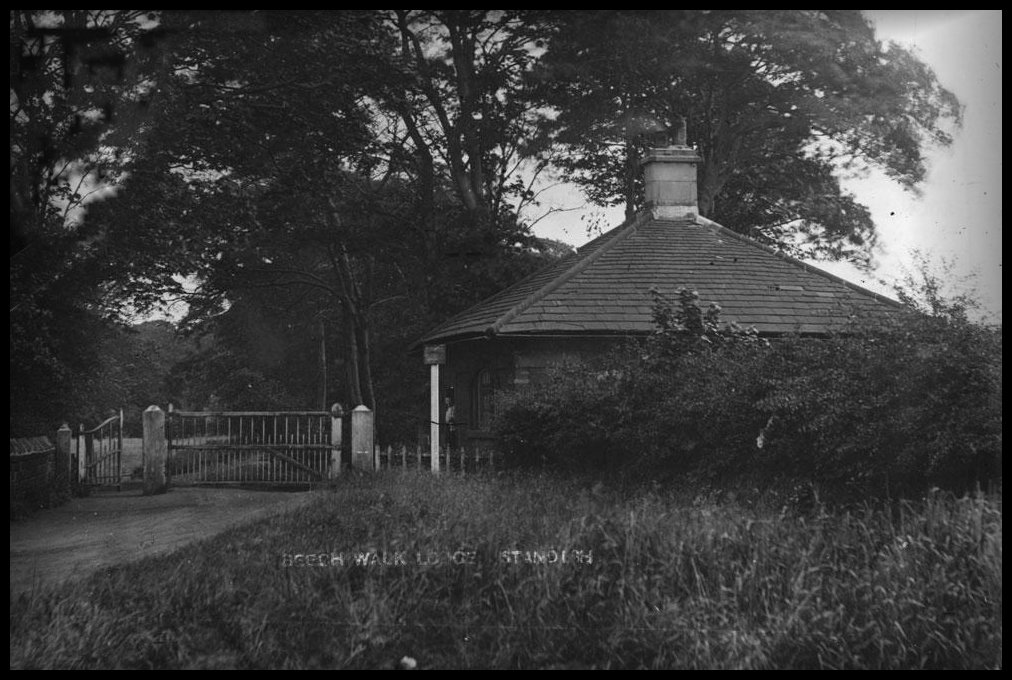
1921. Beech Walk Lodge - entrance to Standish Hall.

Beech Walk - entrance to Standish Hall.
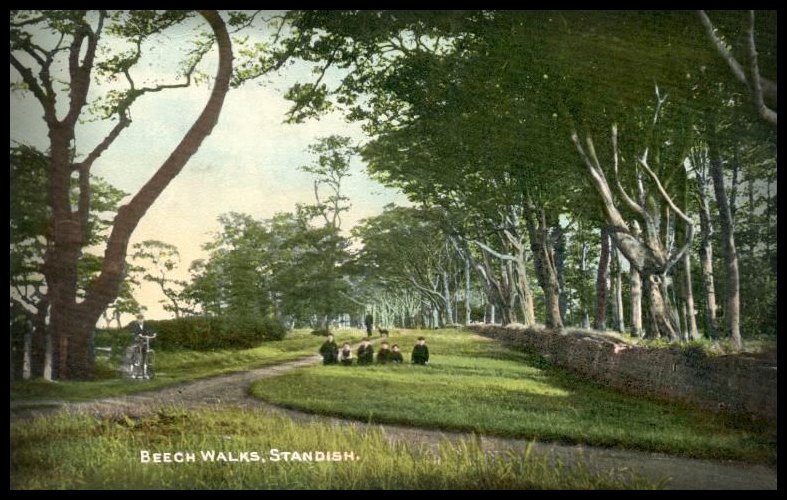
Beech Walk - entrance to Standish Hall.

Standish Hall Woods.
![]()
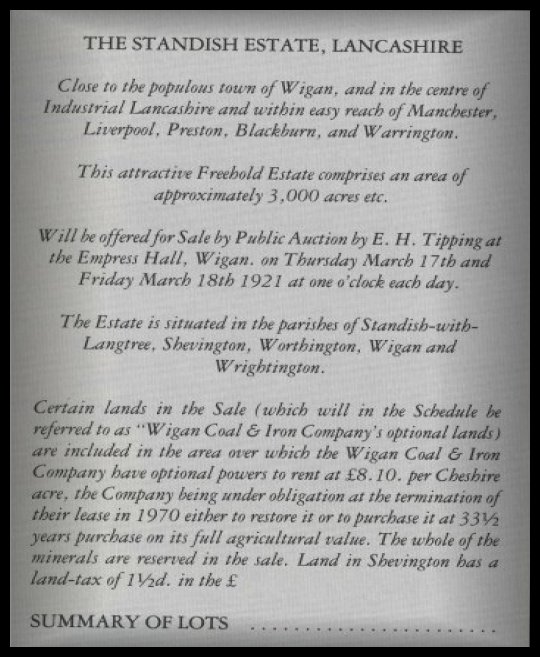
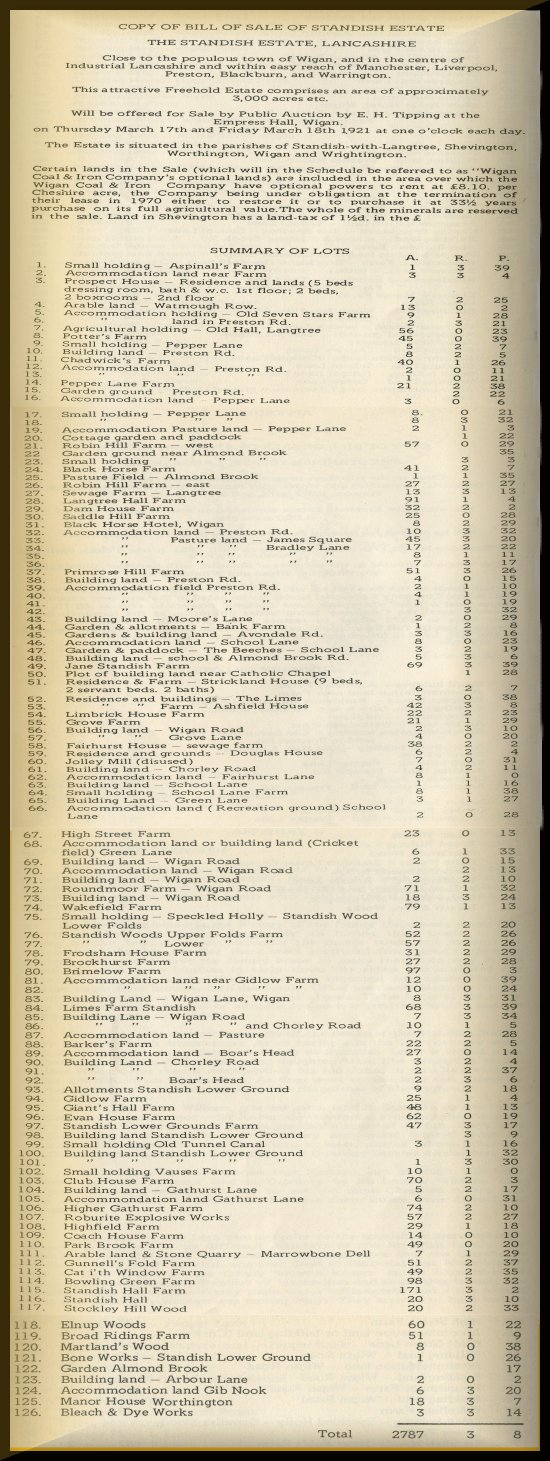
.![]()
1921
How did the United States of America lose the Baronial Hall of the Plymouth Rock Star?

Who Owns the Plymouth Rock Stars Real Estate?
In 1921 an American entrepreneur purchased the ancient Tudor wing including the old chapel of Standish Hall plus all the Halls oak paneling from the final remains of the lands and property of the Standish dynasty.
In the year 1190 the first Standish of Standish Radulphus commenced building his property empire and establishing a family that would ultimately produce Myles Standish one of Americas founding fathers. The English male line of the Standish of Standish family died out in 1755 on the death of Ralph Standish and he was succeeded by his only daughter Cecilia, whose descendents kept the remaing parts of the Standish estates in financial order until theline died out completely in 1920.
At this point the old hall of Standish in Lancashire England together with its lands were put onto the open market for sale. The estate was ultimately sold. The American entrepreneur negotiated the purchase of the ancient Tudor wing of Standish Hall including the old chapel plus all the Halls oak paneling for transportation and erection in America between 1921 -1923 the American owned section of the hall was carefully taken down all parts numbered and then dispatched to the United States of America. At this point a mystery arises as the American entrepreneur together with his bought and paid for section of Standish Hall disappear into the great wilderness of America never to be seen again. Perhaps some unsuspecting American citizen will one day realise that they are sitting in the baronial hall of the Plymouth Rock Star.
below - The ancient Tudor wing and the old chapel of Standish Hall.
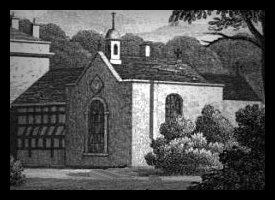
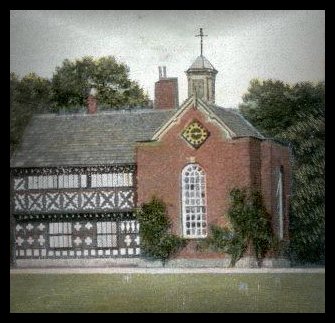
Tudor wing and the old chapel of Standish Hall dispatched to the USA.

The remaining section Standish Hall after the removal of the Tudor wing and the old chapel.
Between 1921 and 1923 the chapel and the old Tudor part of the house were taken down and shipped to America and it has not so far been possible to trace the present location of Standish Hall in the USA. The third storey of the remaining Georgian building was removed; also a wing has been added and two dwellings were created out of what was left.
![]()
2009 The Standish estate.
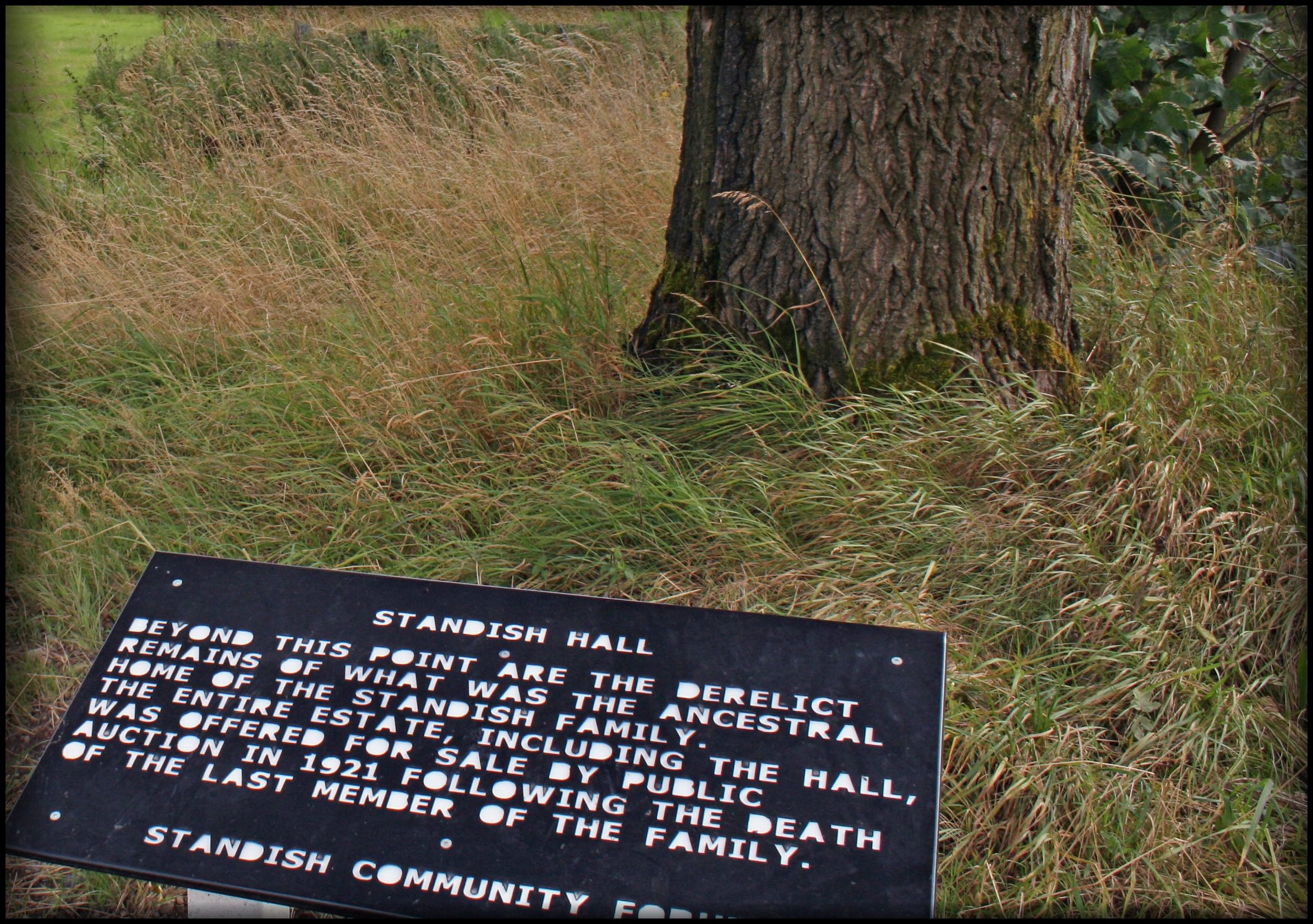
Site of Standish Hall.
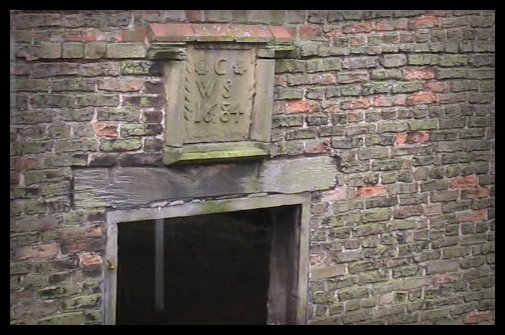
Old Farm building built in 1684 by William Standish.
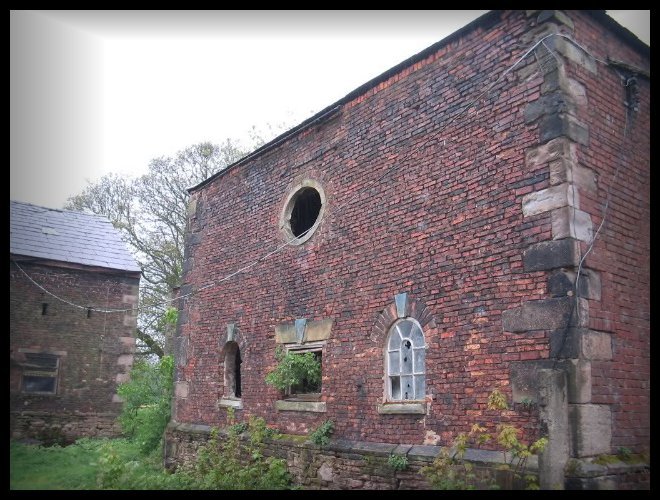
Old Farm building built in 1684 by William Standish.
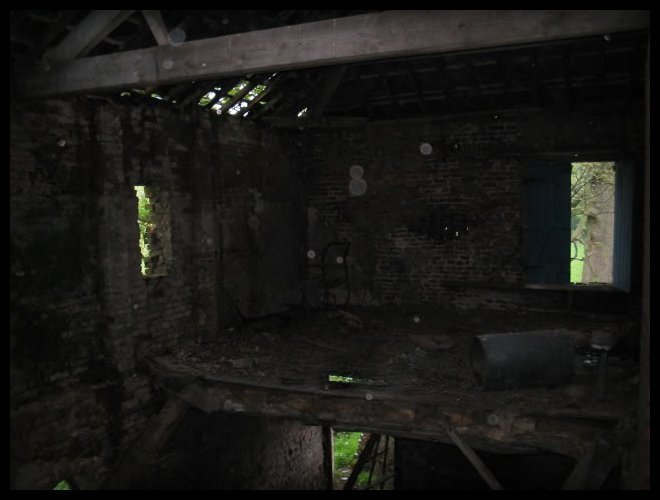
Old Farm building built in 1684 by William Standish.
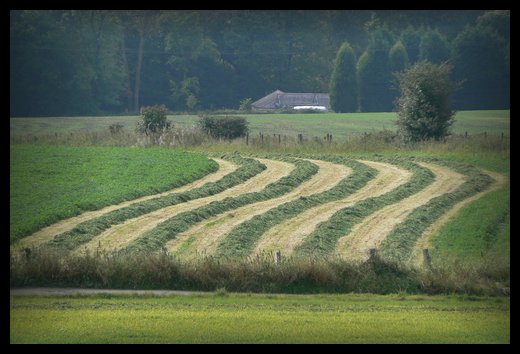
The Meadow's of Standish Manor Summer 2009.

The Meadow's of Standish Manor Winter 2009.
![]()
1942 - 2006.
America's Finest on the Myles Standish trail.

USA. Base Air Depot 2.
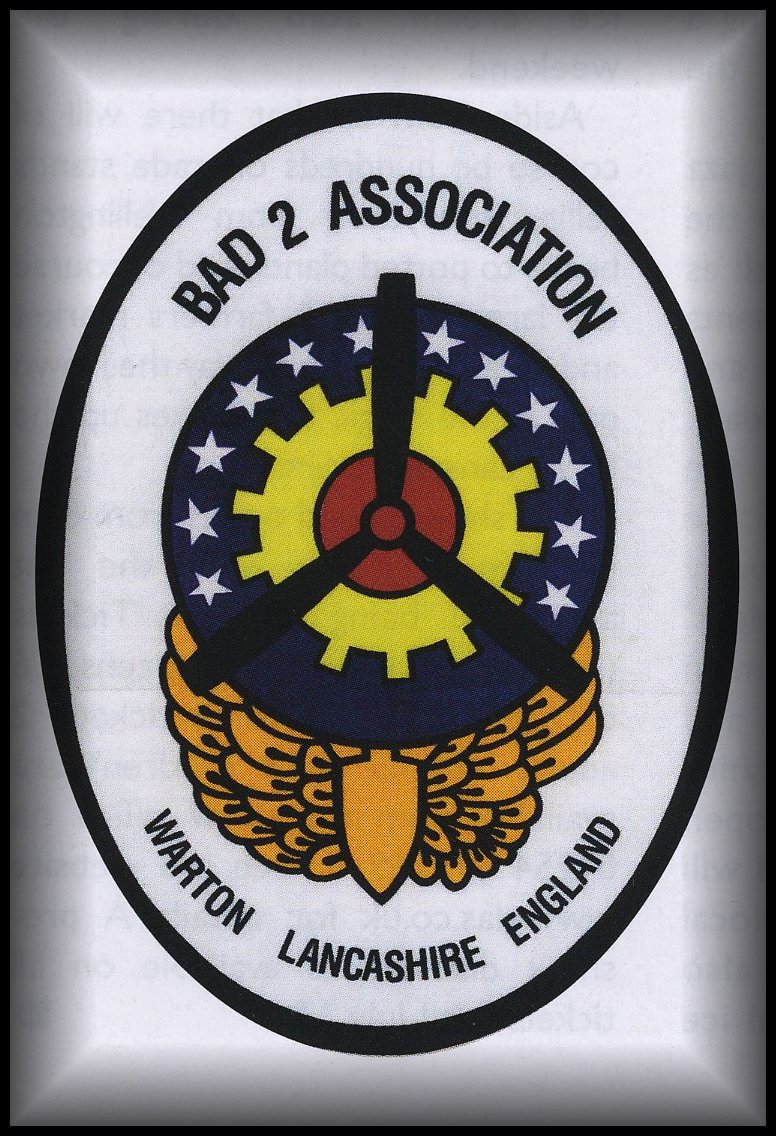
American forces were based at Warton, Preston and Washington Hall, Chorley, Lancashire.
American soldiers would march from their base at Washington Hall, to the Parish Church of Chorley - St Laurence, to attend Church services.
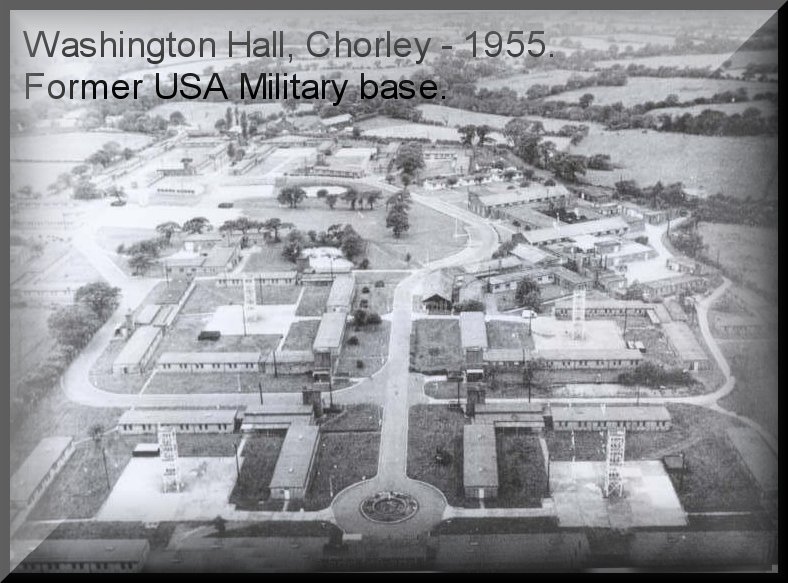
WashingtonHall.
Originally acquired and developed as an accommodation centre for the workers at the Royal Ordnance Factory on the outbreak of World War II, it was never required for its intended purpose. In 1942 it was home to the 127th Replacement Battalion of the United States Air Force, who further developed the buildings. The American troops gave the centre its name of Washington Hall because the land forming its North West boundary was at the time called German Lane, which they changed to Washington Lane.
Between 1946 and 1948 the centre became home to repatriated troops from Japanese prisoner of war camps to recoup and rehabilitate. In 1948 the centre became the property of the Ministry of Education to use as a teacher training collect to retrain teachers returning from service with the armed forces.
From 1954 to 1958 the centre accommodated the training of Royal Air Force mobile fire columns as part of a Ministry of Defence emercency programme. The Auxiliary Fire Service continued the use of the centre until 1964 when the premises were purchased by Lancashire County Council as the Fire Service Training School.
2006. Parish Church of St. Laurence, Chorley, Lancashire.
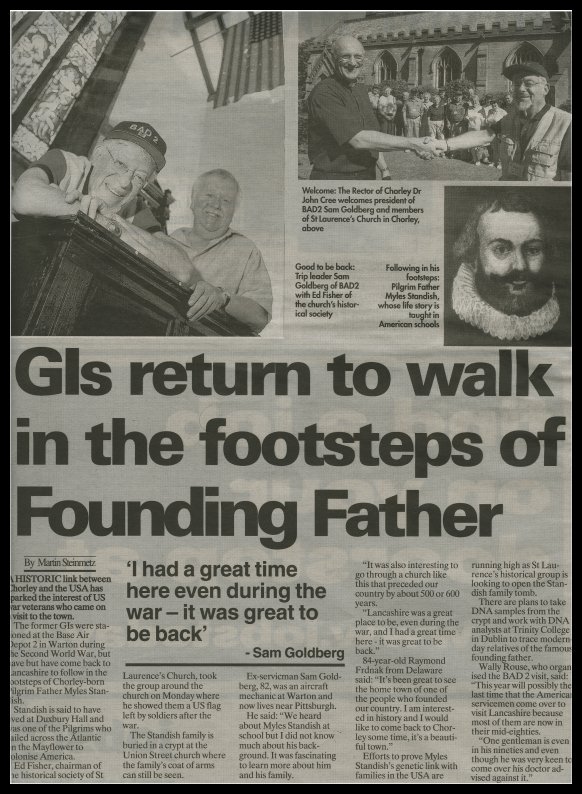
Warton, Preston .
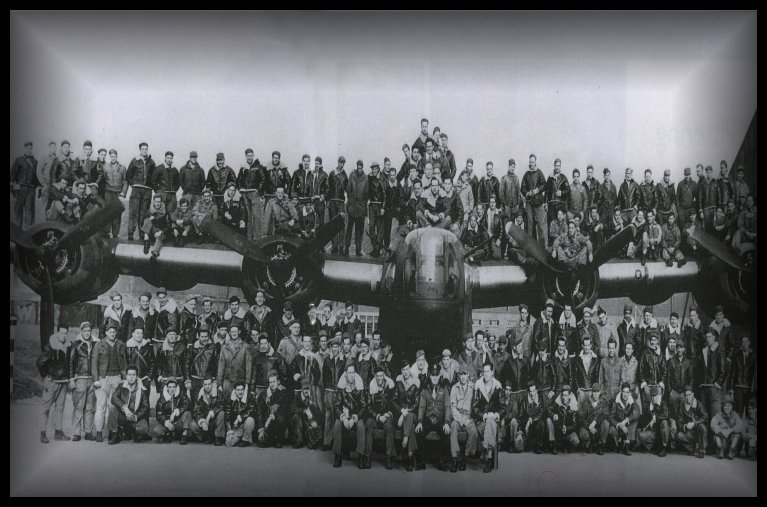
American forces at Base Air Depot 2 - 1943.
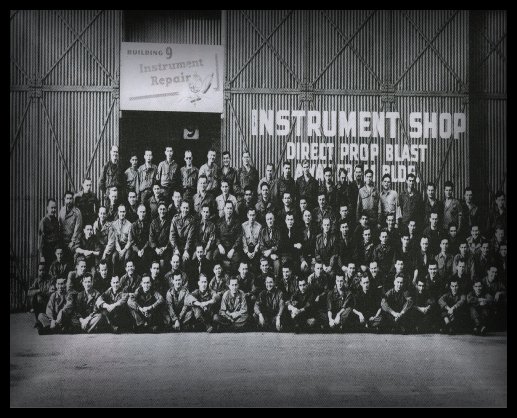
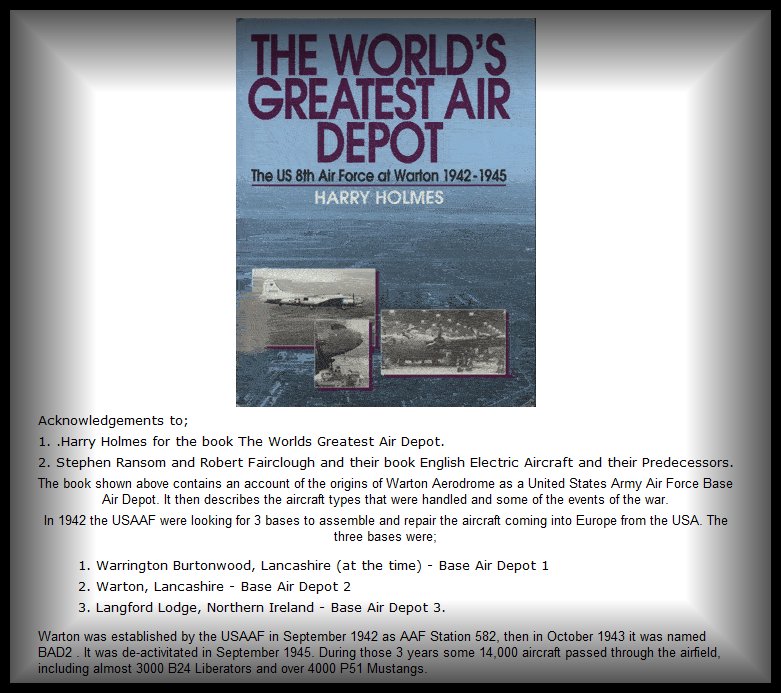
![]()
Eleanor Johnson -Author - The Standish Family 1972.

Eleanor Johnson's book "The Standish Family" remains the most definitive and unbiased account of the history of the Lords and Lady of the Manor of Standish.
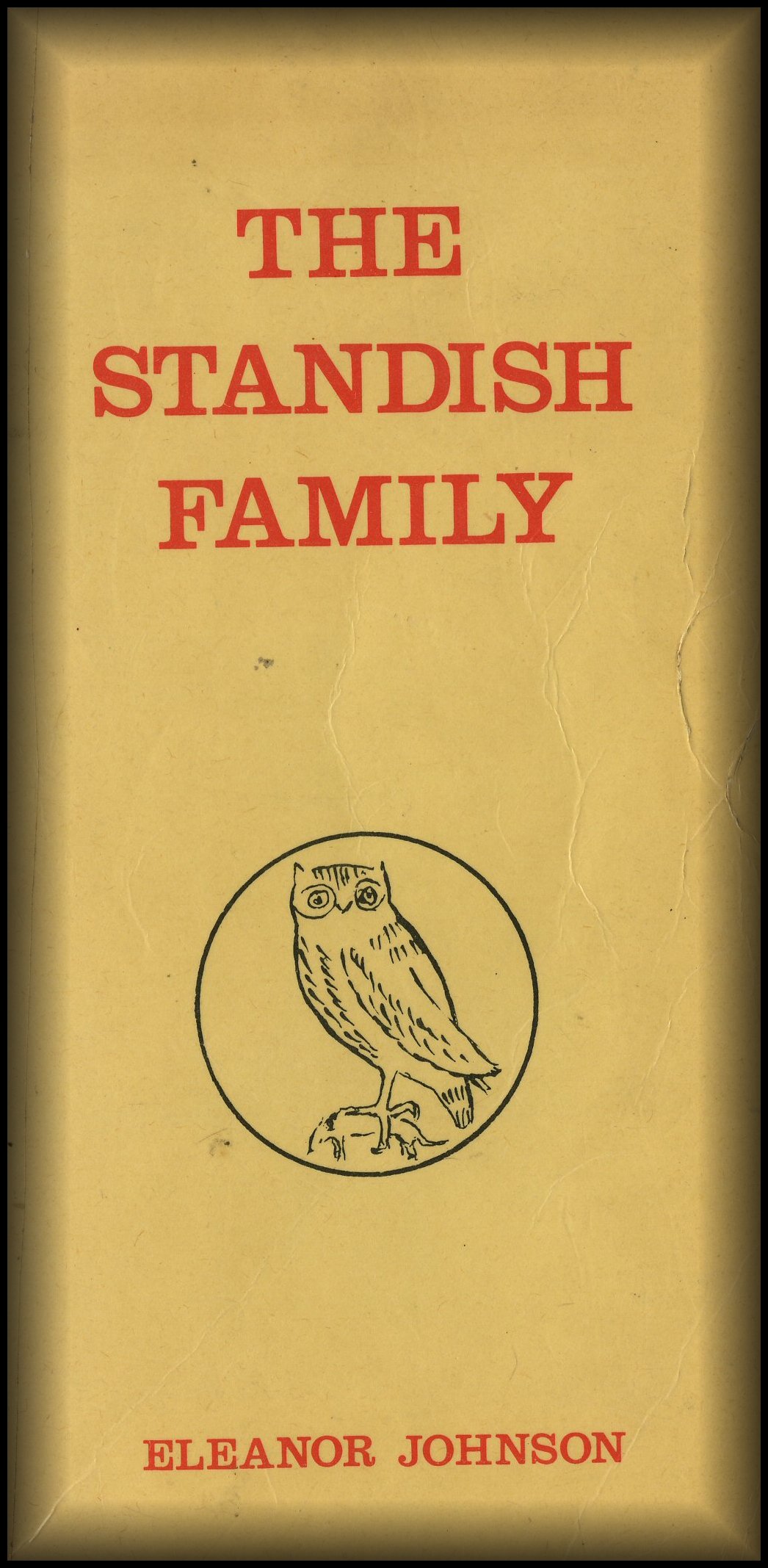
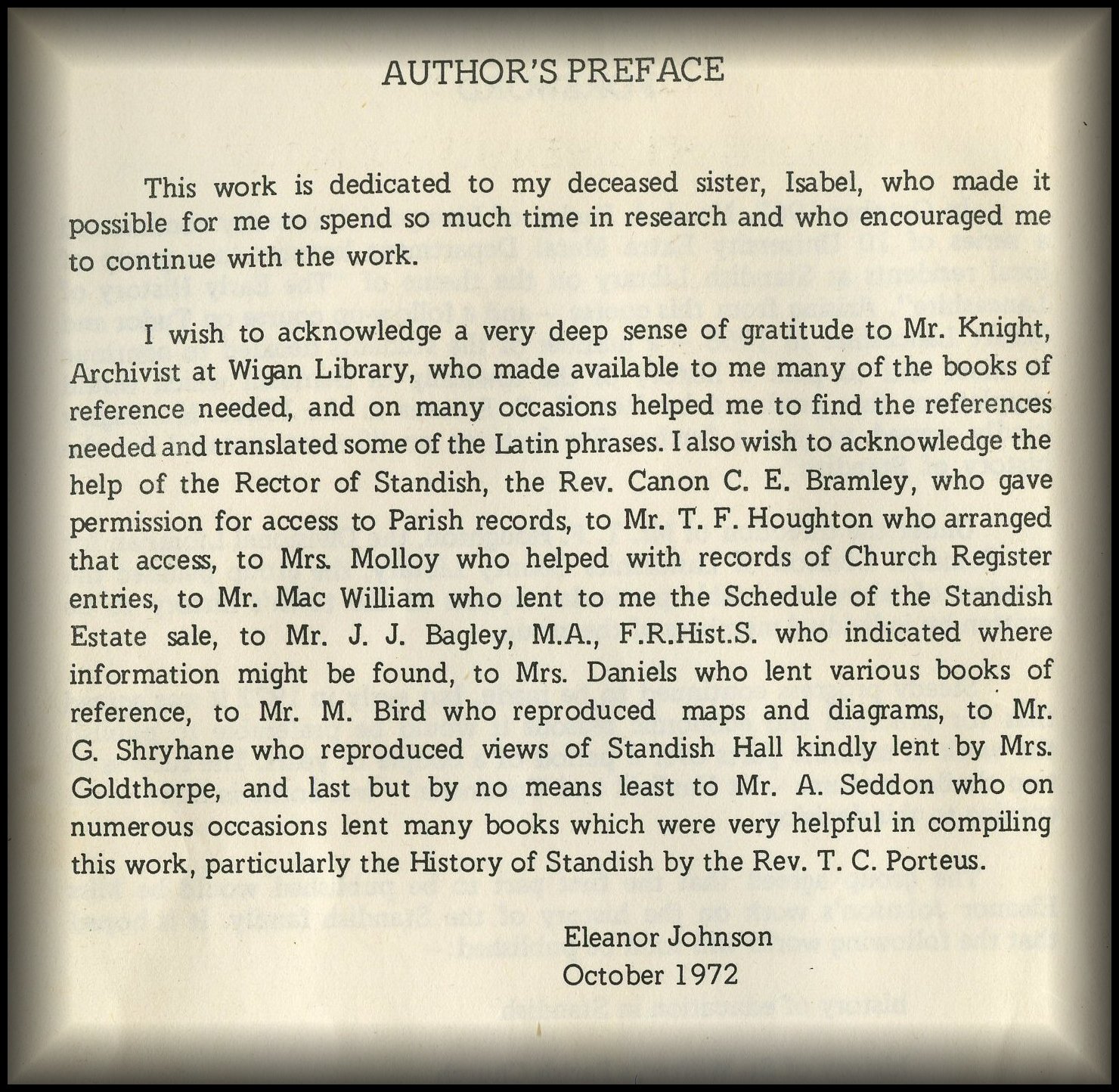
![]()